
























are

for more than


via a




























are

for more than


via a


We have been on our digitisation journey, as an industry, for… almost 20 years now?




That’s how long ‘fintech’ and ‘digital’ have been part of the financial services lexicon; since we started working with the new ideas that came with those terms.

New business shapes. New tools. New ways of working. New ways of engaging. Nearly two decades since we started staring into the work ahead and the magnitude of the task with varying degrees of enthusiasm.
During this time, the economy has become digital and industries all around us have transformed. And faster than we expected.
FS has changed, too, for sure. We have done a lot of things really well – and, frankly, we don’t celebrate those enough. But we have also done a lot of things less well, mostly for want of trying hard enough or in the hope that if we answered the smaller
questions, it would ward off having to address the big ones. Which it did not. And so here we are.
Now, it’s time for us to double down on those; addressing the things we have not done well. And do better. Fast. Because there’s a lot more coming down the pipe. With Web 3.0, defi and the increasing maturity of the technical arsenal at our disposal, is ‘digital’ even one thing anymore? Was it ever? How does thinking about AI, the environment and the needs of SME customers fit into one set of priorities? Into one head? We have done a lot of things really well and we don’t celebrate those enough. We have also done a lot of things less well
Well, it has to because if you want to play in this space, you need to understand it. Nobody said it would be easy. But the doing … that part doesn’t need to live with one person or with one team. In fact, it can’t. That world is gone (assuming it ever really existed). Multiple teams and multiple organisations need to get on with it now and at the same time.
Because digital is no longer a contained thing. It is the very fabric of the economy. We have some awesome contributors to this issue. Though their reflections and observations, we celebrate the distance our industry has travelled so far. We flag the things we need to think about more thoroughly. And we examine the brand new things rushing towards us.
‘Digital’ has come of age. And there’s a lot of work ahead. So read, enjoy, then roll up your sleeves and get on with it.
Did you recognise Issue 24’s spine tingler? “Hello there” – spoken by Jedi Master, Obi-Wan Kenobi played by actors Alec Guinness and Ewan McGregor.











Banking Circle’s proprietary technology enables Payments businesses and Banks of any scale to seize opportunities, compete and grow. From multi-currency accounts to real-time FX, international payments to local clearing, we’re quick, low-cost, and secure.










Bypass old, bureaucratic and expensive systems and enable global banking services for your clients.


bankingcircle.com








Banking Circle solutions are powering the payments for more than 250 regulated businesses, financial institutions and marketplaces, enabling them to gain access to the markets in which their customers want to trade, via a super-correspondent banking network. Here, Jussi Lindberg, its Chief Commercial Officer, explains the approach

“For payments businesses and banks that want a slice of the global e-commerce market, fast, fairly priced payments services that can be easily integrated into their own platforms are critical,” says Jussi Lindberg, chief commercial officer for Banking Circle.

Overcoming a myriad of challenges is key to capitalising on this opportunity. At the heart of these is legacy. There’s also competition coming from new entrants and continued regulatory scrutiny.
“Banks hold a really fundamental ‘trust contract’,” says Lindberg. “They are ideally placed to give their customers better, faster, more cost-effective services.
“The institutions that want to respond to new market opportunities and work in new jurisdictions tell us that they want to do that without diverting focus and investment from their core business.
“Banking Circle is helping banks to create their niche in the business banking marketplace. Collaboration delivers solutions underpinned by fit-for-purpose tech, supported by regulatory expertise. Banks that might have thought ‘that’s not for us’ previously, now realise how we can help them ‘be more fintech’ without putting the ‘trust contract’ they all treasure at risk.
“We are a genuine partner that allows financial institutions to take care of their business rather than get distracted by opportunities that sit outside of their core. Banking Circle and our bank clients work well together on things like tech capabilities; keeping up with regulatory burden and exploring regions and jurisdictions where they might not be prevalent, but still want to be able to offer a service.
“Banking Circle is almost like a sandbox to test out new propositions, opportunities, markets and jurisdictions. Our regulatory experience and tech capabilities complement banks’ own. Plus our payment rails for 25 currencies and 24/7 liquidity give financial institutions confidence we can handle significant volumes.
“We’re also giving banks a future view. This is particularly important in the area of regulation, whether it’s understanding what’s coming next or having knowledge about new jurisdictions they want to enter.”
Another area where Banking Circle is helping banks is de-risking. Larger banks that serve the smaller Tier 2 and Tier 3 institutions with correspondent banking Banks that might have thought ‘that’s not for us’ previously, now realise how we can help them ‘be more fintech’ without putting the ‘trust contract’ they all treasure at risk services, have found themselves with little choice but to de-risk entire regions, sectors or individual partners. The knock-on effect is that medium-sized banks have seen their correspondent banking partnerships under threat. Small fish in a big pond, the lack of buying power means they find it harder to create a competitive
proposition they can confidently offer to their customers.
Research that Banking Circle released earlier this year found that more than three-quarters of Tier 2 and Tier 3 banks had seen their number of correspondent banking partners rise over the past decade: 65 per cent said they think they have too many banking relationships.
“We have the conversation about de-risking with almost every bank we talk to,” explains Lindberg. “Banks are spreading their own risk by working with a greater number of correspondent banks. But more relationships mean more internal resources to manage these partnerships. It also means additional costs, which, inevitably, pass on to the end customer as well as undermining profitability.”
For banks wanting a slice of the cross-border payments opportunity, without having to worry about legacy infrastructure or risk holding them back, Banking Circle has built solutions from the ground up. The fact that the provider is working with more than 250 financial institutions across the globe is evidence of how it is delivering solutions that are the right fit for the market.
“A number of banks and non-banking financial institutions (NBFIs) are already benefitting from the investment in innovation, accessing fast, fairly priced payment services that can be easily integrated into their own platform,” concludes Lindberg. “With a clear approach to support global finance – not de-risk – our clients trust us, so that their customers can trust them in return.”
Supportive approach: Banking Circle is helping traditional institutions ‘be more fintech’


Jussi Lindberg joined Banking Circle in 2022 and is on a mission to tackle financial exclusion. Having worked in global payments and e-commerce for more than 20 years, he has extensive experience of the empowering role of effective, fit-for-purpose solutions. He has held roles in some of the industry’s leading businesses, most recently as senior vice president of business development at Adyen, where he helped elevate the company to become one of the world’s leading payment platforms.
Prior to Adyen, he was at PayPal and eBay, working with hundreds of enterprises to drive growth and improve digital performance.
He is now applying his vision and experience to the new role on Banking Circle’s executive board, helping financial institutions capitalise on the universal benefits of a financial ecosystem that operates in a network of collaboration.
Banking Circle is a fully-licensed, next-generation payments bank designed to meet the global banking and payments needs of payments businesses, banks and marketplaces.
Through its API, it delivers fast, low-cost global payments and banking services by connecting to the world’s clearing systems – enabling its clients to move liquidity in real time for all major currencies securely and compliantly.
The bank processes more than six per cent of Europe’s B2C e-commerce payments flows, equating to more than €250billion in 2021 alone.


In Identity, believes we’ve reached a reset moment –one that could democratise access to critical services. But it will require collaboration
The phrase ‘identity is the new money’ can be attributed to Sir James Crosby from his report on Challenges And Opportunities
In Identity Assurance, published in 2008. It has also been popularised by identity expert David Birch, who published a book in 2014 and a newsletter this year, under that title.
I come back to the phrase often for a number of reasons: firstly, it’s short and pithy, which are the key ingredients for regular re-use in my opinion. And, secondly, because it has only become more apt and accurate as the years have gone by. So much more of life is lived digitally and remotely, and that shift has led to a huge increase in identity-based transactions (and I mean transactions in the broadest sense, not just financial).
Digital identity is, effectively, a digital representation of an individual, and is a set of attributes that can be authenticated unambiguously through a digital channel to unlock access to critical services.

However, according to the World Bank’s ID4D database, almost one billion people lack a legal form of identity and a further 3.4 billion have some form of legally recognised ID, but limited ability to leverage it in the digital economy.
Advances in technology, decreases in implementation costs and increases in internet access and smartphone ownership, have coalesced into the optimal environment for digital identity to finally flourish. So, have we made progress? Well, yes, because we didn’t have a choice. A certain black swan event forced our hand to make digital identity a functioning reality. The question now is what’s required to make good on the opportunity the pandemic presented us with? Necessity drove innovation, but what should happen next? The answer is collaboration, but collaboration on a scale that is not often seen outside of times of crisis.
Governments worldwide are pouring time, resources and money into developing digital identity systems to allow citizens to easily prove who they are to access digital services; while the private sector is accelerating towards being made up of digital-first organisations. In the UK, we’re seeing cross-departmental collaboration in government to drive the One Login initiative, which aims to provide a single account for citizens to prove their identity and access central government services. In the US, Apple is working with a number of states (starting with Arizona) to allow iPhone users to add their state-issued drivers’ licences to their Apple Wallets. In the EU, the European Commission has suggested the creation of a digital ID wallet (in the form of a smartphone app) that will allow EU residents to access public and private services. Such initiatives all have collaboration as a founding principle and key tenet of their success. But we can’t ignore the proverbial elephants in the room.
Firstly, for all this talk of opportunities, we must acknowledge the risk associated with digital identity, and I think that is three-fold.
The fraud risk. The shift to online transactions has increased the attack surface for criminals, and we’ve seen huge increases in identity fraud, with 79 per cent of global organisations surveyed by the Association of Certified Fraud Examiners stating they’d seen an increase in the levels of fraud since the start of the pandemic.
The security risk. As with all digital technologies, the risk of breaches and/or failures of technology is ever-present. With mass adoption, the potential security risk is further amplified.
The privacy risk. Inherent in digital identity is the requirement to have personal data about an individual. And its collection, storage and use can lead to privacy violations, data misuse and an erosion of trust on the part of the consumer.
While there are technical solutions for some of these risks, others are behavioural and will require robust legal and regulatory frameworks to protect consumers and provide adequate government oversight.
The second elephant in the room is exclusion. At Women In Identity, we look at the risk of further excluding parts of the population through digital identity system implementation. We know simply digitising existing processes will do nothing for those who already struggle to access services. Digital identity solutions are an opportunity to fundamentally rethink access, offering many routes, and ensuring they have parity.
The true value of digital identity will be realised when individuals can transact as citizens and consumers with equal ease, using the same credentials to access all digital services – whether that’s government, financial or otherwise. The only way this becomes a reality is through true cross-sector collaboration.


The UK has become a honeypot for financial fraud, and romance scams in particular. Cecilie Fjellhøy is using a painful experience to drive change, while Feedzai’s Dan Holmes says banks need to step up

If you’ve been keeping an eye on Netflix’s greatest hits, you’ll be familiar with Cecilie Fjellhøy, star of the sensational The Tinder Swindler documentary.
She was caught in an unbelievably complex international online dating scam that saw her defrauded of hundreds of pounds by a playboy hoaxer that she’d had the misfortune to swipe right on – as had, so it turned out, two other women.
Convinced by his jet-setting lifestyle, lavish gifts and impeccable taste, the woman fell head over expensive heels for the purported heir to a diamond fortune – except the family rocks were a fantasy, and each of his victims was footing the bill for his serial seductions.
The story ricochets from penthouse suites to prison stays, heady romance to threats of violence. It is a true-crime rollercoaster that will keep you on the edge of the sofa.
Fjellhøy, a UX designer living in London at the time, was victim of a crime for which the UK appears to be the unenviable capital of the world. A recent report from UK Finance claims that 40 per cent of all those looking for love online have been asked for cash.
In the eyes of Dan Holmes, a financial fraud consultant working for Feedzai, an AI-driven technology company focussed on developing financial crime-fighting products and services, the displacement of fraud to the world of dating and other platforms is partly due to the effectiveness of anti-fraud precautions introduced by the banking industry.

“If you rewind back to 2016/2017, the primary threat that the banks were facing were what we call ‘unauthorised fraud attacks’ – finding a way to compromise a victim’s credentials and using these credentials to perform unauthorised spending. Banks reacted to that, and
there was wide adoption of a whole new array of fraud technology – like device recognition, location analysis, malware detection and behavioural biometric capability – which allowed banks to get a really strong grip on those unauthorised fraud attacks,” he says.

But once online banking systems brought in methods to clamp down on unauthorised use of accounts, it was inevitable that fraudsters’ focus would change. “Rather than the bank’s fraud ecosystem and defence mechanisms being the weakest part of the chain, the fraudsters realised that, actually, the weakest part of the chain now was the victim, the customer themselves.”
‘the card is blocked’, and every time the card was blocked, that meant he was in danger. At the time, I was more fearful of him losing his life. That is how you get brainwashed. It felt like a bad movie.”
She applied for loan after loan, using legitimate, procedurally appropriate and financially approved methods, and transferred those loans to him by her own hand. It’s part of the reason that he’s proven so hard to prosecute.
That was certainly the case with Fjellhøy. Her UK bank account wasn’t compromised, but her trust in others was exploited. As a romance scammer, the perpetrator used tactics that talked to her heart, not her head – claiming he would be in physical danger from criminal gangs if she didn’t help him out financially.
“Back in 2018, I had just moved to a new country, had no family there, few friends, and I met this guy who was promising me this future,” Fjellhøy says.
“I was soon to be 30… it was love bombing. Looking back on the messages between us, it’s ‘I’m stressed’, ‘I miss you’,
First cut is the deepest: Financial crime has ‘devastating financial, wellbeing, social, and emotional impacts’

Technology is in place to discern unauthorised from legitimate transactions, but all that is rendered ineffective when the victim is authorising fraudulent transactions on behalf of the fraudster. Holmes believes that in developing the ability to accurately assess authorised transfers, banks have become experts at detecting just one type of fraud, but ‘in the process have almost been a victim of their own success’.
So, if the very advances in fraud detection and prevention have left user vulnerabilities exposed, how do financial firms evolve their procedures and technology to close the gaps? Part of the answer lies with a holistic approach to anti-fraud protection measures inside the bank, believes Holmes.
In his view, the progression from branch to card-based transactions, to online banking, to mobile banking has been a neat evolution in consumer finance access, but one that is too siloed to be as effective as it could be.
funds, is key. There’s been a lot of talk in the industry recently around what more can be done to A) reduce the amount of mules that come on board at the front end, and then, B) clean-up the bad accounts from a bank’s book. Ultimately, if you can stop the mules, you stop the fraud.
“If we use Cecilie’s scenario, her bank does all the fraud monitoring on that side. But what a receiving bank doesn’t tend to say is ‘does this inbound transaction look normal for that account?’. There’s more we can think about, as an industry, from that perspective, as that’s, ultimately, where the point of compromise is in the scam.”
Having worked in a digital design environment and user interfaces
specifically, Fjellhøy has been vocal about not just how banks should have been able to spot her unusual financial activity, but also how they should communicate with someone they suspect of being a victim of an ongoing fraud.
situations, is in the minority in owning up to having been conned. Even so, there’s very little justice out there. The UK Parliament’s Treasury Committee on Economic Crime, reporting earlier this year, said fraud wasn’t seen as a policing priority.
It all raises uncomfortable organisational and ethical questions for banks. How do you discern harmful and anomalous spending patterns from unusual but harmless purchases? How do you talk to customers supportively about major changes in their spending habits? And all without being a major drain on your workforce?
For Holmes, solutions like Feedzai’s provide an evolved approach to protecting customers like Fjellhøy.
“We’re involved in consolidation of fraud transaction monitoring across the user lifecycle; so not thinking about the user as a card number, a user ID, or a telephone banking number, but as a holistic
“In Cecilie’s scenario, you’ve got one decision engine for lending, another for cards, another for transactions made in online banking, another for events in a telephony channel, and there’s no interactivity between all of these different silos within the bank.
“It sounds rudimentary, but even things like a lending decision, followed by a full payment out of that lending amount that you’ve just borrowed… if there’s no interactivity between those data sources, then it’s very hard for the banks to recognise it,” says Holmes.
And, in his opinion, there should be just as much focus on where the money’s going as where it’s coming from.
“Whenever a fraud happens, somebody is sending a payment from their account to the fraudster’s account; the fraudster’s always got to have control over that beneficiary. So, having a network of ‘mule accounts’, which are essentially the accounts that receive the fraudulent
It was a very clear change in my behaviour… But all the transactions that I did weren’t viewed as a whole Cecilie Fjellhøy, action:reaction Foundation


“It was a very clear change in my behaviour,” she says, “taking up so many loans, suddenly travelling all over the world, business cards, expenses of £60,000 in less than a month. But all the transactions weren’t viewed as a whole.”
It’s estimated that only 15 per cent of victims even report fraud – many are too ashamed or, rightly in most cases, don’t think there’s any chance of getting it back.

Fjellhøy, who’s left her job to set up the action:reaction Foundation to support people who find themselves in similar
user where we can understand what they’ve done, regardless of what channel they’ve executed it on.”
The ultimate vision for this is that banks collaborate and make the connection between potentially fraudulent transactions to build an understanding of what’s really going on. It’s a solution that Holmes believes is best understood by looking at the aviation industry.
“If there’s an accident in aviation, the whole industry comes together to understand what happened, and then they will push fixes out to their respective fleets, to better protect all air travellers. That doesn’t happen in the banking space today. A bank will realise there’s been an attack, it’ll fix it, but it won’t necessarily share that intelligence.”
A holistic approach would also trigger a more detailed, personalised assessment of a potentially fraudulent situation through conversations informed by the identified risk level.
Holmes explains: “It needs to turn into ‘have you done this transaction because somebody has asked you to do it? Have you had a call, out of the blue asking you to send them money? Has somebody approached you on social media, and now they’re asking you to do this?’. That’s a very different, more informative discussion for the bank to have with its consumers.”
And it’s one that could perhaps have prevented Fjellhøy from racking up more than £200,000 of debt.
“The call with the bank was never a long conversation regarding the total spend – just these individual ones,” she says. “Sometimes, I only got a text message. ‘Do you approve this transaction?’ The first company that I had a credit card with, realised after a while that I wasn’t the one using it. And that was good. So they blocked the card, and then they reached out to me. But because I was so scared, because I had lent him my credit card, I felt ‘now I’m the one who has done something I shouldn’t have and they’re coming after me.’
“When they contacted me, unfortunately, I was with the fraudster and he made it feel like it was us against the world. Fraudsters can make you scared of the good people.”
Holmes argues that biometric technology could have raised a red flag had it been employed by the bank.
“You can start to tap into emotions within voice biometrics… for example, ‘yes, this is Cecilie, but can we tell from her voice patterns that perhaps something’s not quite right, relative to what we normally expect to see from her?’. I’m not saying this is a silver bullet, but it’s a step further to better protecting the consumer.”
It seems that a cultural and educational shift will also be important if the UK is to bring down its estimated £3billion fraud bill, where losses suffered per person are higher than in the US, Canada or Australia.
Information campaigns have their role, but, as Holmes says: “It’s difficult to see an advert on Saturday evening, and then recall all that information when you get a call from the fraudster on Thursday.
“But if the bank presents something to the customer at the point of material risk, when they’re about to make the payment, does that force them to remember that advert and say ‘is this a little weird?’”
A national 159 help line was launched across the UK by a number of banks last year, giving consumers an invaluable
opportunity to discuss the specifics of any transactions they’re about to approve. Individual banks have also instituted their own hotlines, including Nationwide, with what it calls ‘increased friction’ to slow transactions identified as fraudulent, so consumers can seek reassurance before their payment is too late to stop.
Fjellhøy believes that counselling and discussion has a big role to play in averting future crime as well as removing the shame associated with it.

“It’s so important to support fraud victims, so they can go to the banks and tell them what happened. We need to remove the stigma, so people aren’t worried about
many of these scams. Simultaneously, the second Economic Crime and Corporate Transparency Bill will enable businesses in the financial sector to share information more effectively to prevent and detect economic crime and allow banks to slow down instant payments if they’re suspicious.
Fjellhøy realised that, in the end, she was never going to get any of her money back. And yet, four years later, the perpetrator is still out there. And, in an ironic twist, Fjellhøy’s attempts to help victims of fraud has itself been exploited by fraudsters.
“There are a lot of fake accounts out there now, pretending that they’re me, trying to defraud people by using my story,” says Fjellhøy. “I get a lot of scam victims contacting me for help and these fraudsters are talking to my followers, saying, ‘if you give us such and such, we can get your money back’. And yet, when I try to have these accounts shut down, the response I get is that the social media platforms receive so many reports, they don’t have time to remove them. There is so much more that institutions – tech companies, not just banks – can do.”
Holmes agrees that more effort needs to be put into bringing ‘different parts of the “kill chain” together to work more effectively as a collective’.
being judged – so they can say to each other ‘I fell for this, and I clicked that link’. I think it will be better for everyone if we were a bit more open and it would be more difficult for the fraudsters to flourish.”
A recent report from Transparency Task Force, a social enterprise group that campaigns for greater transparency in UK financial services, found financial crime had ‘devastating financial, wellbeing, social, emotional and support-related impacts’ and called for reform of the regulatory system and better support for victims.
And there is evidence that banks are beginning to see fraud less through the prism of the P&L and more as a social harm: consumers have had their lives ruined because it’s not possible for them to get lending again, or to take out mortgages. Meanwhile, some consumers have lost their pension pot.
The UK’s Online Safety Bill, meanwhile, proposes to place a duty of care on online platforms like Tinder that are channels for
“Bringing the telcos, the tech giants, the internet service providers, and the banks into a room together, for them to all work more effectively around how they can better protect their respective countries’ consumers from scams, is something that I’d like to see more of.
“I think there are four key takeaways for me, when it comes to better protecting consumers. First, use the right technology – yes – but use layers of the technology. One piece of the kit isn’t going to solve this.
“Second, educate your consumers, to the best of your ability. Do this frequently, do it at the right time; give them the best chance to recognise that something’s happened, so that even if your technology fails, they still potentially get to stop it.
“Third is collaboration, not just across the banks, but all the parts of the kill chain.

“The final one is make sure that whatever authentication strategy you have, whatever conversations you have with customers, reflect the risk that you suspect is in play.
“If you can nail those four things, while you’ll never solve the problem, you’ll give yourself the best chance to limit it.”
The bank will realise there’s been an attack, they’ll fix it, but they won’t necessarily share that intelligence Dan Holmes, FeezaiMatters of the heart: 40 per cent of those looking for love online have been asked for cash


If you see compliance simply in terms of technology, you’ve missed the point – and the power – of transformation, argues Livia Benisty, Banking Circle’s Global Head of Business AML



Fintech has changed financial services. It is a cultural as well as a technological shift. By focussing on the customer and challenging the traditional tech stack required to offer financial products, companies have redefined what people should expect of banks and others offering financial services.
Cloud-based has become the new norm, with traditional banks involved in lobbying more conservative regulators and investigating how to best transfer over. Deals are won and lost on the quality of API documentation. Smart phones, in countries where widely used, are not only the core means through which services are accessed (in the case of retail products) but also our main source of authentication. Web 3.0 will likely revolutionise these changes all over again. And it seems like quite literally everything now has to use AI (even if it doesn’t).
However, for all the advancements we’ve made, there are some ways in which we’ve barely changed at all. Throwing technology at a problem while fundamentally thinking about it in the same way, doesn’t solve that problem, it just hard codes it. One could argue (and I would) that we’ve been so focussed on the product, so obsessed with calling ourselves ‘innovative’ and executing at speed, that we’ve not accounted for the need to embed processes, culture and mindset for continuous change.
Doing things with new technology is not enough to truly do something in a new way; that is the path to us all being the dinosaurs of the future. If we do not consider every element of the company as part of the change we are trying to create, we will be right back where we started: with everything taking forever, demotivated and burnt-out staff, and second- and third-line functions ‘slowing things down’.
While I believe this is the case for several teams, the core of my experience is in AML (anti-money laundering). Long considered a business prevention unit, fintech founders have pushed heavily for efficiency and cost gains in this area. The incredible rise of fintech has meant a parallel market for regtech has blossomed, with this segment raising nearly $19billion in 2021.
The number of solutions on the market would have you believe that every part of regulatory compliance can be automated, with data analysed in nano-seconds, likely by an AI-driven solution that can also make your coffee and sort your love life (assuming a clean data lake, infinite budget and a team of engineers dedicated to this, rather than building product you can actually sell).
One of the most advanced (and money-making) areas of regtech is AML/financial crime. It’s understandable; time to onboard is key to the user experience, fraud losses are expensive and, for the amount spent, knowing that 95 per cent of transaction monitoring alerts are false positives is deeply frustrating for any executive. We have an increasing array of choice when it comes to the technology we can implement to help solve these issues, and fintechs have adopted it in droves.
Of course, the need is real. Much of regulatory compliance consists of data collection and storage before being able to analyse and mitigate risk. Automating collection and being able to analyse vast quantities of data holds huge potential for efficiency gains, improving the customer journey, increasing employee motivation and satisfaction and, of course, improving compliance.
And yet, we continue to organise and treat these teams much as we did
15 years ago. Rather than bringing AML into early-stage decision-making and design, at best we hand over a finished version and tell them to enable it. We instruct them to make the best use possible of an architecture centred around a vision for a particular product offering; business requirement documents (BRDs) that have never been considered in the light of regulatory obligations, changing market forces and the motivations of our workforce.
That’s at best. At worst, we forge ahead and worry about it later.
We know we should think about it, hire for it, but we don’t design for it. To truly solve this problem we need to stop thinking that you can throw technology at it, and start to recognise that great AML is the by-product of a sensibly-thoughtthrough tech architecture that has taken into account different perspectives on what scaling could imply, and how to culturally and procedurally embed the ability to change in a regulated environment.
By including AML as part of a company’s digital transformation from the outset, you end up with a control function that is strategically embedded into the future vision of the company and is adequately prepared for it. In some cases, it may even drive it forward. Here’s what I think that looks like.

1 Good AML is an integral part of your organisational and operational design AML and compliance are not a separate function, like an isolated side box on an org chart. When thinking about the tech structure for the AML function and its associated systems, think about the interactions AML would have in the product lifecycle. There will be interactions with sales and business development teams. There will be an assessment of product market fit (e.g. is this customer an appropriate user of the product and what would expected behaviour look like?).
Any use of AI in AML needs good data. There isn’t AML data and non-AML data. It’s not separate. AML will need to use much of what is collected on a client and their activity. For a bank, this is everything that goes through the core banking platform, treasury function, how the lead was generated, pricing negotiations, etc. This can be embedded
early on, preventing large remediation projects and re-mapping exercises.
Before buying AML tech, identify the several teams and systems AML needs to talk to. All these interactions need to be replicated digitally. At the first stage of determining how to set up the tech stack of a bank, AML has a role to play. Every time that tech stack changes, the downstream impact on AML needs to be a core consideration before go-live. These technological interactions need to be mirrored in processes and rituals that integrate these teams and keep them on the same page. Innovative companies will have ideation processes, product design, brainstorming, testing. Regulated entities will need to bring that into governance frameworks, approval processes, etc. If we can design for that early on – creating interactions, rituals and processes that bring the right people to the table at the right time – we foster a culture of openness to change, inclusion and diverse perspectives.
customer journey and commercial objectives in mind. It takes smart people to build those. Only once that is done can you build your tech to make it happen.
First people, then processes, then tech. Otherwise it won’t work.
We have focussed on technological advancement and creating a better proposition. We’ve instigated cultures of execution, drive, speed. We talk about scaling as a skillset. All of this makes sense and has led to huge successes. And yet, we’ve not realised that to avoid being the clunky, legacy incumbents of the future, we have to build in the ability to change. That ability will keep companies nimble and relevant in the short and long term.
When building processes and systems, do we consider what happens if any of our underlying assumptions or characteristics change? Do we hand people the tools for dealing with the implications? I think we unconsciously build in (at least) an element of rigidity that comes back to haunt us.
Being able to execute and scale doesn’t show an ability to enact and deal with change. You can scale a company and change nothing. It’s a short-term win, which, arguably, works for an industry that is increasingly incentivised by investment rounds and IPOs to act with that timeframe in mind. But it won’t lead to ongoing success.
AML is seen as a blocker when ideas for change come to the team late and sometimes second-hand. Advanced warning makes things move quicker; being made part of the decision-making process even more so. Team members do not then constantly feel on edge about what is coming, and this means they can see themselves as enablers, rather than defaulting to a defensive position when their risk appetite is challenged and they feel unable to feed back.
Particularly when it comes to regulated institutions, there are things that have to be done and governance that needs to be in place. Those things might be mandated by regulation, but there are good and bad ways of achieving compliance. Procedures need to be thoughtful, usable and keep the
It’s about a mindset; open-mindedness and a willingness to embrace change rather than fear it. For a team that’s ready for it, the new product releases, new markets and new pieces of regulation mean a simple process of gap analysis; questions to be answered and processes tweaked. For teams that aren’t, it’s a frightening concept that threatens the way we’ve always done it, usually at a time where we are overworked and overburdened as it is.
When we challenged the fundamental way of doing banking and finance, we never took this thing that causes everyone so much frustration and pain and gave it a seat at the table.
We need to go from caring about AML to designing for it; making AML a core, integrated pillar of the digital transformation we are all so proud of ourselves for achieving. Because it will keep being that overburdensome revenue sucker until we do.
When we challenged the fundamental way of doing banking and finance, we never took this thing that causes so much frustration and pain and gave it a seat at the table
2021 was something of an annus horribilis for many unwitting consumers in the UK, with fraud victims conned out of an incredible £1.3billion.
Digging a little deeper into the data, there were 195,996 separate instances of authorised push payment (APP) scams, which saw Brits tricked into handing over £583.2million last year.
App frauds are usually simple but effective; criminals posing as trusted organisations or financial institutions, persuading victims to make a payment in the belief that their money was in safe hands. These scams often use legitimate platforms to reach victims, borrowing the credibility of the platforms and services they abuse.
The harm is, of course, primarily felt by the individual persuaded to part with their cash through fake calls, text messages, social media posts and seemingly legitimate websites. But banks are also impacted – not only if they reimburse the customer, but also by the detrimental affect it has on consumer confidence in their brands.
Add to the mix a steep rise in the number of digital communications and transactions encouraged by the COVID-19 pandemic, and the environment exists for financial fraud to become something of a national crisis. Institutions haven’t been sitting on their hands, though.
What could be described as a ‘fourth emergency service’ was launched in the UK in September 2021, whereby customers who think they might be being scammed, can call 159 for assistance. The secure number connects to the individual’s bank and is a safe avenue for anyone who believes someone is trying to trick them into handing over money or personal details.

‘Call 159’ was introduced by Stop Scams UK, an organisation created in 2020 to help firms ‘protect customers based on

proactive collaboration, and sharing insights and best-practice’.
To date, Barclays, BT, The Co-operative Bank, Gamma, Google, HSBC, KCOM, Lloyds Banking Group, Meta, Microsoft, NatWest, Santander, Starling Bank, TalkTalk, Three, TSB and Nationwide Building Society have signed up to the initiative, covering more than 80 per cent of primary current account holders and the majority of telecoms subscribers.
Trust is key to all banks but none more so than the one that ranks as the UK’s most trusted financial brand, which is regularly in the top two for customer satisfaction. Nationwide Building Society, with 16 million members, has something of a reputational imperative to address the industry’s authorised fraud crisis. Before joining the Stop Scams UK initiative, it had launched its own Scam Checker service, which encourages its members to check any payment they are worried about, either in branch or by calling a 24/7 freephone number. More than 300,000 of them used Scam Checker last year. Along with additional staff training, awareness programmes and investment in its data-handling infrastructure, Nationwide helped to prevent £97million of attempted card and online transaction fraud in 2021/22.
But it has gone further. Its 2022 annual report describes how the Society has also ‘enhanced our fraud detection system for payments, and improved our scam warnings, to simplify them and to highlight social media scams’.
It continued: “We are educating more broadly beyond our own membership, too, and ran national media campaigns on scams awareness. We are also playing our
part to tackle this growing problem by taking an active role in cross-sector working groups, including campaigning for changes around greater data sharing between financial services providers to reduce payments fraud.”
Nationwide’s approach to fraud prevention clearly has data at its heart. Otto Benz, director of payments, says there is an accelerated move by banks to improve payments data, driven not just by changing consumer habits but also by the urgent need for increased security.

“We are definitely seeing a move away from cash and into electronic payment mechanisms, and particularly account-to-account mechanisms, through open banking,” he says. “A lot of the participants in the payments ecosystem – banks, building societies and others – are refreshing their payments platforms and infrastructures, both to support things like ISO 20022 [the global payments messaging standard] and also their own need to improve resilience.” That plays into consumer expectation, particularly in the UK, for real-time payments to be processed quickly and with minimum fuss. But can speed compromise security? How do you ensure that these ‘fast and frictionless’ payments are not fraudulent?
Benz believes that AI can play a central role, particularly when it comes to fraud based on psychological manipulation.
“A lot of the problems now are social engineering issues, where customers are persuaded to make payments to people who seem reasonable at the time. It’s only when they’re interrupted in their thought process and made to think about whether this is something they really should be doing, that these fraudulent payments
The shocking rise in financial fraud is driving UK banks like Nationwide to adopt a new approach, as its Director of Payments Otto Benz explains
Just providing a standard message, asking somebody ‘are you sure you know this person?’, is probably not good enough to prevent some of the frauds we’re seeing
are stopped. And that’s where I think some of the new technologies can really help, because just providing a standard message, asking somebody ‘are you sure that these are the details of your payment? Do you know this person?’, is probably not good enough to prevent some of the frauds we’re seeing. AI can help with specific interventions, and also putting suitable friction into the payment process,” he says.
Benz believes the standardising of electronic data exchange between financial institutions, under the framework of ISO 20022, will also have an impact. Data provides knowledge, with knowledge comes transparency, and this transparency delivers enhanced security.
“Ultimately, payments is a collaborative ecosystem,” he says. “You need to collaborate on what the format is for a payment, and how it’s best enabled. Underneath it all is a demand for more data in the payment itself.
“The ability to track international payments, end to end, with new guaranteed references, through the unique end-to-end transaction reference (UETR) on SWIFT, is a real benefit. Just understanding who you’re sending your payment to should reduce the effort required to check it – through sanctions processing, for example – because the parties will be more easily identifiable.

“All of these things will improve straight-through processing rates and make it easier to detect any potential issues. Just providing the basic facilities to track for individuals and their financial institutions, will help. For banks, too, it will improve accuracy, speed up processing and reduce costs.
“Institutions still need to innovate to make use of all the data that’s becoming available, though,” says Benz, “and it’s still unclear as to how companies will be able to provide that information to their customers. Despite the fact that this has been coming for several years, nobody’s come out with great use cases to leverage this enhanced data. This is still an opportunity for us in the industry, but it’s not ready yet.”
Anticipating these opportunities, Nationwide has invested heavily in improving its technology estate, much of it architected internally. But it also has key partnerships with external providers.
Only recently, it announced a deal with digital transformation company AND Digital, to improve the data experience of users. AND Digital will look to help deliver real-time information across touchpoints, for both Nationwide employees and members – in person, online or on the phone – through ‘optimising work processes and developing bespoke platforms that require minimal technical capabilities of the user’.
Benz believes that financial institutions will have to continue to evolve to cater for an ever-changing landscape. And whether it be countering fraud, delivering faster transactions or simply communicating better with customers, organisations like Nationwide
have, in many cases, embraced the Cloud to improve their offering.
“We, like many others, have inherited technology infrastructure, which ages over time, and it’s very difficult to cater for the changing types of payments, the changes in the international landscape and also the volume of interactions,” says Benz.
The building society recently upgraded to IBM’s z16 mainframe, which is future-proofed for AI applications and cyber-resilient security. It also maximises Nationwide’s technology options, being suited to hybrid Cloud environments.
Nationwide completed its first Cloud-based payments test through PayUK’s New Payments Architecture programme earlier this year.
“We’ll roll that out and build our new payments infrastructure on that Cloud platform,” says Benz, “to leverage the new payment standards from day one.”
To the rescue: Nationwide is taking a multi-pronged approach to protect its members from fraud

SmartStream’s fully integrated suite of solutions and platform services for middle- and back-office operations are more relevant than ever – proven to deliver uninterrupted services to critical processes in the most testing conditions. Their use has allowed our customers to gain greater control, reduce costs, mitigate risk and accurately comply with regulation.
With AI and machine learning growing in maturity, these technologies are now being embedded in all of our solutions and can be consumed faster than ever either as managed services or in the cloud.
Simply book a meeting to find out why over 70 of the world’s top 100 banks continue to rely on SmartStream.

Back in 1956, physicist Hugh Everett’s ‘many worlds’ theory described how the entire universe exists in multiple states – something he termed the ‘multiverse’. Since then, physicists have proposed many types of multiverses, including parallel worlds.


While these co-exist, physics dictates that ‘no communication occurs between them, so no universe is aware of the presence of any other’. It does, however, support the notion that they can collide!
The principle behind the theory appropriately describes how I view the last 13 years of digital change and innovation across financial services –specifically two parallel worlds that have grown under two very different realities: the fintech and crypto worlds.
The ‘big bang’ that accelerated the growth of both these worlds occurred in 2008. Known as ‘The Global Financial Crisis’, its impact spread across all parts of the financial services industry to devastating effect. It caused deep financial losses, mass unemployment and led to the collapse of significant financial institutions, which resulted in the loss of customer trust in the banking system. This event, combined with the fact that banking had not seen real change for centuries and that the wider world was becoming
increasingly mobile and digitally savvy, created the perfect storm for change.


Fintech describes technologically enabled financial innovation that gives rise to new business models, applications, processes and products that have the potential to change financial markets and institutions. So, you might think the term fintech also describes crypto. One only needs to read crypto community forums to appreciate the disdain with which such an association is viewed, some arguing that fintech is merely iterating on the incumbent rails of traditional finance, while crypto is building something brand new and fundamentally transformational.
Such opinions underline why it’s important that both worlds should always remember their ‘why’. Most companies know what they do and how they do it, very few companies are able to clearly articulate the reasons why they do what they do. By reminding ourselves that the growth of the fintech and crypto worlds were both accelerated from the ashes of the financial crisis, it is fair to conclude that the ‘why’ of both worlds is to restore society’s trust in a broken financial system. Indeed, shortly after the Bitcoin genesis block was mined, its creator, Satoshi Nakamoto, confirmed trust as being the crypto world’s ‘why’. Nakamoto wrote: “The root problem with conventional
currency is all the trust that’s required to make it work. The central bank must be trusted not to debase the currency, but the history of fiat currencies is full of breaches of that trust.”
Trust here refers to an individual’s reliance on another person or entity under conditions of dependence and risk to take control of one’s assets. It’s how each world has approached the building of trust that really defines how remarkable both are, if you’re gazing from one world to the other.
The fintech world has built trust by adopting a laser focus on disrupting lower-margin business or niche business operations that incumbent banks had previously overlooked. Fintechs have been able to provide individuals with access to lower cost services via well-designed platforms or mobile applications that are easier to access and use.
While trust is one of the central goals of UX design, instilling trust goes beyond this. So, the fintech world also introduced 24/7 customer services via non-traditional channels, such as social media. This empowered customers to expose any failures of those services in real-time and to a wider audience. So, fintechs have been compelled to deal with complaints as quickly as possible, while also demonstrating that they have learned from those failures accordingly.

Beyond societal trust, the fintech world has also been effective in winning institutional trust. This has accelerated from the passing of legislation such as open banking and the revised Payment Services Directive (PSD2), which provided fintechs with unprecedented access to the banks’ customers and their banking data. This has allowed fintechs to build personalised products and services that benefit customers in ways that traditional financial service providers had previously been unable to offer. Personalisation is seen by some academics as a key ingredient of trust because it fulfils the customer need while also creating a feeling of being in control.
Institutional trust has also allowed fintechs to access an abundance of venture capital (VC) funding. In 2021 alone, more than $210billion was invested into the fintech world, which was a 10-fold increase on that invested in 2016. That’s allowed fintechs to acquire the best talent and disruptive minds, which deepens the trust of institutions and investors alike. And consumer adoption of fintech companies and products has grown exponentially as a result, with more than 75 per cent of consumers globally adopting some form of money transfer and or payment service by 2019, according to Statista.
The evolution of the crypto world is diametrically opposite to this. Given the absence of societal and institutional trust, the crypto world’s evolution has been remarkable in that it has been able to build trust through technology. The building blocks of this were created following the release of the Bitcoin whitepaper, which introduced a peer-to-peer electronic cash system, operating without the need for any central authority or bank, using blockchain.
Since its launch, Bitcoin has grown to become a significant store of value with some (myself included) arguing that Bitcoin enhances the properties of gold, making it the ultimate store of value.
Since Bitcoin was launched, the crypto world has introduced thousands of digital assets, each one designed to solve a specific problem within the financial sector and beyond. Like the fintech world, these crypto projects have focussed on reducing the costs and friction that traditional banking had ignored. Well-publicised use cases that the crypto world has improved upon include cross-border payments, trading, fundraising and clearance and settlements.
Indeed, in 2017, Pictet Asset Management believed that by 2022 the underlying technology of the crypto world ‘could reduce global banks infrastructural costs by $15billion to $20billion a year’.
The success of the crypto world is even more impressive when we consider the lack of attention that has been paid to the UX. Early users of crypto will remember the interfaces of products like My Ether Wallet, exchanges such as MT. Gox, and, more recently, lost exchanges such as Cryptopia. The UX designs were terrible, and the personalisation was non-existent.
Furthermore, due to the decentralised nature of the technology, the concept of customer services does not exist. When things go wrong, there is no recourse for crypto users to take, apart from writing an angry Tweet. Trusting the technology is literally the only choice that the users have.
Despite the innovations that the crypto world has unlocked, it has evolved under a constant cloud of uncertainty due to the opposition from banks, regulators, and society alike. Despite this, the crypto world has grown an industry that was worth more than $3trillion by November 2021. With more than 300 million people using crypto
The crypto world has evolved in such a way that it is impossible for the fintech world to ignore it any longer. And so we will begin to witness their inevitable collision today, the crypto world has evolved in such a way that it is impossible for the fintech world to ignore it any longer. And so we will begin to witness their inevitable collision.

By proving that people not only trust technology but also that decentralised technology works, the dynamics of the crypto world will change significantly over the next decade. Not only will we see more institutions utilising the underlying technology, but we will see an exponential increase in the number of people using digital assets as a means of value exchange.
The seeds have already been sown, with the UK government confirming its intention to ‘legislate certain stablecoins, where used as a means of payment’. The Bank of
England’s Financial Policy Committee also made clear this year that if crypto activity is of an economic equivalent to activity undertaken by traditional financial services, the regulatory perimeter should be adapted to ensure it is regulated in the same way.
Once the crypto world achieves regulatory certainty it would be reasonable to expect an exponential increase in societal and institutional trust in the products and services it offers. Indeed, there is reason to believe that its impact will be similar to how open banking and PSD2 supercharged the growth of the fintech world. It would also be reasonable to assume that regulatory certainty would unlock an increase in VC funding that was previously not permitted to invest or felt uncomfortable investing in unregulated activities.
Likewise, this increase in funding and legitimacy would also provide the crypto world with a greater ability to attract the best talent and disruptive minds.
Fintechs should be mindful that if history does repeat itself in this way, then their world might find itself being seen as legacy if it fails to adapt accordingly. And, given that the crypto world is largely built upon decentralised technology, it must be mindful as to how this might impact fintechs’ ability to function. Over the next decade, the winners will be those that can adapt their business models to function seamlessly in networks whilst also remaining true to the ‘why’ that has won the trust of customers.
They will also be aware that financial services will be more than providing customers with frictionless ways to move and access money, it will be about providing customers with a frictionless way of sharing and controlling their data. We have already seen the significant drop-off rates that distrust can cause open banking journeys when customers feel they have no control over their data assets.
Some organisations might lobby regulators in the hope that laws might relinquish the control that customers have, but in doing so we must be mindful that such changes would undermine the reasons ‘why’ both worlds exist – and go against definitions of trust and the open banking standards of customer excellence.
Given both worlds share the same ‘why’, they can only help each other build greater trust by colliding. This will, ultimately, unlock better products and services for society and only benefit the industry as a whole.

A new identity: It's not a case of ‘if ’ but ‘when’ we embrace digital IDs
UL Solutions is one of the gatekeepers to trust in, and global acceptance of, mobile identity, which could make all physical documents irrelevant, says the company’s Sanne Ketelaar

When Sanne Ketelaar indulged her five-year-old son in a game of ‘grocery store’ – that age-old role-play where parents act as the bumbling customer and children play the earnest cashier – she didn’t expect it to be quite so relevant to her grown-up life.
“When I got to the payment, my son held up one of those big, base Lego bricks and said, ‘OK, you can now tap to pay’. I was completely flabbergasted!” she laughs.
But in this game of pretend, it was what happened next that spoke so directly to Ketelaar’s career.
“I’d bought a bottle of wine in his shop, so I said ‘hey, don’t you have to check mummy is old enough to buy this?’ That’s when I had to go and grab my physical wallet and show him my driver’s licence.”
A physical ID that unlocks a citizen’s rights – to consume alcohol, drive a car, draw down benefits or any number of other entitlements – might well be redundant by the time Ketelaar’s son reaches adulthood. And, in her role at the global safety certification company UL Solutions, she will be instrumental in driving that shift.
“Over the past decade, we’ve really seen a rise of convenient digital ways to pay. There’s mobile pay, peer-to-peer apps, and digital banks with no physical offices,” says Ketelaar. “But we still can’t leave our physical wallet at home. For most credentials, we still need to bring our ID card to identify who we are.”
Working in the US-based global testing and certification firm’s identity management and security division, Ketelaar helps oversee certification programmes that are key to the widespread adoption of mobile digital IDs. They promise to do away with those fumble-in-the-wallet moments for many of us, but there’s a much bigger vision driving their adoption. Mobile IDs could be instrumental in helping the United Nations hit its target of providing the entire world with a legal identity by 2030; in giving citizens access to the full
panoply of public and private services from their phone; and in liberating us from the username/password tyranny that is proving so vulnerable to cybercrime.
That’s not to say there are not deeply held concerns over how, and how safely, mobile digital IDs will be delivered, but, given that more than 80 per cent of the world’s population owns a smartphone and it’s the default for managing most of our daily lives, there’s little doubt that these forms of identity will play a big part in our future. Indeed, ABI Research forecasts that more than 850 million citizens will be equipped with a form of mobile identity by 2026, and the EU Commission is aiming for 80 per cent penetration across the EU for its cross-border digital ID scheme by 2030.
Among mobile digital IDs already available, some hold social security numbers and citizenship data; others contain biometric information or your COVID vaccination code. Few have developed beyond the national level, and most aren’t yet available in a mobile wallet – as with your flight or concert tickets, for instance.
In Estonia, citizens have been receiving a digital ID at birth for the past 20 years, and it’s being used as the bedrock of the

country’s drive towards full digital citizenship. In India, a staggering 99 per cent of adults (that’s 1.3 billion people) have now been issued with Aadhaar electronic IDs, used primarily to access benefits and other state services. In Germany, since 2020, people have been able to store the digital version of their national ID card on their phone.
New domestic projects seem to be emerging every week. But if digital IDs are to be as universally recognised and trusted as paper records, they need an agreed international approach, not least to make sure the technology is interoperable – and with robust testing and certification to ensure, for example, that there is no risk of a record of what you do in one area of your life being made visible to another organisation, or, indeed all of your activities revealed to one body, be it a big tech or a government.
The Verifiable Credential Data Model specification, published by the World Wide Web Consortium (W3C), already provides a standard way to express credentials on the web in a way that is ‘cryptographically secure, privacy-respecting, and machine-verifiable’. But the International Standards Organisation (ISO)’s recent ISO/IEC 18013-5:2021 protocol specifically sets a standard for mobile driver’s licences (mDLs) where much of the current activity around mobile ID is focussed.
As one of the third parties used to certify that a vendor’s technology is compliant with ISO specifications, UL Solutions has already published its recommendations on how the two can be made to work together. But the standard around mDLs is important progress, believes Ketelaar, especially in the States.
“When you purchase an age-restricted item in a store, you hand over your entire driver’s licence – which, in the US, has lots of irrelevant information for a cashier to look at, like your height, your address, your weight, your eye colour, and whether you’re an organ donor.
“The ISO standard for mDLs stipulates a data collection limitation. Only your date of birth and a facial image will be requested and shared, and the app will ask you to provide approval to share that data. Plus, you can decide whether or not you let that information be stored – by a store, for instance, for future purchases there.”
As Ketelaar points out, in theory mDLs would mean you share less data with fewer people. The ISO standard also specifies that, when using an mDL, phones should not have to be handed over – itself a privacy violation in today’s world.
Instead, whoever needs to check ID, be they a cashier or a cop, has their own app to scan it with. A final useful specification is that mDLs should work when devices have no internet connection.
Google, which launched an API that supports mDLs in an identity wallet with Android 11 two years ago, has hinted that a mode could one day be built into phones that allows mDLs to be scanned, even when a phone is out of battery. Apple, meanwhile, has already integrated mDLs into its wallet app, which supports the ISO standard in multiple US states.
While, in the US, big techs have focussed on working with federal and the state governments to bring mobile drivers’ licences to market, in the UK, the government has just certified two providers to generate digital ID for use in two specific use cases – applying for
We’ve seen a rise of mobile pay, peer-to-peer apps, and digital banks with no physical offices. But for most credentials, we still need to bring our ID card to identify who we are
a job and renting a house – but it verifies against either a driving licence or a passport.
As we’ve seen with past innovations, big tech integrations are crucial for building trust with consumers. For proof of that, you only need look at biometric technology – the subject of dystopian nightmares half a decade ago, but now a technology that the majority of people use to unlock their phones and approve payments. According to Dentsu Data Lab, 74 per cent of global consumers now have a positive view of the technology.
“I think biometrics will play a key role in future digital identity solutions, helping to combat money laundering and identity fraud,” says Ketelaar. “It’s already happening in US airports, where facial
recognition becomes your entry ticket into an airplane. And we’re seeing some use in financial services, with Mastercard’s new Biometric Checkout programme, for instance, where all you really need is yourself to check out.”
Mastercard has called its initiative ‘smile to pay’, which is redolent of Amazon’s ‘wave to pay’ authentication option, introduced in 2020. The Mastercard pilot scheme is currently taking place across five St Marche supermarkets in São Paulo, in partnership with the Brazilian biometric authentication firm Payface.

With digital ID technology racing down the tracks towards us, the next obvious step is to combine those two separate tasks that Ketelaar experience in her son’s grocery store – ID verification and payment – into one.
In the analogue world, a handful of US city governments have already taken steps in that direction by offering prepaid debit cards as part of a municipal ID card (for people such as immigrants without citizenship who are unable to obtain a state driver's licence) or as part of a driver’s licence card.
Today, virtually every transaction can be handled by a smartphone. Tomorrow, it may just be our fingers and faces that we have to remember to take with us when we pop to the shops. Ketelaar reckons it’s only a matter of time before the technology, regulation and compliance barriers to that are overcome.
“[But] it is key these systems are tested by independent third parties – from a performance, functional, and security perspective – to really make sure they’re working as they should and there is no misuse of the systems or the data that has been collected,” she says.
“In the future, though, I really believe that we’ll be paying with our identity –because why would I need a separate bank account credential to do that?”
It’s a vision of a future that will please those with wallets bulging with plastic, as well as those accustomed to reordering their driver’s licence after a night out.
But it might just be the death of the grocery store game. Which toddler, after all, will derive enjoyment from watching their parents pick up a plastic banana, smile, and walk straight out of their store?
To be capable of eating well in every country across the Asia-Pacific (APAC) region requires a high degree of adaptability.
From chewing through jet-black fermented century eggs in China, to devouring an actively angry live octopus in Korea, it’s an area of rich culinary traditions that have differentiated countries over centuries of development.
Banking options in the region have followed a similar pattern. Try settling by card at a small food stall in Taiwan or Japan and you may be asked to install the popular local telecom operator’s mobile wallet LINE Pay. Alipay and WeChat Pay are dominant in China, boasting as many as two billion combined users, while digital wallet PayTM is India’s chosen payment method. People in the Philippines and Indonesia have no appetite for cards, with penetration at just two per cent, while in Hong Kong and Japan, they gorge on them.
Accounting for financial taste here is hard and can be expensive, which is why banking-as-a-service (BAAS) offered by larger, regulated and often pan-regional institutions, is seen as a huge area for growth in APAC, especially when it comes to cross-border payment solutions.
Trade among APAC economies last year rose to the highest level in three decades, exceeding that of trade with the rest of the world, according to a 2022 report from the Asian Development Bank. It noted that integration among regional economies has continued to deepen, encouraged by regional trade agreements like the Regional Comprehensive Economic Partnership (RCEP), potentially covering 30 per cent of the world’s GDP, and the Comprehensive and Progressive Agreement for Trans-Pacific Partnership (CPTPP).
Bottomline’s view is that banks need to keep an open mind as to what technology they build and what services they buy in, to remain adaptable in this changing market. Its mission is to make business payments smart, sharp and secure with
a software-as-a-service (SAAS) offering for all aspects of payments and cash management, including fraud and financial crime management, and sanctions screening.
Eli Shoshani heads up the APAC region for Bottomline and says adoption of Cloud-based technology has been key to its and banks’ strategy there. “We see banks moving away from traditional areas of focus to offer Cloud services. This, in turn, is helping us provide more services to them.
“It is precisely because banks are so highly regulated that they need to go through so many processes to build changes. Whereas, Bottomline, as an established and seasoned service provider, can handle the changes that need to be applied across the whole region at pace,” he adds.
Bottomline’s Universal Aggregator IQ solution delivers a single API-enabled SaaS platform for payments, securities and messaging that helps financial institutions achieve lower costs, wider reach, speed-to-market, industry compliance, greater security and improved risk and treasury management.

corporates want to make payments immediately – the industry no longer has the luxury of T+1 in local or cross-border payments. In a region rich with exotic currencies and plagued by trapped liquidity is the opportunity for multi-lateral platforms and intelligent routing to come to the fore – where you choose the best channel for a payment, based on specific requirements, such as speed, cost, location, or FX rates.
“No payment is ever the same and so the flexibility to choose what matters most and then decide the payment rail is key to operational efficiency – a path recommended by the Bank for International Settlements in multiple cross-border best practice guides.”
The Singapore-based bank DBS is a case in point. It has been diversifying its payment channels for a while, most recently by starting to build its own 24/7 multicurrency payment settlement solution on Partior, the first live permissioned, blockchain-based clearing and settlement platform for commercial bank money – in effect providing immediate cross-border payments to its clients, bank books-to-books.
Payments handling has become more complex for banks as the industry diversifies away from existing infrastructure, particularly in APAC. Shoshani points to schemes like Visa B2B Connect, enabling bank-to-bank transactions with tokenised credentials for business buyers and suppliers, as examples of the proliferating number of alternative payment rails it can offer over a single platform, making it easier and cheaper for banks to access.
“Banks and fintech companies are being driven to build a service to accommodate today’s needs,” he says. “Even large

DBS currently holds the World’s Best Bank and World’s Best Digital Bank titles from Euromoney. More than half its services are now hosted in the Cloud, a technology that has become central to achieving its mission of ‘Making Banking Joyful’. In recent years, that has seen it moving more of DBS’ services to its QR code-based payments app PayLah!, a solution that’s becoming available in 45 countries within APAC, thanks to a tie-up with Union Bank and Singapore’s electronic payments provider, Nets.
For Sandeep Lai, head of digital payments at DBS, embracing the Cloud doesn’t just enable DBS’ customers to enjoy a better banking experience, it also allows it to more easily reach out to customers of other financial institutions via BaaS options and, since November 2021, its API marketplace.

“Where we have a really good product that is better than people can build it, we’ve looked at scaling up and commercialising that software,” he says. “Cross-border payments is one area we

We aren’t competing with the banks, but supporting and complimenting them to provide a better service Eli Shoshani, Bottomline Technologies
started to look at some years back, creating it internally and then commercialising it.
“But it isn’t all one-way traffic. This nimble approach to infrastructure development can make it easier for banks like DBS to utilise the hard work done by others as part of their own product portfolio, too. Because customers sometimes want something that is not our strength, like accounting software, we have partners that offer our payment services with accounting software to SMEs, for example.”
This means smaller banks interested in leveraging secure, regulated solutions, have an increasing variety to choose from that can run parallel to their own tech stack, without tinkering too much.
For Lai, the industry has the potential to pull towards a common goal, best achieved with a nimble and adaptable approach.
of wraparound services to support their payment systems. “If they don’t want to use our anti-money laundering (AML) or sanctions screening, that’s fine, but it’s available to just turn on,” he says. ”We aren't competing with the banks, but supporting and complimenting them to enable them to provide a better service to their clients.”
Once in a while, something really big comes along that demonstrates the wisdom of adopting such an approach. The ongoing global transition to enriched financial messaging standard ISO 20022 is one such. It’s already been implemented by in-country clearing, real-time gross settlement (RTGS) and low-value, real-time payment systems across APAC, in all the large economies as well as the Philippines, Vietnam, Malaysia and Thailand.
Globally, institutions running on SWIFT must all have transitioned to ISO 20022’s XML-based messaging format by 2025. Importantly for APAC operators, the new format allows for character sets 10 times larger than legacy MT messages – useful for non-Latin languages – so the network can carry much more information per payment.


“The needs of bank customers –including corporate ones – will be diverse. They will be looking for efficient cross-border payments, efficient acquiring, good FX rates, reconciliation, cash management and treasury. Ideally, they don’t want to go to hundreds of providers that make it complex, but one that can deliver them all – not necessarily alone, but by orchestrating services efficiently,” he says. “The technical side of that can’t be understated: APIs should be easy to integrate into. So, the discussion won’t be with the CFO, but with the product engineers. As a bank, we’ll have to morph ourselves, that’s what our customers will be looking for.”
Shoshani agrees that the need for change comes from market drivers, and from a bank’s clients: “They are demanding immediate solutions, and there are a lot of competitors in the market coming up with them – fintechs, Visa B2B and other cross-border providers. Banks need to adopt these types of solutions, otherwise they will be left behind.”
Just as consumers can choose which service to take from a bank and which from a fintech, Bottomline offers banks a choice
“At some stage, without the right message types, you will not be able to communicate,” says Shoshani. “This is where we come in, doing the conversion and enrichment, as a service.

“For customers that need to enrich the data, you have to change the channels and train/educate users. Banks have to change payment and other supporting systems for channel, statement and compliance, to handle the extra information. Some local clearing systems may not be processing many cross-border payments and are not in a hurry to adopt ISO 20022, which adds complexities; how do you handle this until they do?” he says.
Had a solution like Bottomline’s Universal Aggregator IQ been available when DBS started building its payments capability nearly a decade ago, the bank might well have gone down that route, he reveals. “We looked for providers offering that single point of connection,” he says. He thinks fintechs like Bottomline have ‘done a remarkable job’ so far in connecting the pieces, and that’s to the banks’ advantage: “Given banks have direct access to clearing systems and FX markets, and are gurus on compliance and risk, they should be able to put this together to deliver great payment rails on the banking network.”
Customers’ needs are going to be diverse. They do not want to go to hundreds of providers that make it complex Sandeep Lai, DBS Bank
Better
top five misconceptions institutions have about working

Bank/fintech partnerships have come a long way over the last few years, but common misconceptions about how they work and what they can achieve still remain. It’s easy to see why, because – on the

surface – incumbents and fintechs have many differences.
At Wise Platform, we work with more than 50 bank and business partners, many of whom have shared their concerns about how a partnership with
us would work behind the scenes. Here are the five most common concerns, and how we assuage them
1It’s always a better use of resources to build infrastructure internally
When weighing up where to invest in developing new infrastructure internally and where to seek out a partner, key considerations are the time and resource each option will take.
In our experience, banks save significantly when partnering with a fintech, in comparison with developing or building upon a product themselves, and can achieve results more quickly for less. This is because they immediately gain the expertise of fintechs who have spent years developing their product. So there are no lengthy research and development processes – the end product is ready almost immediately, and the integration can take place in a matter of months.
In the case of Wise Platform, our partners gain access to an advanced platform and digital user experience along with the expertise of more than 600 engineers who are focussed solely on international payments. This provides an instant uplift in knowledge for our partner’s company without additional hiring and training, and goes beyond the technical build, to support operations teams, too.
2 Partnering with a fintech might push users away from a traditional bank Some feel that partnering with a fintech is an admission that their service is better.
But fintechs and neobanks are already enticing many users away from traditional banks by offering a range of innovative products, which are often designed to simplify certain features of the traditional banking experience. Seventy-five per cent of consumers globally, according to Statista, have already adopted at least one fintech for money transfer and/or payment services.
By taking advantage of readily available fintech infrastructure, traditional banks actually disincentivise customers from searching for alternative solutions and gain a foothold with future generations of consumers. If you bring new products to your customers that more closely suit their needs, they have no reason to search further afield.
In fact, far from losing customers, you might attract them from other banks that aren’t making the most of partnerships.
In fact, the opposite is the case in a successful partnership. But first, fintech and bank must communicate effectively from the get-go on the requirements – both internal and regulatory – that need to be followed. By leveraging not only the
By taking advantage of readily available fintech infrastructure, traditional banks actually disincentivise customers from searching for alternative solutions and gain a foothold with future generations of consumers
support of its own compliance teams, but also the experience and knowledge of the partner’s compliance, risk, and fraud teams, as well as dedicated delivery and support teams, the bank instantly expands its knowledge and controls to help mitigate risks.

Neither do partnerships have to be complex to be effective. Wise Platform’s plug-and-play solution requires very little integration and goes live in a few weeks,
allowing customers to cheaply, quickly and conveniently send money abroad.
There’s no doubt that incumbent banks operate differently from fintechs, and these differences are reflected in the culture of each organisation.
For example, at Wise, we have an in-built structure of radical autonomy, which means each team and individual Wiser is given a huge amount of independence and ownership over their work. This allows us to get stuff done quickly. Sometimes this method of working can be quite different to how our partners operate.
That said, we’ve found partnerships can create an environment in which both sides work creatively and constructively together, each offering fresh perspectives that help drive innovation forward more quickly. This is exactly the environment required to produce exciting new products and services that make life easier for a bank’s customers.
5 Partnerships should only be sought for products and services that the bank doesn’t already provide While this is an understandable point of view, it may mean opportunities to improve vital existing services are overlooked.
This has the same effect as not having the service at all – customers may see a better option elsewhere and switch providers.
Banks may be reluctant to change course if they have already invested heavily in a product internally. This is the sunk cost fallacy – the idea that abandoning the current trajectory is not an option, even if it would be beneficial.
A partner can build on what a bank has and improve it in a fraction of the time and at a fraction of the cost.
Wise Platform has built a global payments infrastructure to revolutionise how money moves around the world. We save partners years of development costs and growing pains, allowing them to innovate quickly and serve, retain and grow their customer base. We work closely with our partners to understand their needs and create a best-in-class cross-border payment experience.
Everyone’s platform: Temenos says it’s ready for any banking business model
Temenos has demonstrated the reliability and scalability of its open platform for composable banking, freeing banks from their traditional business model to explore a new future, says Erich Gerber, President & Global Head of Field Operations

A decade of seismic change in financial services, driven by a maelstrom of ever-advancing technologies and regulatory shakeups such as open banking, has torn up the traditional banking model. So nuanced has it become, in fact, that we can now legitimately ask ‘what is a bank?’.
The answer to that question, according to global banking technology company Temenos, is any business that wants to offer financial services. Temenos is one of the most established providers in the business – its banking platform keeps the wheels on the financial systems in countries across the world (155 out of 195 at last count).
But, during the almost 30 years it’s been around, customer demand for financial
services and how and by whom those services are delivered, has changed so completely that this year it set out a vision to become ‘Everyone’s Banking Platform’. That’s everyone as in whoever is providing the banking service and however they choose to provide it.
So confident is the Geneva-HQ’d company in the flexibility of its offer that Prema Varadhan, its chief product and technology officer, declared to delegates at its recent Temenos Community Forum (TCF), in London: “We’re absolutely sure we are ready for any business model you care to adopt.”

The platform allows customers to slot software components in and out, depending on their needs, and to update them very quickly. While that seems a fast and fun way for any institution to override
the limitations of legacy systems, the technical challenge has always been ensuring interoperability, as those systems have become more complex and layered over time. Temenos’ approach handles that.
At the heart of its open platform is the ability for its customers to compose services, for example a buy now, pay later solution, using an open API-driven, plug-and-play ecosystem. Other key attributes include slick data migration, multi-entity processing, embedded explainable AI (XAI) services, hyper-personalisation and an extensibility framework. It allows any customer to bespoke their own version of banking-as-a-service and/or banking-as-a-platform, based on third-party products and/or distribution

channels, while also catering to the traditional model of product development and distribution through a bank’s own channels to its own customers.
Varadhan said at the TCF that several other characteristics set the Temenos platform apart from its main competitors in the white-hot as-a-service marketplace – characteristics such as using a single code base for all clients; encompassing a design philosophy so that composability goes deeper, technically, and allowing clients to reuse Temenos code when developing an ecosystem in the Cloud.
“Every dollar we invest in our products and technology, we make sure we can reuse that investment for all our clients, no matter if they are a Tier 1 or a smaller bank,” she added. “That’s what sets us apart from our competitors – we don’t duplicate capabilities, we don’t confuse.”
SCALING PERFORMANCE Temenos has invested more than one billion of those dollars in R&D to create what it sees as the most open and secure Cloud-native platform for composing, extending and deploying banking capabilities at scale.
In fact, Temenos Banking Cloud on Amazon Web Services (AWS) recently exceeded 100,000 transactions per second (TPS) – a new high-water mark, demonstrating the capacity to process the entire world’s banking transaction volumes in a single Cloud environment.
The improvement in TPS per core also allows banks to lower their carbon footprint, matching the performance and scale of mainframe-based systems but, by using public Cloud, at a fraction of those systems’ environmental and financial cost.
Such performance, it says, shows the Cloud-native platform can successfully support emerging banking business models such as banking-as-a-service, as well as traditional banks.
Erich Gerber, who joined Temenos as president and global head of field operations about six months ago and who has a background in large technology and Cloud services companies, says such capability is testament to the partnership approach.
“We need partnerships,” he stresses. “It doesn’t work in the IT industry these days to just deliver everything by yourself.”
Referring to the recently announced
collaboration with AWS and Temenos' ongoing relationship with Microsoft Azure, he says: “When you’re talking about millions of customers – hundreds of millions of customers, even – and what that means in terms of transactions per second, you need to rely on partnerships to support infrastructure availability on the Cloud.”
Gerber thinks that same partnership principle applies to banks’ relationships with other financial service providers.
“If you run a bank these days and you just try to front-up fintechs, saying ‘we’ll go all competitive’, then you probably haven’t understood the mechanics and dynamics of the market,” he says. “It’s a bold statement, I know, but it goes without saying that you’ve got to take advantage of the more agile fintechs, because they don’t have to carry all of that legacy that you, as a bank, do.
“So partner with them, would be my advice – to be fair, most of the bigger banks are doing that – but also integrate them as third-party solutions.”
That’s where the key advantage of the openness and composability of the Temenos platform lies, he says, as its flexibility allows it to suit a large legacy bank down to a fintech startup.
“The larger banks, the traditional financial services institutions, have


would want to consume it all as-a-service on the Temenos Banking Cloud. So, that’s where the power of composable banking comes into play. You can use composable banking in a way that suits you.”
Temenos Exchange, the ‘marketplace’ where third-party solutions are positioned for others to reuse, is where Gerber gets really passionate about the opportunities presented by that model. The pre-integrated solutions on Temenos Exchange help banks to accelerate innovation and time-to-market for new products, he says.
“I’ve been consuming services from my banks that are pretty traditional and nowhere near the experience you have when you order food, a taxi, or a book, and that’s what we’ve all got used to.
“I’ve had a lot of conversations with CIOs of banks who say ‘hey, we have digitally transformed!’, but when you are a customer of these banks, OK, you may get a great app that allows you to do some fun stuff, but if you lose your credit card, you get drawn back into the system of the bank that gives you all its ugliness.”
And that, he believes, is where a fundamentally different approach –composable banking and a partnership mindset – will win out, even to the extent
If you run a bank these days and you just try to front-up fintechs, saying ‘we’ll go all competitive’, then you probably haven’t understood the mechanics and dynamics of the market
invested in IT by way of their own units – in fact, you often hear this term, ‘we’re a technology company with a banking licence’. Those big banks want the Temenos toolbox, so they use our platform but do the build themselves.
“If you’re a smaller bank, the chances are that you want to focus on your core business, which is banking, and are looking for a turnkey solution. So, we would go in with a composable banking approach, but we would use the toolbox to assemble complete banking solutions on your behalf.
“Then you have the startups – the new kids, the fintechs – who, usually, don’t want anything that is on-prem; they
that banking players will, ultimately, collaborate to provide services over a single platform.
“Eventually, you will have few-to-no ‘we do it all’ sort of banks, because their ability to compete is just going to be reduced,” says Gerber. “They need be intellectually honest with themselves and say ‘OK, this is what we do well and we double down on this, and the rest we use partners for, because someone else is doing that better than we do’.
“This is without a shadow of a doubt something that the financial services industry is dealing with as we speak, and will be dealing with increasingly, over the next five-to-10 years.”
Customers’ expectations are changing and they are demanding more from banks than ever before. Discover what is globally available in digital banking app features and how to stand out from competition while delighting your customers with a frictionless digital banking experience.

Mobiquity helps clients to create and deliver customer-centric digital products, that maximise revenue and orchestrate effortless digital banking user experiences.

Set your bank apart from the competition! www.mobiquity.com

Payments, like music making, are a collaborative endeavour. And somebody’s got to direct it, says Oliver Rajic, Co-founder and CEO of Alpha Fintech, now part of PPRO

‘I’m playing all the right notes… but not necessarily in the right order’ was British comedian Eric Morecambe’s memorable punchline, delivered during a sketch with the late, great conductor and composer André Previn.
It’s a phrase that might resonate with anyone trying to harmonise their payments business. Here, the ‘notes’ are the myriad ways to pay; the straight lines of the ‘stave’, the payment rails on which they are arranged; and the ‘accidentals’ that moderate the notes, all the other products and services that wrap around a transaction process, from FX to fraud prevention.
Orchestrating all these for the benefit of banks, fintechs and payment service providers that would rather not have to conduct all the sections of this orchestra themselves, is what Alpha Fintech was born to do – specifically, in Asia Pacific (APAC) where the clamour of payment alternatives has reached a crescendo.

It’s not hard to see why. Home to 4.5 billion people (60 per cent of the earth’s population), it’s where payment businesses see one of the biggest opportunities to expand in the near-term. None more so than PPRO, the global digital payments infrastructure provider that acquired Alpha Fintech earlier this year. Underscoring APAC’s importance, PPRO added Gojek’s GoPay e-wallet (which has had 190 million downloads since 2020) to its platform in June, taking it one step closer to offering complete coverage in Indonesia, where close to 76 million people are expected to join the consumer class by 2030, according to the World Economic Forum. And in September, it integrated Malaysia’s e-wallets GrabPay, Touch ’n Go and Boost.
Alpha Fintech’s Cloud-based payments platform-as-a-service (PaaS) integrates digital payment products and services, ranging from payment processing and merchant management through to risk management, fraud prevention and data analytics. It’s been music to the ears of New Zealand’s BNZ and Southeast Asia’s super-app Grab, among many others. Grab, for example, tasked Alpha Fintech with providing its solutions to increase authorisation rates and lower cart abandonment, as well as simplifying merchant onboarding risk and financial risk management. As a major regional player, with different conditions prevailing in different markets, this third-party approach makes commercial sense for Grab, which retains control over, and continues to build, its customer interface.
“Whether I’m a payment organisation, a large merchant or a payment processor, ultimately, the combination and permutations of solutions I need will depend on the customer verticals I’m servicing, and that’s why collaboration is more relevant than ever,” says Alpha Fintech’s co-founder Oliver Rajic.
“And to be able to collaborate, you need two things: to be able to access and integrate solution providers; and to make them work together, which is service orchestration.”
Its Alpha Fintech’s responsibility, as the PaaS, to make sure all the players perform as one. That’s where service orchestration differs substantially from payment
orchestration, where retailers and merchants simply want to be less dependent on a merchant service provider by routing the transaction to multiple providers, thereby increasing authorisation rates and lowering costs.

“The traditional process is that I send out a request for payment to five providers, I pick one, I integrate them and now I’m stuck with them for five years, whether they’re good or bad,” says Rajic.
“Given the rate of innovation presently occurring, five years is an unacceptably long time. A year or two from now, you might need something completely different, but what can you do?”
This is where, he believes, service orchestration is going to drive innovation.
“First, by being able to swap solution providers at the click of a button, you can iterate and you can innovate,” says Rajic. “Don’t have one fraud provider, have five of them and customise between them. If it’s a young, innovative solution, access it and switch it on. If they go bankrupt, are not as good as you hoped or something better comes along, swap them out.”
That way, the client’s technology resources aren’t drained by worrying about the operational layer. It also reduces any friction involved in the process, according to Rajic. “What the app store did to the consumer space is what service orchestration is going to do to the fintech space,” he says. “It will eliminate friction, drive innovation and drive a completely new way of designing products and solutions.”
Now, doesn’t that sound sublime?
What the app store did to the consumer space is what service orchestration is going to do to the fintech space
When I was a kid, we played this card game called Waterworks. The cards all had pictures of different kinds of pipes, taps, and faucets. Some of them were lead pipes and some of them were copper. And the lead pipes sometimes had leaks in them.
The idea of the game was to be the first to place the required number of pipe cards to connect your tap to your faucet. And you couldn’t win if any section in your pipe had leaks. Along the way you could put a leaky

pipe on top of another player’s lead pipe to slow them down. Each player had a limited number of wrenches to fix the leak – or you needed to find the right length of sound pipe to fit on top. There were way more lead pipes than copper pipes cards in the pack, so you had to judge how fast you wanted to move: choose lead pipes and risk a leak or wait for the copper ones.
Sound familiar, my banking infrastructure friends?
Technical debt is real. Every system has it. You can choose the lead pipes over copper. But you need to pay down that technical debt over time. If you only prioritise new features and moving quickly, the tech debt collector is eventually coming for you. You also need to learn what to refactor and what not to, and when. There’s no handbook for this. It comes only from experience.
I presented at the Canadian Credit Union Association conference in early May 2022. I had the opportunity to speak on a panel about integration strategy, and, of course, we talked about open banking coming to Canada. And one of the questions I was asked was ‘what have you learned through building an integration platform over the last five years?’.

We told ourselves at the beginning of the panel that we wanted to focus on technology and not talk about people. But I couldn’t help sharing that people are at the heart of application
Going

programming interfaces (APIs). APIs may be the language in which two applications communicate, or receive data from each other, but you need people to understand the context in which that API fits; what value it’s supposed to deliver and to whom. Only once you understand, can you build. You’ll need a small, highly skilled, autonomous team with equally high levels of trust and agency to do this work. It’s an obvious thing to say out loud, but developers think like developers: if you build APIs that you would want to use, chances are so would others.
One of the reasons open APIs are so valuable is that they allow data to be easily shared. It’s way more valuable when it is shared, combined, and recombined in new ways. Data is its own flywheel. The more it’s consumed, the more data is generated, and the more context you have about its use, and, therefore, its value. I love the description Matt McLarty from Mulesoft uses: APIs are the most liquid form of data.

Open APIs are about standards. As the API guru Erik Wilde says, you may need point-to-point integrations, but they’re single-serve. And you don’t want to keep building custom integrations for every customer or use case. In our collective pursuit to not recreate the same spaghetti soup that underpins so many financial institutions, we need to align to using standard data models for our own and other people’s applications. There won’t be One Standard To Rule Them All, because we have yet to find, globally, one that is suitable
for every use case. But we are seeing specific widely adopted standards to support payments initiation, access to account or other personal information. What have we learned? That, if it’s not already decided, for instance by a regulatory body, pick a standard and start there. You can pivot to emerging standards over time if you need to. But you need a standard to drive scaling the use and sharing of data in a consistent and secure way.
We also learned that you probably don’t want to invent your own standard, or govern it. But being able to make contributions to it as part of a larger community of users is really valuable when you find a use case that it doesn’t support yet.
This goes beyond data model standards. Make sure you are paying attention
Technical debt is real. Every system has it. You can choose the ‘lead pipes over copper’. But you need to pay down that technical debt over time
to basic web standards, like http error codes, and being consistent with their use, too. Avoid having a single endpoint that is the only one that requires something other than Content-Type: application/json because why are you torturing your API users like that, with inconsistency?
Something else we learned: the docs almost never match the implementation. Some people are really good about using tools to autogenerate their docs from their implementation. Most are not. Even with a standard that has wide adoption, every implementation is unique. It’s why I have seen organisations concurrently running three different versions of ISO 8583 in their environment! Just saying.
Finally, find people who are turned on by APIs. We’re out there! It’s a fascinating and exciting place to work. And, when you’re surrounded by passionate people, find ways to keep working with them. Because you’ll get to do the best work of your career with and through them.

People think they know a lot about artificial intelligence, or AI, but they don’t. Many businesses, when we first meet them, don’t have a good grasp of what it is, and wildly underor over-estimate how it can be used.

Some of the misconceptions are to do with definition. Industry practitioners often incorrectly see AI and machine learning as two separate fields, whereas the latter is a subset of the former. There are, in fact, further more subsets of AI, like natural language processing and computer vision.
Not really understanding what you’re talking about leads to confusion; for instance you wouldn’t know what questions to ask of vendors, nor what people you need to hire. You don’t know what you don’t know.
This knowledge gap gets amplified through the organisation and leads to problems such as incorrect allocation of resources. For example, we audited the machine learning projects of a large global
bank and identified that 80 per cent of the work across offices was duplication.
From a business perspective, AI has proven to be a business tool for growth and profitability – when used properly. AI is complex.
In order to achieve shortcuts, sometimes we reach conclusions that are false. We hear incorrect statements and half-truths: they are myths. When we keep repeating them they become truths. This is why I’d like to highlight six myths we tell ourselves about AI and why it matters that we correct what we think we know.
1 ‘The AI revolution is enterprise-wide’ Sadly, often it isn’t. In the majority


If the robots really are coming, they can expect a very confused reception, says Clara Durodie, Founder & CEO of Cognitive Finance
of cases, there is no central point of collecting all the data an organisation has. Departments and offices data continue to be stored in silos. Simply put, if you don’t have complete data, you don’t have AI systems you can rely on.
This silo mentality often comes hand in hand with a sense of territorialism. Rather than protecting their own silos – for instance, human resources data versus customers services data – it is important to build a sharing culture across the organisation to leverage information each department holds.
You’re probably not. You have to change the culture of your business first.
You can rectify this by educating your staff about what AI actually is, ideally starting with data analytics courses, moving to more advanced ML and tailored courses. The key is to include everyone at all levels – from chair of the board to the receptionist who answers the phone.
Why? Because ensuring people understand how AI works – and that they can still have a job when they upskill – is the best way to tackle the fear of change and of robots taking their jobs.
You can allay those fears by instilling a feeling of belonging and inclusivity; by listening to people’s ideas; and by encouraging critical thinking.
This all-included education also opens staff to career mobility within your company. Don’t be surprised if your receptionist discovers a vocation for data and becomes a skilled member of your data analytics team. You can outsource re-skilling of your staff. However, don’t rely only on providers that don’t know
your business-specific challenges. Mass-sell, one-size-fits-all academic programmes are not aways suitable.
Many say that starting with a small machine learning project to prove it’s working without spending too much on it, should be the way forward.
This is a false economy. It has been proven: AI is a powerful business tool. Therefore, digital transformation needs a well-thought-through AI strategy at its core. This means rethinking the entire organisation starting with data strategy.
Starting with the lowest hanging fruit, instead of an encompassing AI strategy, can easily turn into an expensive exercise, leading to duplication of work and resource drain, without any real business improvements.
human assistance, and any knowledge gleaned from completing that task is not applied to another process.
Which means that, so far, AI has largely been used as an efficiency tool or an optimisation tool. But thinking about it solely in terms of efficiency is limiting and completely the wrong approach to inform long-term investment and business strategy. However, AI technologies can deliver much more than this.
Predictive analytics enables optimisation by predicting what is going to happen, while prescriptive analytics takes over and makes decisions instead of you.
The more you allow a machine to take over decisions, the more you move away from narrow AI to more advanced forms.
If you want to transform your business, everyone – from board member to receptionist – needs to understand AI
‘I don’t care about the technology, I only care about the impact’ That’s a quote from the chief economist of a financial institution. It’s a short-sighted position to take. You have to have an interest in and understanding of the technology because that’s what will help take your business forward. How can you be able to use something if you don’t care about how it operates?
Ideally, the board should aim to bring in one or two members with both industry and technology experience to drive meaningful discussions. The job of a board is to ensure the CEO delivers on strategy and be able to deliver meaningful oversight. How can you do that if you don’t know what questions to ask?
At the very least, the board should have a dedicated technology advisory committee and put technology permanently on the board agenda. This isn’t a one-off.
Not really, but I understand why you might think so. We are currently in the ‘narrow AI’ stage where an algorithm is designed to perform a single task without
‘AI is objective and fully trustworthy’ No. AI is not objective and is only as good as the data you train it on. Just like humans, AI systems are vulnerable to underlying biases, such as gender and race.
Good governance of AI therefore must be part of an organisation’s risk management and corporate governance strategies and, as such, directors need strong digital literacy skills to understand it and help prevent any potential negative impacts.
‘We need an AI centre of excellence’ While generally well-intentioned, creating a centre of excellence for AI can often drive a divide between it and the rest of the company. Are you simply implying the rest of the staff aren’t excellent?

Just by naming such units ‘AI testing labs’ instead, can encourage a more inclusive environment and discussion around an organisation’s digital transformation. From a practical point of view, taking a siloed approach to both R&D and data is only more likely to create duplication.
AI in financial services affects people’s lives. It reshapes economic and social rules. This makes AI in our industry even more complex. As practitioners, we need to learn new heuristics – to be comfortable to operate with an open mindset that enables us to learn something new every day.
We need to cultivate in ourselves and our teams a level of intellectual humility combined with intellectual curiosity. This mindset enables us to ask the right questions, make sound decisions and break down myths.
In the majority of cases, there is no central point of collecting all the data an organisation has – and, if you don’t have data, you don’t have AI
On June 26, 2000, the first draft of the human genome was released to the world. Seven years later, on June 29, 2007, the iPhone was unveiled. While both events promised to transform our lives, it's probably fair to say that, to date, only the smartphone has delivered on that for most of us.
Thus far, it’s unclear whether the rebranding of Facebook to Meta on June 9, 2021, will be more akin to our experience of genomics or the smartphone. Nonetheless, it prompted many more of us to wonder what the metaverse actually was.
Interest in the technology spiked at the Facebook Connect event in October last year when the company outlined its vision for the metaverse as the natural successor to the mobile internet – a veritable ‘set of interconnected digital spaces that lets you do things you can’t do in the physical world’.
After that announcement, the metaverse market was predicted to reach $800billion by 2024. Is that hype or substance? Is the metaverse just another attempt to rehash the same technologies that failed when launched via the likes of Second Life?
Maybe we ought to start by looking at what the metaverse is (and what it is not). In Navigating The Metaverse, UC Berkeley’s Tommaso di Bartolo provides a good summary. He defines it as ‘the next generation of consumer engagement: an immersive experience with a self-sustaining, community-driven economy at its centre. It’s a new digital reality for consumers, empowering joint value creation: to build empathy with brands by becoming part of the product’.
Given the nascent nature of the technology, there are understandable comparisons with the early days of the
internet. For every Jamie Dimon, who stated that the metaverse represents a $1trillion opportunity as JPMorgan Chase became the first major bank to develop a presence in it, there’s a market sceptic. Indeed, for all the talk around consumer engagement, a survey in February 2022 found that around half of Americans didn’t even know what it was.
Nevertheless, Mobiquity’s recent research found that 75 per cent of banks in the United States and more than half (56 per cent) in the UK are actively engaging with metaverse technologies. Perhaps understandably, larger banks are more active than smaller firms, with most believing that the metaverse will help them reach their customers.

JPMorgan was the first in with its Onyx Lounge, which was launched to provide a practical demonstration of the kind of benefits the technology could provide. In its report, Opportunities In The Metaverse, the company sets out its expectations that the metaverse ‘will likely infiltrate every sector in some way in the coming years…
As a result, we see companies of all shapes and sizes entering the metaverse in different ways, including household names like Walmart, Nike, Gap, Verizon, Hulu, PWC, Adidas, Atari and others.
Business leaders and boardrooms around the world are now asking themselves, ‘what is my metaverse strategy?’. For Bank of America, it’s to use virtual reality as part of its training, with the aim of providing more than 50,000 employees with a platform to practise a wide range of simulated client interactions.
“Virtual reality (VR) is highly effective at helping teammates build and retain new skills and it is one of many ways we are using technology to support internal
mobility and provide best-in-class learning opportunities,” the company says.
French bank BNP Paribas has long been an advocate of VR-based services, and its first foray into the metaverse has come via something it refers to as W.I.R.E.D. (Wearable Immersive Real Estate Dataroom). This is a digital twin that provides an accurate replica of an actual city, which allows the company to look at the way in which cities evolve. For instance, W.I.R.E.D. will allow users to explore various European neighbourhoods, complete with qualified data for each property.
“The transaction business is changing; technology is supporting the transformation, and W.I.R.E.D. is a perfect example. This immersive tool will allow us to better respond to our clients’ questions and needs,” explains Eric Siesse, deputy general manager of BNP Paribas Real Estate Transaction.
Meanwhile, British bank HSBC made its first move into the metaverse via The Sandbox virtual community. The financial services group has bought aplot of virtual real estate in The Sandbox that the company will use to engage with users on the platform. Ultimately, HSBC believes that the metaverse will eventually become the main way of interacting with the company in the Web 3.0 era, with a wide range of new customer experience opportunities opening up as a result.
As research from ETH Zurich illustrates, use cases like these can often be crucial in helping us to understand new technology, but the breadth of applications being tested out by banks suggests no ‘killer app’ has
Jieke Pan, CTO and VP of Engineering at Mobiquity considers what banks are doing now and what they should be doing to reap the benefits of a virtual world

thus far been stumbled upon to help pinpoint areas for the more cautious among us to follow. The reticent will no doubt point to the considerable hype that surrounded Second Life, with advocates urging companies to set up virtual showrooms to engage with consumers in this new and exciting platform, only for it to fail to take hold and provide a poor return on those investments.
The only way metaverse technologies in the banking sector are likely to succeed, is if they become an essential component of the financial services tech stack. We’ve already seen Cloud technology reach that stage and it is now a central part of most financial companies’ IT systems. But it remains uncertain whether the metaverse will even come close to replicating that level of transformation.
This perhaps explains why the initial forays into the technology by the major banks have been at an application level, rather than a systems level. In other words, they have begun their metaverse journey by doing what they already do in a slightly different way, rather than using the technology to fundamentally change how they operate.
Back in 1990, American management consultant Michael Hammer famously wrote in the Harvard Business Review that we won’t get the benefit of computers until we re-engineer the way companies operate to capitalise on the capabilities they offer. Since then, there has been an understanding that generational technologies tend to start their journey by, to coin Henry Ford, giving us a faster horse, before they eventually provide real
value by reimagining what is possible. In their latest book Power And Prediction, Ajay Agrawal, Avi Goldfarb, and Joshua Gans highlight this by outlining the three core ways in which technology can be used.
■ As a point solution, which is when an existing procedure is improved upon. It can be adopted independently and doesn’t require the system within which it’s embedded to be changed
■ As an application solution, which is when a new procedure is created and adopted independently. This also doesn’t require any changes to the system in which it’s embedded
■ As a system solution, which is when existing procedures are improved, or new procedures are created, by changing dependent procedures
It’s perhaps no surprise, therefore, that it is in the smaller fintechs where this is initially playing out, developing a banking system to facilitate the exchange of goods and services from virtual worlds into the
The only way metaverse technologies in the banking sector are likely to succeed, is if they become an essential component of the financial services tech stack
real world and the first bank specifically designed for the metaverse. Startups have no legacy systems to deal with so they can build from scratch something designed specifically with the virtual world in mind.
If we are to truly realise the opportunity that the metaverse presents, then it’s clear that much more significant implementations of the technology will be required than we have seen to date. There is a clear sense from banks that they believe that the metaverse will provide valuable new ways for them to engage with customers. In our increasingly hybrid world, this could be more important than ever, removing friction in the customer experience by augmenting physical environments.
At Mobiquity, the idea is to look at the issues customers are facing now, and how they can be alleviated effectively and efficiently, whether that’s through using metaverse technology or not. The end game for metaverse technologies should be going beyond the hype – shifting the virtual experience from connecting people to people, to connecting people and places: Web 3.0.
Before banks jump in to implement metaverse technology, they need to ask themselves if there’s a necessity for the technology to solve a specific challenge, to create a positive impact, or improve existing systems.
Brave new world: The metaverse will deliver fresh opportunitiies for banks to engage with customers



The year is 2052. Your everyday life is powered by Web 3.0. Traditional bank accounts are consigned to the history books, and you instead use a multitude of embedded wallets that are specific to the service you are looking to access.
Your wallets are self-optimised, automatically staking and lending crypto when available, to provide you the best returns for your money. All payments are now automated, too – paying is not something that you do anymore, it’s something that just happens in an embedded world.
Cash is dead and all fiat value has moved to crypto. You own a multitude of NFTs that you display within the metaverse, and you transition into your online avatar multiple times a day. You also rent a few of them regularly to make extra revenues. Your second life has become an integral part of your offline life.
The original interpretation of the internet (Web 1.0), had been a revolutionary tool for communication and collaboration, but its centralised design led to abuses of power by the companies that controlled it.
As the internet evolved, it slowly but surely started to shape our habits and it seemed to know everything about us; our likes, dislikes, friends and favourite dog videos. At the start, it was considered useful, as you were invited to read news articles you didn’t know existed or you benefited from targeted advertisements for products and services you didn’t know you needed.
This could be interpreted as either good or bad, but it is without a doubt when communications moved to Web 2.0 that the ‘convenience’ transformed into invasiveness.

Social media was the poster child of Web 2.0, allowing users to upload their own content, creating online forums in which freedom of speech was championed. However, a number of high-profile data leaks, campaigns of abuse, and the spread of misinformation laid bare that this freedom of speech was built upon a profit-first business model. The platforms that hosted it had ultimate control over both the content and the data on the users who consumed it.
The big corporations, although sanctioned on several occasions, neglected user welfare and were only concerned with harvesting data to then sell for profit. Users began to demand more privacy over their data.
Web 3.0 was always meant to be but, only after Satoshi Nakamoto’s Bitcoin White Paper was published in October 2008, was the framework and ideology created to fully realise the future.
The Satoshi Paper is now held in the same regard as some of the most important pieces of work in history; laying the foundations for society’s transition to Web 3.0 through open-source software, and utilising blockchain technology to be trustless and permissionless.
This third iteration of the digital space has fully seized power from the big corporations and democratised everything, from banking to art, while banishing the need for intermediaries and championing self-governance on a global scale.
Web 3.0 promised to fix the flaws of Web 2.0; decentralised apps addressed the way in which data is stored, moving away from large data centres and instead using the safety and the security of the nodal blockchain to offer better protection against data leaks and data loss.
It phased out the threat of hackers, and offered users a safer place to exist. Information became verifiable and, perhaps most importantly of all, the digital space became self-governed,
with users being able to vote out what constituted online abuse through the blockchain technology itself.
By 2021, 13 years on from the publication of the Satoshi paper, almost four per cent of the global population (more than 300 million people) were users of crypto.
Institutions were keen to participate, too; governments had started to issue digital currencies; and traditional banking firms, such as Goldman Sachs and JP Morgan, had integrated crypto into funds and made moves into the metaverse.
Traditional institutions still leveraged a lot of power over financial ecosystems, though, as did fiat currencies. Governments that opted to create central bank digital currencies (CBDC), moved from fiat to tokenised fiat, but this was still highly centralised and controlled (just like most things in Web 2.0).
Banks across the globe started to experiment in the form of holding and trading crypto and building a presence in the metaverse. At the same time, Web 3.0 stakeholders focussed on decentralisation and self-custody.
A dichotomy of ‘old versus new’ existed, and it was a huge barrier to entry for those wanting to access crypto. For those early adopters, exchange of currencies was slow and complicated, while for crypto platforms traditional compliance didn’t work.
Platforms yearned for a similar treatment from banks that e-commerce or other enterprises could expect. The forward-thinking members of old and new realised they needed each other to thrive.
By creating a consortium of reputable and responsible crypto providers, Fiat Republic became an intermediary that oversaw the shift of power between Web 2.0 and Web 3.0.
Its aim was to educate, broker and negotiate; becoming the voice of the crypto industry and working alongside traditional regulators to deploy the code of practice in crypto that we see today.
By gathering those that were experts in both the old world and the new and creating a bridge between the two, it enabled banks to take on crypto flows, understand the crypto business better
through interpreting the real-time transaction data available to them.
Regulators were brought onside, too – open dialogue was encouraged and a unified voice of the crypto community was ever-present in the creation of new crypto regulation.
The revolution was about efficiency, and having everyone fulfil their purpose. Fiat Republic offered a united voice and a common standard to power business opportunities within crypto.
By 2030, there were more than one billion active users worldwide and the global cryptocurrency market was valued at almost $3trillion. Bitcoin had become a stable store of value and a mainstream currency, underpinned by the evolution of payments and micro-payments, powered by the Lightning network. The blockchain was now the central source of truth, immutable and permanent, and adopted by every industry, from healthcare to legal.
This third iteration of the digital space has fully seized power from the big corporations and democratised everything, from banking to art
Employers were now paying employees in cryptocurrencies as soon as work was performed, with some opting to build in performance-related bonuses using smart contracts. Financial institutions were using crypto to diversify fund portfolios and as a hedge against inflation, powered by platforms such as Fiat Republic to convert legacy fiat investments into crypto.
For those early adopters that had put their faith in cryptocurrencies, the rewards were extremely generous, and return on investment was better than they could have ever hoped. Even late adopters had their chance to grab a slice of the pie; crypto became a leading currency in the global peer-to-peer lending market, valued at more than $700billion in 2030.
Satoshi’s vision was finally being realised, and decentralised finance (defi) was now financially empowering the masses to
take control of their present and future. Actors like Fiat Republic facilitated access to an increasing number of markets and sectors to people and organisations around the world.
Web 3.0 altered the way people viewed the workplace and how individuals managed specific tasks. Decentralised autonomous organisations (DAOs) thrived side by side with the digital workforce and helped solve the trust element that the internet had been battling for decades. An increased number of tasks was automised by blockchain technology.

By removing the tether to third parties that drove connectivity in the Web 2.0 era, Web 3.0 could provide autonomy and freedom to employers and employees to shape their jobs.
In the creative space, NFTs were changing the way artists were able to earn from their work forever. E-commerce was transforming, too, with profits being shared equally among those in the blockchain rather than being capitalised on by the few.
People now had a sense of belonging and ownership, and were rewarded fairly for their contributions to commerce. This neo-capitalism wasn’t necessarily re-distributed wealth, but incentivising entrepreneurial spirit and giving people across the globe equal access to the financial ecosystem.
The idea behind Web 3.0 was, and remains to this day, to provide inclusion; for the society and the individual to retain responsibility and ownership of what they’re sharing, and whom they’re interacting and transacting with.
Web 3.0 not only allows individuals to own their data but also compensates for the time spent on the web, shaping financial inclusion. Everyone can choose whom to transact with.
When it all started, it was simply about people reclaiming their freedom for digital expression. It is now also the legacy of decentralised ownership and financial inclusion of the people, by the people and for the people.
n Fiat Repbublic will be running a webinar on unlocking the benefits of Web 3.0 on October 27 at 3pm GMT. To join An Online Democracy: Web 2.5, go to https://eu1.hubs.ly/H01R95k0

The world is watching: SWIFT is considering the best tactics
There are new players on the financial pitch and SWIFT is being tasked to make sure they all get along. Nick Kerigan, its head of innovation, explains how it might help
In the fragmented world of cross-border payments, SWIFT has been the referee for banks by providing rules for moving money since 1973.
And, according to its head of innovation Nick Kerigan, the cooperative believes it can still keep order on the pitch as the game changes, with innovations such as tokenised assets and digital currencies coming into play.

As with cross-border money flows, the vision with these is to create unified systems – which will stop competing teams effectively taking their ball home and setting up rival leagues.

It helps that bank-owned SWIFT's systems are deeply embedded in its technology stacks. But there’s no doubt the Belgian-based group has moved its innovation activities up a notch over the past five years.
While this year’s major focus is completing the industry migration to SWIFT’s ISO 20022 data standard, and the launch of SWIFT platform Transaction
Manager later in 2022 to give banks straight-through processing of cross-border payments, they are by no means the only game in town.
At the same time, Kerigan is responsible for co-ordinating SWIFT’s response to what it calls the ‘frontier trends’, which it identified in 2022 as digital currencies and the tokenised asset markets.
It’s running a pilot scheme for the latter, alongside financial firms Clearstream, Northern Trust and Citi-backed blockchain provider SETL; and in September, SWIFT also announced a partnership with blockchain-platform fintech Symbiont to improve efficiency for corporate actions data.
We asked Kerigan how SWIFT is approaching these new frontiers and what he believes his team can do to provide the best solutions in the future.
THE FINTECH MAGAZINE: You’ve worked in payments for more than 20 years – what’s your perspective on
how tokens and digital currencies have evolved over that time?
NICK KERIGAN: People use the phrase ‘we went on a journey’ an awful lot, but that’s genuinely true for the digital assets space. Take the emergence of stablecoins, for example; that provided a foundation for the crypto ecosystem, and people have looked to reuse them in different ways.
They started to see the potential benefits of these technologies and for token-based approaches to securities assets. So, we're now witnessing the growth of the tokenised assets market, be they native digital assets or existing securities that are being tokenised.
More recently, we’ve seen the rise of digital currencies, as central banks and other institutions started to recognise that, as the economy becomes truly digital, money needs to become truly digital, too.
There’s no doubt that one of the most exciting things that’s happening in payments right now is this exploration of the digital currency space.

TFM: Some countries already have central bank digital currencies (CBDCs), others are piloting them. Will they be adopted globally?
NK: If we’d had this conversation 24 months ago, CBDCs would have been an interesting topic but we wouldn’t have thought they would happen any time soon.
Now, nine CBDCs are already live, and there are around 14 countries running pilot schemes. That includes China, where a pilot means 100 million people. So it’s happening and there’s a sense within the financial community that CBDCs are inevitable.
SWIFT doesn’t advocate for or against CBDCs, but, seeing this growing momentum, we need to consider how it impacts the financial community. And, in particular, how does it impact the world of payments, and cross-border payments?
technology to achieve some real benefits. For example, we have fractionalisation, whereby a share worth $1,000 can be chopped into 100 tokens of $10 each.
Why would you want to do that? Well, potentially, you can achieve better liquidity. You can also potentially achieve better access to that investment, there will be people who have $10 to trade, but not $1,000. Also, for institutional investors, –you start to look at things such as more sophisticated trading strategies, more diversified risk management and so on.
It’s a relatively small market at the moment but major securities clients have come to us and asked how they can take advantage of it, given that, based on some projections, the market could grow to $24trillion by 2027.
As regards the challenges, most of these tokenised assets are being created on new and specific platforms, so if you’re an existing, scaled securities market player you have to consider which platform you are going to integrate with. What will be the costs? And which platform will be the one where most tokenised assets will sit?
At a practical level, if I’m in Europe and have a digital euro, how can I make a payment to someone who’s sat in the UK that doesn’t have a digital pound?
Thinking then about SWIFT’s strategy for instant and frictionless cross-border payments, how do we approach this?
Given that 80-odd central banks are already experimenting with or developing CBDCs, we need to figure out how we ensure those CBDCs don’t become digital islands. How do they connect with the rest of the world? And how do you ensure the journey we’re going on of making payments ever better cross border can be enabled by CBDCs, rather than inhibited by them?
TFM: Can you tell us what SWIFT is doing to prepare for tokenised assets?
NK: The tokenised assets trend is a really fascinating one because the securities industry is asking how it can take existing securities and use the potential of token
That's why this year we have collaborated with some of our large securities clients, such as Northern Trust and Clearstream, in an experiment to see whether the institutions that interact with SWIFT for securities can also use us to reach those tokenised asset platforms.
Can we tokenise an existing security to make a delivery, versus a payment, transaction on it, and then also de-tokenise it at the end?
What that potentially does is give those securities institutions a way of accessing this new market with the integrations being done by SWIFT on behalf of market participants. That way integrations are done once, with SWIFT, rather than done many times with all the securities participants.
I think that’s an exciting kind of experiment, and we really like doing these forms of collaborative innovation and working with our clients to figure out new solutions.
Because SWIFT sits across the whole of the financial community, serving some 11,500 banks and corporates, I believe we have a unique perspective, and hopefully we're able to bring together institutions to collaborate on innovation in a fairly unique way.
TFM: More broadly, what’s the role that SWIFT can play in accelerating the adoption of digital assets?
NK: If you look across digital assets and digital currencies, SWIFT can help by doing things once for the financial community. That means those 11,500 banks and corporates don’t have to repeat processes many, many times.
So we will naturally exist in the collaborative innovation space, and we naturally look for challenges that are best solved as an industry, rather than by those individual institutions on their own.
We think, for example, that by connecting with new digital asset platforms we can add real value. This means ensuring interoperability between those platforms, through standards, through API connectivity and so forth.
Similarly, we can add value in the digital currency space by ensuring interoperability between digital currencies.

So we want banks connected to SWIFT to fiercely innovate and produce new services, then we can help them tackle the problems and challenges, and find opportunities that are best solved on an industry-wide basis.
In play: SWIFT is looking to connect all the dots within payments
By connecting with new digital asset platforms, we can add value. This means ensuring interoperability between those platforms, through standards and API connectivity
We need to figure out how we ensure CBDCs don’t become digital islands

Gartner does not endorse any vendor, product or service depicted in its research publications and does not advise technology users to select only those vendors with the highest ratings or other designation. Gartner research publications consist of the opinions of Gartner’s Research & Advisory organization and should not be construed as statements of fact. Gartner disclaims all warranties, expressed or implied, with respect to this research, including any warranties of merchantability or fitness for a particular purpose.
GARTNER is a registered trademark and service mark of Gartner, Inc. and/or its affiliates in the U.S. and internationally and is used herein with permission. All rights reserved. LexisNexis and the Knowledge Burst logo are registered trademarks of RELX Inc. Other products and services may be trademarks or registered trademarks of their respective companies.
© 2022 LexisNexis Risk Solutions Group.

 2022 Innovation Insight: Journey-Time Orchestration Mitigates Fraud Risk and Delivers Better UX.
2022 Innovation Insight: Journey-Time Orchestration Mitigates Fraud Risk and Delivers Better UX.
I was talking to someone who should know recently, who told me funding for fintechs globally is drying up – even if, in the UK, it was up by nearly a quarter in H1 2022, compared to last year.
Their news didn’t surprise me unduly because the noise surrounding this sector seemed to me to have been extremely loud for rather a long time. Are we perhaps, at last, entering the Post Initial Excitement (P.I.E) phase?
Although many others have claimed, in retrospect, to have been a fintech for decades, it wasn’t until 2004 that the term became part of everyday language, after it was applied to a company called Zopa, launched as a UK peer-to-peer lender.
So, how is that ‘first’ fintech doing today, 18 years on? Astonishingly, Zopa remains private, after in excess of a dozen funding rounds, which have raised a total of more than £500million. Presumably, the company has needed all that money because it has changed so dramatically. In 2021, Zopa ceased operating in the peer-to-peer lending market, shifting its focus to award-winning online banking.
Far be it from me to criticise a company that is now enjoying some success, but it has to be said that 18 years is a very long time to have remained in private hands, when 25 investors have yet to realise a profit.
And they may have to wait a fair bit longer, since Zopa’s 2022 IPO has apparently been postponed, with the CEO reported to have said that ‘the markets are not there – not for fin, not for tech’.
Zopa is not alone in facing such issues. The next notable fintech to emerge after Zopa was PPRO Group
in 2006, a developer of platforms that enable businesses to better use international payment schemes, which has so far raised around £300million from six funding rounds*,with no IPO in the offing after 16 years. Its new CFO joined in June 2022 and will have his work cut out if the 10 investors want to exit early.


Only one other fintech founded before 2010 appears on the list of Top 50 UK Fintechs in terms of private investment raised. The company is Prodigy Finance, again founded in 2006, which operates a global platform providing loans for people studying for a master’s degree abroad. So far, 10 investors have kicked in well over £600million in funding.
Reports suggest that Prodigy would like to follow in the footsteps of SoFi Technologies, a US company founded in 2011, which initially specialised in student loan refinancing. SoFi gained a Nasdaq listing in 2021 and, as I write, has a market cap of around $7billion.

There remain 18 privately owned, $1billion-plus UK fintech businesses... all, presumably, fairly soon in need of an exit
Not bad footsteps in which to follow, supposing the path is still available.
So, only three of the current Top 50 UK Fintech highest private fund raisers were founded before 2010 – and all three are still making use of the same funding, and yet to secure an IPO or trade sale.
Fintech is, of course, well-represented in the list of unicorn businesses – enterprises valued at more than $1billion – of which more than 60 have so far been created in the UK, 20 of which were fintechs.

Interestingly, however, only two of the 17 unicorn ventures that have fashioned an exit from private ownership are fintechs. So there remain 18 privately owned, $1billion-plus UK fintech businesses, a number of which were founded 10 or more years ago and all, presumably, fairly soon in need of an exit from private ownership.
The question surely arises as to whether the London – or any other – stock market has an appetite for that number of fintech IPOs? If not, trade sales would certainly be an option, but many would surely see this as a disappointing outcome.
Fintechs were touted as market entrants that could successfully disrupt the traditional banking and financial services industry. A fintech being bought by a bank or, perhaps more likely, Visa or Mastercard, would minimise any disruption caused to the traditional market participants.
Of course, the game is not over until the fat investors have exited. Let’s hope IPOs turn out to be viable exit routes. Traditional financial services is in need of significantly more disruption.
*Values at time of writing
Why
as cheap and instant as sending a text? They can, says Abdul Naushad, CEO & President at Canada-based payments challenger Buckzy

Ask any company treasurer what would be their payments Holy Grail and they’d probably reply as one ‘instant, secure, transparent and anywhere in the world’.
But here’s the thing: despite being the pioneer of so much of the technology that has revolutionised our lives, North America is something of a laggard when it comes to real-time payments (RTP).
It was only in 2017 – years after much of the rest of the world – that The Clearing House, which is owned by the biggest operators in the US financial ecosystem, set up its first real-time domestic payments network (simply known as RTP) so that banks could send, receive and settle payments instantly, 24/7, 365 days a year. For the first time in US history, the banking system never slept – no more cut-off times for processing, no more weekends and national holidays, waiting for cash to clear. It was the first new payments system to be introduced in the US since the automated clearing house (ACH) for batch-processed debit and credit transfers emerged as an alternative to cheques more than 40 years ago. RTP, the ACH – and, indeed cheque image clearing – all now run alongside The Clearing House’s wire transfer service, a fast-if-expensive, same-day settlement process for larger transactions.
At last count, 29 banks, representing more than half of demand deposit accounts in the US, were connected to RTP, and 130 financial institutions were in the process of implementing real-time payments, many of them, especially the smaller ones, connecting indirectly through platform technology providers.
It won’t be until 2023 that the Federal Reserve’s FedNow real-time payments system comes into being, providing users with an alternative network. Neighbouring Canada won’t
see its first real-time payments system launched – Payments Canada’s Real-Time Rail (RTR) – until next year, either. Which is why a disruptive young Canadian cross-border paytech that’s building out a network technology platform to enable frictionless, fast money movement between banks and third-party wallets for remittances, bill payments and B2B commerce payments globally, is experiencing such huge demand.
Buckzy currently runs payment corridors with 80 countries, facilitating mutual instant payouts and deposits in more than 40 of them. It handles 30-to-40 million transactions a day across North America alone.
It recently opened an office in Europe, joined forces with API infrastructure company M2P to make cross-border transactions easier for exporting/ importing companies in the Middle East and North Africa (MENA), and has been ramping up its presence in Latin America (LATAM). But Abdul Naushad, CEO and president of Buckzy, is keeping a particular eye on how the real-time cross-border payments landscape in Canada and the US is developing – because the countries enjoy one of the largest trading relationships in the world, doing more than $1trillion of bilateral trade in goods and services in 2021. Even when it comes to e-commerce, Canadian consumers are more likely to buy from their neighbours than anyone else, according to Statista. More than half their online shopping is with the States.
According to a report by PYMNTS and Mastercard, 37 per cent of large-market firms (more than $1billion in revenue) would be interested in using the RTR.
Naushad sees potential for spectacular growth in the use of all RTP solutions – for international B2B transactions in particular. But he’s critical of how long it’s taken for the big infrastructure players in North America to catch up with the rest of the world.
“The Clearing House RTP can, technically, do cross-border, but hasn’t aggressively moved on that,” he says.
Buckzy, which offers cross-border payments with real-time currency exchange as part of its banking-as-a-service offering, as well as an API-enabled marketplace of fintech-as-a-service solutions, is galvanised by what seems to be – despite war and cost-of-living crises – an unstoppable tide of international business payments.

Juniper Research in 2021 forecast B2B transactions would exceed $42.7trillion by 2026. Meanwhile, the value of global trade rose to a record $7.7trillion in Q1 2022, an increase of about $1trillion from Q1 2021, according to UNCTAD (the United Nations Conference on Trade and Development). It notes that growth is likely to slow due to geopolitical events. But, in that environment, demand for fast, transparent payments is only likely to increase.
The impact of being able to move funds in real time across the 49th parallel is huge. And the weight of expectation among businesses in Canada is evident.
“B2B payments account for something like 96 per cent of the transactions going across borders and they are poised to grow at somewhere between 14 and 15 per cent, year-over-year, so B2B is a pretty healthy environment to be in,” says Naushad.
There is clearly huge demand from banks and fintechs looking to overcome the legacy barriers (internal and external) that make sending money overseas so opaque, expensive and slow.

Their business customers want to see cross-border payments settled as fast as domestic ones, so that they get a real-time view of cashflow. With that come all sorts of management accounting bonuses, like knowing whether you can pay a supplier in Toronto because you’ve just been paid for an order in Tasmania. A disbursement from account to account in real time is the ultimate form of control for a business. Not only do real-time payments improve cash flow, but the
remittance data that comes with each transaction provides accounting and finance teams with greater insight into each payment. Processing times go down: liquidity goes up. What’s not to like?
“Cross-border has been moving from three-to-four day settlements, to next-day and now real-time, or near-real-time payments, and that will continue,” says Naushad.
“It’s just a matter of embedding realtime into the domestic ecosystem in the US, and cross-border to other parts of the world. Canada is one step behind the US, but it’s getting there.”
Buckzy integrates with payments infrastructures worldwide to facilitate
bank-to-bank payments outside of the conventional correspondent network. It’s among a number of challengers nibbling at the behemoth presence of SWIFT which, for years, has underpinned the international transaction network for most of the world’s leading banks.
“In the old days, SWIFT was the centre of the network for cross-border. It has its own position. It works very well with the banks, and especially for large-value payments, so it’s still a relevant network, and still has a place in the ecosystem, but I think that is changing,” says Naushad.
“It has shifted for many reasons [but] I think organisations like SWIFT will have to look at other models, like partnering with fintechs and ecosystems, to make themselves valuable and continue to sustain themselves.
“Even big banks are partnering with us to deliver some of the most innovative solutions out there in cross-border payments. For tier two and tier three banks, I think their best bet is to work with a fintech like Buckzy that can deliver the same level of service, the same solutions, as the big banks are doing.”
He’s encouraged to see that banks are focussed on customer experience now.
“I think they know that’s going to make a difference, because there is so much choice out there, with the rise of neobanks in the market. Banking is getting more competitive, so whoever provides the best customer experience wins the day.
“And, if you can make a payment 24/7 and get the same experience of instant settlement in another country, across the globe, regardless of whether the bank is open there or not, that makes a huge difference. It becomes pretty much like texting somebody. You expect it to get there in a matter of seconds and it should be the same for payments.
“There are tonnes of opportunities in cross-border payments, too, including options like charity payments, gift payments and international tuition payments,” says Naushad.
“Banks can innovate with any type of use case. What has been holding them back is the lack of a platform and infrastructure that can deliver that in a short amount of time with less cost. That’s what Buckzy has built, an infrastructure to enable that to happen.”
The US is a long way behind much of the rest of world in weaning itself off paper transactions. Carl Slabicki and Isabel Schmidt from BNY Mellon explain what it’s doing to accelerate it
That’s the key takeaway from a paper published in 2021 by staff from the US Federal Reserve and ECCHO, The Clearing House’s cheque imaging and clearing service. It probably wasn’t what most banks – deep into an industry-wide digitisation strategy – expected or wanted to hear.
But, despite their best efforts, the US remains more reliant on paper cheques than most other nations. And, although digitisation has seen their usage steadily decline over recent decades, there’s compelling evidence that reports of their pending death have been much exaggerated.
The 2021 Federal Reserve Payments Study shows that, while cheque volumes declined by 51 per cent between 2010 and 2020, total value fell by only 10 per cent – the average amount for a cheque written rising to $2,091. This meant that, in 2020, cheques accounted for 6.51 per cent of the number of payments but 22.91 per cent of their value.
Their persistence is abetted by greater availability and takeup of remote cheque deposit services since the pandemic; and their usefulness is sustained by some unique characteristics, according to the Fed’s study – like the ability for anyone with a bank account to make a payment without knowing the recipient’s details, universal acceptance and convenience, cost effectiveness for existing users, and their capacity to carry unstructured or complex data alongside the payment.
But they also have drawbacks, not least environmental – the paper industry being the fourth largest polluter on the planet. There is also diminishing cheque-handling expertise among financial institutions as they move to digital channels.
“It’s getting more costly and more onerous [to process them],” confirms Carl Slabicki, co-head of global payments for BNY Mellon bank’s treasury services.

“Cheques are still extremely prevalent across the US. Whether you’re talking business-to-business payments, consumers paying each other or their bills, there are still billions of cheques written annually here. But think about everything that’s involved in that – a paper bill going in an envelope, getting in a truck, going to an individual, someone manually opening it, writing a cheque, ripping off a slip, putting it back in an envelope, putting it back in a truck to send it back, billions of times every year.

“BNY Mellon alone processes around 300 million cheques annually, so a lot of our focus is on digital innovations and how we can educate our clients to accelerate the move away from paper.”
Across the country, that move is clearly well under way. McKinsey statistics show that, in 2020, three-quarters of people in America used some form of electronic payment, and usage increased even among the over-55s, with a Mastercard survey also demonstrating a similar trend among small businesses – a quarter of which had reduced their reliance on cheques.

BNY Mellon is doing its best to capitalise on the stars finally aligning around enabling schemes like the ISO 20022 messaging standard, the SWIFT GO service which applies the same speed and data capture to low-value transactions as its gpi does to high-value corporate ones, and a pilot immediate cross-border (IXB) payments scheme collaboration between EBA Clearing, SWIFT and The Clearing House.
Many of these erode cheques’ points of difference, but, as with all change, the US needs to reach a tipping point before nailing the coffin lid on four centuries of history. And that seems some way off, particularly in commercial payments, despite estimates suggesting businesses lose between $4 and $20 processing and mailing every single cheque.
“Some stats show that, in the US business-to-business space, over 40 per cent of transactions are sent via cheque, including large businesses paying each other multi-millions of dollars of invoices. There is a huge opportunity to digitise such payments,” continues Slabicki.
‘ “The cheque has been with us 400 years and it’s going to be around for some time yet, so don't exclude it from your payments strategy.”
“In the billing pay space, we’re involved in real-time payments innovations that are helping our corporate clients send e-bills to their customers using their phones. Customers view them through their secure banking app, schedule the payment and then pay electronically.
“In the retail space, there’s innovation in person-to-person payments, through digital wallets. One by one, we’re trying to help corporates and aggregators adopt those methods. Because, if you look at where a lot of the big cheque processing comes from, a lot of the banks and large businesses are the ones driving it.
“We’re trying to not only help businesses adopt the new digital capabilities, but also take a consultative approach to help them engage with their customers, to incentivise different behaviour and make it convenient for consumers and business partners to get something on their phone in two clicks, rather than sitting down at their desk and writing out a piece of paper.”
According to a recent report by PYMNTS and payment provider Plastiq, half of small- to medium-sized businesses (SMBs) would prefer to receive B2B payments either via real-time payment rails or same-day automated clearing house (ACH), but payers’ most preferred methods are cheques, credit cards or automated ACH. So long as there’s a mismatch, banks will have their work cut out keeping everyone satisfied.
As winner of this year’s Global Finance
2022 Treasury and Cash Management Awards for Best White Label System Provider among banks, and recognised this year by The Banker as the Best Transaction Bank globally and Best Transaction Bank for Payments, BNY Mellon has invested heavily in creating both a platform and APIs to leverage its direct integration into The Clearing House’s real-time payments (RTP).
The aim is to help its customers’ customers’ payments move faster and with more transparency in their journey, which, in turn, improves liquidity and leads to better, more timely decision-making for businesses.
Isabel Schmidt, the bank’s co-head of the payment product function for treasury services, explains: “Through our white-label business, we provide payment capabilities to a lot of the largest banks across the US; we’re doing their legacy cheque processing but also helping them with some of the new digital payment capabilities, like The Clearing House real-time payments scheme, FedNow [the new instant payment service due to launch in 2023] and Zelle [an account-to-account money transfer network].
“We try to maintain a dual vision, in terms of serving the corporate communities ourselves while also helping our clients serve their own corporates, and down-market, mid-market and consumer base.”
But, in the bank’s own words: “There are still many corporate and banking leaders who, though aware of RTP, don’t fully understand or appreciate what it is or the benefits it can provide. Some think it will not be of importance to their particular user base and, therefore, is not worth the investment. So, for all its obvious value, selling the solution is often painstaking.”
Most recently, BNY Mellon has been involved in the pilot stage of IXB, which also involves 23 other worldwide banks. The service is being designed by the organisations involved and is due to begin by the end of this year, with participants joining in a phased manner. It will utilise the fastest domestic payment options to enable the seamless movement of money across jurisdictions.


BNY Mellon alone processes around 300 million cheques annually, so a lot of our focus is on how we can educate our clients to accelerate the move away from paper
Carl Slabicki, BNY Mellon
A proof-of-concept initiative in October 2021 involved seven financial institutions and proved settlement can be synchronised from two different systems into one, instant one, converting real-time messages between them using the capabilities of ISO 20022, SWIFT Go and the instant payment systems offered by EBA Clearing and The Clearing House.
Initially, IBX will support transactions within US dollars/euro channels, in the hope that it will be extended to other currencies and payment systems in the future.
Schmidt adds: “Twenty years ago, I don’t think any one of us would have thought that we could go online, buy something
from a person at the other side of the world and maybe not even know that this person is at the other side of the world.
“It’s been exciting to see how, in the last few years, the payment industry has started to adjust and catch up with the digital economy. We’re delighted to see instant payments take the next step into cross-border payments, and the work we’ve done with The Clearing House and EBA Clearing on IXB so far is already very exciting.
“In combination with other cross-border developments, such as SWIFT Go, we are helping the industry meet the changing needs of an increasingly digital world.”
SWIFT Go, launched in July 2021, allowed small businesses and consumers to send tens of millions of fast, predictable, highly secure and competitively priced, low-value, cross-border payments anywhere in the world, direct from their bank accounts.

This enables them to pay suppliers or send cash to friends and family using tighter service level agreements between institutions and pre-validation of data using solutions established for SWIFT’s
gpi service, which is aimed at higher-value, mainly corporate, transactions.
“The expectations and needs of clients have changed with digitisation,” adds Schmidt.

“Those needs are very obvious and understandable to everyone in the consumer and small-business spaces and SWIFT Go is one answer to that.
“IXB is another, and I think we will see more coming, over the next few years, as we continue to innovate.”

While perhaps not top of the agenda for banks and businesses in the current, operating environment, BNY is also adding the potential environmental, social and
cheques will be a feature of the US payment system for years to come.
“It’s going to be a lot longer than everyone would like before cheques become obsolete,” he says.
“You have regional implications, with digital adoption more prevalent in certain areas; segments are different, whether you’re talking about consumer business or large business.”
So, how does it convince them to change? With patience, information and transparency, says Slabicki.
“Some of the first questions we typically ask of corporate treasurers are ‘where do you send and receive the most cheques?’, ‘how many people do you have doing that process?’, ‘what is the cost?’, ‘how much risk and fraud do you see?’, ‘how long does it take to send and receive a payment?’ and ‘how many times does that cheque bounce?’.
“We can really unwrap that and then use it as a basis to say ‘here are all the other things you can do and the benefits you can derive from them, and other ways in which your peers have rolled this out in the industry.
governance (ESG) benefits to its list of reasons for businesses to embrace increased digitisation.
“As well as gleaning insights into business benefits like speed, cost, efficiency and risk reduction, we’ve started tracking the carbon output of cheque processing across the industry,” says Slabicki.
“Through the payments we process for banks and corporates, we have insights into what those cheques mean in terms of tree count, carbon output and the fuel impact of mail delivery, and we’re trying to quantify that for clients.
“A lot of other companies are coming out with ESG targets and goals as part of their corporate strategies. Therefore, if we can give our clients data to manage and track that, tie it back to their payment strategies and demonstrate how they are living up to those goals, publicly and internally, this complements the traditional inherent business benefits – as well as showcasing some best-in-class examples.”
Slabicki knows, in his heart of hearts, that
Let’s set some assumptions around the benefits you can see as those cheques run off and you migrate to digital payments’.”
Meanwhile, BNY Mellon is working behind the scenes with industry partners like The Clearing House, SWIFT, Early Warning, Zelle, Nacha, and the Federal Reserve.
“We’re trying to take a strong leadership position, working with those industry partners and peer banks to make sure the networks and that common infrastructure are moving into the future in the way we need them to,” says Slabicki.
“And, as we work with the industry, our strategy, especially over the last five-to-10 years, has been very transparent for our clients. We’re telling them what’s coming, we’re discussing, in industry forums, where we think the market is moving to, and what we’re building, or sometimes what we’re just exploring, and asking for their input.
“We’re trying to ensure we are all moving in tandem, investing in digital innovations that will be the foundation for the next 10, 20 or even 30 years.”
The expectations and needs of clients have changed with digitisation. Those needs are very obvious and understandable to everyone in the consumer and small business spaces Isabel Schmidt, BNY Mellon
Brazil has long been regarded as the theatre in which the future of financial services – who the actors are and what roles they take on – plays out.

The backdrop for this drama is one of – if not the most – dynamic technology ecosystems in the world, featuring an advanced degree of integration and interoperability between the country’s diverse payment options.
These include Boletos (printed or virtual vouchers, featuring barcodes that can be redeemed via ATMs, bank branches and internet banking), cards, Pix (account-to-account instant payments that can be made via the apps of virtually every payment service provider in the country), and PAGA (the mobile payment company enabling people to send and receive money digitally). Shaping events on this financial stage, is Brazil’s enabling regulatory system.
For years, the star parts have gone to fresh-faced fintechs spinning up instantaneous, app-based payments, easy-to-use credit solutions and more.
Meanwhile, there has been endless speculation on legacy banks’ future – will
they become ‘stunt doubles’, taking on the risk and anonymously servicing payments of far more exciting consumer brands; will they become supporting players as younger rivals steal the limelight in the fight for customer relevance?
Now, one veteran player has introduced an interesting plot twist: Inter Shop is the online consumer retail marketplace launched by Brazil’s Inter Bank in early 2020. The shopping platform, also accessible to US customers, saw sales of more than BRL 3.5billion (US $665million) during 2021 by offering products from more than 100 partner stores, including Amazon. Its Q4 2021 operational review suggests the concept has become a crowd-pleaser, registering 201 per cent year-on-year growth.
Alexandre Ricio, Inter Bank’s vice president of operations, IT and finance, says building an e-commerce platform fell well outside the bank’s comfort zone when it began the project in 2019. But it had identified a clear opportunity – and a business case.


“We had payments, we had a banking app with very high client and transaction flow. But we didn’t have e-commerce,” he
says. “We also recognised there was a risk imbalance between acquirers, banks and merchants. Banks would take a small portion of the proceeds from each purchase via the exchange tariff. The acquirer would take their share, with very low risk, and the retailer was losing out on bounced payments and acquirer fees.
“We realised there was an opportunity for Inter Bank to act as acquirer for our own distribution channel, for which we manage all the payments rather than only generating exchange fees on transactions, and that way we achieve more revenue.”
Such a vertically integrated model could have a big impact on value chains in Brazil. And not before time, says Ricio.
“Acquirers need to think differently from the last 15 or 20 years, which have been based on a little machine with a card for transactions. Eventually, that machine, or even the shopkeeper’s phone itself, will not only be able to absorb credit and debit cards, but Pix and other forms of direct payment, too.
“Banks with a bigger client flow will be integrated directly with acquirers and different payment facilitators will be able to bring solutions that will turn acquirers
The stage is set: And Brazil’s Inter Bank is stealing the limelight
into managers for the payment flow coming from those diverse arrangements. And there is additional value to be achieved from providing solutions to retailers searching for integrated solutions.
“Previous attempts to bring such solutions to market stopped due to integration issues, and a reticence among retailers that were used to traditional
We will see a lot more omnichannel offerings, where, for example, consumers can checkout seamlessly using their phones, even when at a physical store
Alexandre Ricio, Inter Bank solutions, like Mastercard and Visa. For them, transferring to a different methodology seemed too difficult. In 2017 we tried a product called Inter Pag, for example, a version of Pix that worked for just our customer base, [for transactions] from Inter to Inter customers.
“But back then we didn’t have 20 million clients, we only had 200,000-to-300,000. As a consequence, it was really difficult and no one would use it. Now, with Pix and other integrated solutions, everything is less complex, with reduced risk, and all players can operate by sharing the same solution.”
Ricio believes Inter Shop helps retailers, too, with improved customer experience driving loyalty and sales.
“Retailers signing up to our marketplace can execute all their sales through our Inter app, which offers the simplest experience possible. And there’s minimal trolley abandonment, because there isn’t a complicated screen for adding a card number and it doesn’t ask users to log in and create a password,” he says.
“If a consumer wants to buy a phone, for example, they just choose a model from the large number of popular retailers within our marketplace. When they go to the payment screen,they are logged in already via their marketplace credentials; they can choose whether they want to pay by credit card, debit card or instalments, then conclude their purchase with one click.
“Our clients also benefit from cashback as a reward for using our e-commerce channel. These are some of the ways in which we believe we’re providing a future model for the industry.”
Inter Bank is understood to have generated around $260million of capital funding to fuel its superapp growth aspirations through the establishment of Inter Shop – with its range of services potentially including travel, food delivery, healthcare and entertainment.
It demonstrates that, while non-banking entities like Brazilian retailers


Mercadolibre Inc, Magazine Luiza SA and Via Varejo SA have moved into financial services, offering branded credit cards, loans and cheque accounts, becoming quasi banks, the real banks can equally well diversify into the retail space.
Inter Shop is part of Brazil’s endlessly surprising story of innovation in financial services. And, according to Eduardo Goni, payment solutions provider ACI’s country lead, other acquiring banks should take their cue from it.

“They need to change," he says. “Not least because payments are evolving to a point where cards will be less present. A report by electronic payments industry association ABECS, at the beginning of this year, showed that e-commerce and payment links without a credit card being present grew by around 35 per cent, whereas the industry is still basing its assumptions on historic trends of closer to 22 per cent. This represents a green field for acquirer banks to explore, which they are not taking as seriously as they could – for example, embedding cards within bank apps or issuing them virtually in the same way as fintechs like Boleto do; creating microservices for users, including options like buy now, pay later [as Inter has done].
“Someone needs to execute transactions among the high number of consumers using pre-paid cards, too – again, there is a role for the acquirer banks to build relationship, using methods like this, with consumers, the majority of whom aren’t banked but receive government funds that they could be keeping inside a virtual wallet.”
Ricio adds: “As an early adopter of digital technology, Brazil is a testbed for a lot of new concepts. A key example of that is the speed at which our population adopted Pix and completely embedded it in our culture.

“Brazilians are particularly inspired by anything that makes life easier, and will adopt it quickly, which is why I think we’re on the right lines with Inter Shop, and why so many companies, like us, are willing to invest in developing new technologies in our country.”
Brazil’s unique innovation status was outlined to the World Bank’s annual forum meeting in May by David Vélez, founder and CEO of Nubank, who suggested that the country is adopting digital payments faster than anywhere else on the planet. Vélez said burgeoning payments innovation is helping to boost financial inclusion and providing access to bank accounts for the first time to millions of Brazilians: 16 million people have been ‘enfranchised into the Brazilian financial system’ since the COVID-19 pandemic, meaning that ’85 per cent of Brazilians now have access to financial services [which] represents one of the highest increases in the banked population in decades’, he told the World Bank.
His report cites other initiatives that are helping to resolve the country’s remaining barriers to financial inclusion,
including one by his own bank, which was founded in São Paulo in 2013. It has grown to provide one of the largest digital banking platforms in the world, offering financial products to more than 53 million customers with recent data suggesting Nubank has opened access to the financial system for 5.6 million people who had previously been excluded.
Such impressive progress has been fostered in Brazil by the open-minded approach to innovation taken by the Brazilian Central Bank, which is helping to remove barriers such as onerous licensing procedures and high capital requirements, according to Vélez.
ACI’s Adriano Goni believes the Central Bank’s approach has paid off, not just in terms of unshackling fintechs and incumbents to innovate, but for the country’s economy, too. He points to year-on-year growth in gross domestic product of 22 per cent in 2022, which he says is 50 per cent ahead of comparable nations. In terms of what this ‘can-do’
new to Brazil, the concept isn’t. Brazilians have been paying through the use of multiple forward-dated cheques for years, since 34 million people here don’t have access to credit cards. New BNPL solutions also offer credit lines that are independent of belonging to traditional financial institutions, allowing them to pay through services like Boleto or Pix, which offer full interoperability with banks and fintechs. Guaranteed Pix, or Pix Credit, due to launch later this year, will also offer bank and fintech customers credit for instant payments. It should result in lower merchant transaction costs and improved access to high-ticket-price items and lower interest rates for consumers. With its popularity increasing, BNPL represents another income diversification opportunity for incumbents, says Ricio.
“Payment solutions must be totally integrated, with merchants able to offer different price points for different payment modalities, based on the inherent risk within each, be it a bank or other player that ultimately funds that sale,” he adds.
“Cash will disappear and, by creating that multi-product, multi-way payments gate, we will make it much easier for consumers to buy, with credit built in at the back end.”
Goni says: “The evolution of digital BNPL solutions here was practically inevitable and our unique experience with instalment payments concept will support innovation. Our ACI Pay offering supports providers all over the world, as well as in Brazil, with a range of solutions including BNPL, which are highly secure.”
environment means for the future of banking in Brazil, Ricio says: “We will see a lot more omnichannel offerings, where, for example, consumers can checkout seamlessly using their phones, even when at a physical store.

And an increase in the kinds of invisible payments everyone is used to now with ApplePay, extending to the likes of Pix. There are a lot of things, like this, that can simplify the customer experience and reduce the distance between the thing a person wants to buy and executing that purchase, which will represent a gain for all the players involved.”
One of the specific offerings that has helped to boost inclusion in Brazil, by supporting under-banked and cardless customers, is buy now, pay later. Although, in its digital form, BNPL is relatively
So where does he think Brazil’s payments story will go next?
“There is a very large space to be explored,” Goni says. “Brazil is highly developed in terms of mobile phone penetration, with almost two per citizen. So, acquirers like ourselves need to focus on mobile first, with solutions that are transparent for the end-user, where the integrations happen invisibly behind the scenes and offer solutions that acknowledge users’ different buying behaviours. For example, Brazilians are among the biggest users of social media in the world. WhatsApp has more than 160 million members in Brazil; Facebook and Instagram almost 120 million each, and TikTok 80 million. We cannot ignore these as payments mediums, given their communities are almost bigger than the big banks’ databases.”
The evolution of digital BNPL solutions here was practically inevitable and our unique experience with the instalment payments concept will support innovation Eduardo Goni, ACI


“It was the problem of having dual signatures that finished cheques for many firms,” says Klopchic. “Most corporations used to have dual signatures – if you’re in lockdown and staff are at home, how do you get the second signature? Who has the chequebook?

When HSBC was founded in Hong Kong in 1865, the accounting profession was the realm of countless Bob Cratchits – clerks armed with quill pens, filling in columns of numbers in leather-bound journals, recording a business’s financial obligations in a world of increasingly complex global transactions.
One wonders what Charles Dickens’ downtrodden hero would make of today’s payments, sent from a far-flung corner of the old British Empire, being executed faster than he could fill out a line in his ledger book. Such real-time payments and, potentially, real-time reconciliation
“Electronic dual approval existed before the pandemic, we didn’t just turn on a dime, but progress was accelerated. As payments were authorised from a phone, laptop or iPad, friction in the movement of cash was reduced, and the faster money moves, the more useful it becomes. It has changed the way our customers think about how they manage money.”
Klopchic says virtual accounts are one of the big successes of automation of client products. These non-physical bank accounts, which can be allocated to customers so a treasury centre can clearly identify who originated the payment and when, aren’t new, either. But in their latest
assigned to each business. They ensure a clean, clear process for transactions that is fully digital and minimises the risk of data being corrupted or lost.
HSBC also offers virtual cards – which are typically a business-to-business payment solution that allows companies and their employees to create single or multiple-use virtual card numbers to make payment to suppliers. For organisations with diverse supplier bases, these cards promise to deliver more visibility and control over who spends what, when and where.
“Using virtual accounts, companies now have a clear line of sight over the flow of funds, in and out, instead of multiple customers making payments into one physical account,” says Klopchic. "When you think about the work effort that companies
have a huge impact on management accounting today.
“It opens up a whole new world of opportunity,” says Michael Klopchic, HSBC’s country head for Canada global liquidity and cash management. “Businesses can make better use of their working capital and better utilise the cash that they have.”
As one of the world’s biggest banks, HSBC has embraced automation to improve reconciliation for its clients, with products such as virtual accounts, virtual cards and the adoption of the ISO 20022 data exchange standard. But Klopchic admits it was the lockdowns, sparked by the coronavirus pandemic, that finally prompted many firms to put their chequebooks through the shredder.
incarnation at HSBC, clients can activate virtual accounts at will for their suppliers or customers via the bank’s HSBCnet self-service platform.
That way, a client’s treasury centre can run relatively few physical accounts, denominated in various currencies, because beneath each of them sit virtual accounts
were employing – it used to be shuffling paper statements around. Even now, if a firm isn’t fully digital, reconciliation is time consuming. As we automate, and as we introduce virtual accounts, there is an almost unlimited amount of information that can be captured, making the treasury job so much easier.”
A key building block in the ability to electronically embed and share this information has been the replacement of the now-outdated SWIFT MT payments messaging with ISO 20022 across the bank’s systems. In fact, it’s offered ISO 20022 XML solutions to clients since 2003, almost two decades ahead of SWIFT's mandated adoption, which starts this year.
ISO 20022’s wider voluntary roll-out in the banking community was slower than

Why HSBC Canada’s Michael Klopchic believes management accounting is on the verge of a new era
As we introduce virtual accounts, there is an almost unlimited amount of information that can be captured, making the treasury job much easier
hoped – often due to businesses’ legacy systems being unable to cope with its richer data fields. Even now, businesses with legacy tech may be tempted to only use the new standard for external communications and keep MT running on internal systems, but that risks data corruption and the business being left behind, warns Klopchic.
The beauty of ISO 20022 is the richness of its communication potential, he says – for example, a business may wish to cover off four invoices within one payment but one of the invoices needs to be revised due to an error. Because ISO 20022 is fully digital, all this detail can be electronically processed and understood by all parties involved in the transaction process, and there’s no need to write accompanying emails or make phone calls.
Though 100 per cent straight-through processing remains ‘Utopian’, according to
Alongside a major reduction in friction, ISO 20022 represents a huge stride forward in fraud detection. According to RedCompass Labs, despite financial services firms spending around $180billion each year on financial crime compliance, still less than one per cent of global illicit financial flows are detected and investigated.
During the pandemic, financial crime levels dramatically increased and banks were forced to spend more on staffing to detect fraud, and yet the fines for non-compliance kept coming.
The hope around ISO 20022 is, because of its cleaner and more comprehensive data potential, automated screening will
the money is originating from the right person, and is the money going to the right person or entity? Having ISO 20022 allows us to have much more certainty and clarity of where the payment is really destined to go. So that allows us to use straight-through processing, allowing payments to go through faster, uninterrupted, versus a manual pull-out.
“We’re still far from achieving 100 per cent straight-through, but AI allows us to insert a bot into the system, which looks at why a transaction has failed, review it, and generate an email to the customer to ask if it is legitimate or not. So what we call manual intervention is no longer manual.
“Some might argue that the fintechs are further ahead than the banks on it because they are more focussed on that one area, plus they are nimble in their exploration of the technology. It will allow some of those firms to come in and work with the banks to develop an AI platform that can then be leveraged by the banks to help customers.
Handing corporates control: Virtual accounts have been a boon for treasury management

Klopchic, ISO 20022 brings it within reach.
“When payment systems were first developed, everyone had their own, with its own language, because we were operating in domestic environments,” he says.
“The world has changed, it’s much more of a global environment. So, when you look at HSBC, we have a common language and common platform across more than 60 countries. That makes it easier for our customers to engage with us and also their own customers. But if an HSBC corporate customer is using a different language, or is on a different platform, then our product’s efficiency cannot be realised.”
be more accurate and throw up far fewer false positives than MT. And, given the new standard’s suitability for AI solutions, fewer staff will be needed for fraud detection.
“Fraud is one of those big costs that doesn’t get talked about enough but it exists everywhere, and both individuals and organisations are being exposed to it on a regular basis,” says Klopchic.
“Having ISO 20022 allows us to use a richer level of information, so we have far more certainty and clarity on where a payment has come from and where it’s going to – because fraud is about whether
So, I think we’re going to see more partnerships emerging.
“People are going to come up with fantastic solutions that can be embedded with a standard product offering, which is then put into the hands of consumers and corporations. And that is the difference that we’re going to see.
“The information that we’re going to be able to generate, and absorb, ourselves, but then also deliver to our customers – from where those payments are, to invoice numbers, amounts, dates… whatever you need to build in there. It just makes life easier for everybody.”
The faster money moves, the more useful it becomes
Elena Whisler, SVP, Sales and Relationship Management at The Clearing House (TCH), describes how it’s hoping to transform business payments at home and abroad

TCH (The Clearing House) is one of the two principle automated clearing houses for payments in the US – the only private operator to run a country-wide infrastructure alongside the Federal Reserve Bank’s automated clearing house (ACH) for electronic funds transfers, processing financial transactions for consumers, businesses, as well as federal, state, and local governments.
Owned by the country’s major financial institutions, TCH’s Electronic Payments Network (EPN), handles batch-processed domestic electronic debits and credits (mainly comparatively low-value, high-volume bulk payments like payroll or recurring debits such as for utility bills), while CHIPS (The Clearing House Interbank Payments System) is an alternative to the Fed-operated FedWire for international transfers.
Neither EPN nor CHIPS was designed to be instant – payments typically take one to three days to complete – nor particularly transparent for the customer. But, in 2017, TCH rolled-out the RTP network, offering real-time gross settlement on a 24/7/365 basis for US domestic payments for the first time.
While the initial uptake by businesses might not have been as enthusiastic as anticipated, the pandemic in 2020 marked a major shift.
“Many B2B payments that moved to digital have stayed digital,“ says Elena Whisler, SVP, Sales and Relationship Management at TCH – and this despite a surprising resumption of cheque volume in 2022. “With B2B payments, what businesses want is the same thing individuals want, namely access to their cash. They [also] want predictability of their cash and real-time data/analytics of that information.”
Being responsible for roughly half of clearing volumes in the States gives TCH a huge amount of insight into payment
trends. And, what it’s seen is alternative payment providers are driving demand for faster, cheaper more transparent services from legacy institutions.
“We’re seeing more and more smaller shops/smaller businesses, such as landscapers or drycleaners, for example, starting to accept wallet transactions; which is interesting because those wallets are a closed-loop network, so you have to belong to that network and wallet, in order to move money," says Whisler. “That gets businesses involved in digital, which then allows them to ask their financial institution for more services.
“Our RTP network now has a good cross-section, between the largest financial institutions in the country, as well as the smallest, meeting the needs of all businesses and individuals here in the US.
“We’ve seen that grow not only in terms of the number of financial institutions using RTP, but also in terms of technology providers offering services to the financial institutions. Over the last five years, we’ve seen more than 250 financial institutions go live in our network, in addition to
We basically looked at what would happen, and what would need to change, if we connected the RTP network here in the US to the RT1 in Europe
third-party service providers. We’ve pretty much achieved critical mass now.”
With the volume of transactions passing through the RTP network growing at more than 10 per cent each quarter, TCH has identified some interesting trends.
“We began to see people using it for things that they are not using other payment types for,” she says. A stand-out
use case was paying workers outside of the standard two-week payroll cycle.
”For the Uber drivers who drive around all day, they may need to pull the wages they’ve earned [that day] and can do so through the RTP network, because of companies offering such services,” says Whistler. And that’s an example of the technology having a real-life impact.
As Whisler points out, having instant access to your cash, is empowering.
“Half of the US population work pay cheque to pay cheque. The RTP network is 24/7/365; so you don’t have to wait or plan in advance.”
In the B2B environment, meanwhile, escrow payments – commonly used in contract negotiations – offer volume growth potential, now that the RTP system can be used if the title company has access through its financial institution.
There’s still a way to go, though, in persuading businesses to see the benefit in using real-time rails. A recent Mastercard/PYMNTS report, Accelerating The Time To Realized Revenue: The Real-Time Payments Edition, based on a survey of 400 businesses across three key industries in the US and Canada, found just 37 per cent are currently using them to settle or receive invoice payments, for example. Thirty per cent of Canadian respondents said they weren't interested in using them, either – citing fear of fraud as a major reason.
North America doesn't operate in payments isolation, of course, and neither does TCH.
Having beaten the Fed to introducing the country’s domestic real time rail, in April this year, it launched a pilot programme with SWIFT and pan-European payments infrastructure provider EBA Clearing to process immediate cross-border (IXB) payments, too.
With the support of various US, UK and Western European banks, the aim of the IXB initiative is to enable faster, smoother global money transfers by connecting
directly into domestic payments networks. Initial proof of concept was completed in October 2021, and the expectations is for it go live by the end of 2022.
“We basically looked at what would happen, and what would need to change, if we connected the RTP network here in the US to the RT1 in Europe,“ explains Whisler.
“For example, a rule we have here with the RTP is that you have to post the transaction within five seconds. You go to Europe and they have a similar service
level agreement related to payments. When we bring them together, we still want our businesses and individuals to have the same experience, whether the payment is domestic, going state to state, whether it’s going US to Europe, or Europe to the US. “We believe we will change the cross-border payment landscape by linking these two networks together.”
The backdrop to the IBX pilot is an increasing focus by global organisations on cross-border payments, as Whisler explains: “Over the
last few years, the G20, in particular, has a roadmap that is really looking to global organisations, or systemically important organisations, here in the US and abroad, to see what we can do and, if we link our current domestic networks, and the networks in other countries, does that push people in organisations to maybe do something differently?”
She believes that it could certainly transform enterprises’ back office functions: “If businesses can send and receive money 24/7, 365, they don’t need to think of cashflow forecasting in some areas. They can send and receive their instructions, and the money related to that at the time they need to.
“The consequences for reconciliation and invoices are profound. Your accounts payable, your accounts receivable systems, today, they’re all after the fact. If you can shorten those cycles, and close that invoice in the moment that an invoice needs to get paid that solves a lot of problems that businesses.”
Combined with more data being transmitted along with the payment message than ever before, courtesy of ISO 20022 protocols, Whisler believes it can help eliminate many more headaches, too – particularly when things get messy.
“When you’re dealing with a whole payment, that’s pretty simple. That gets reconciled and moved. It’s with partial payments, when things don’t work that reconciliation becomes a nightmare.
“If you think of goods being shipped, and half of them being spoiled, or half of them falling off of a boat. If you have data along with that payment, you can clearly say, ‘well, the people that accepted it agreed to 50 per cent’, and so that 50 per cent is covered off, and they can create another process, in order to manage the remaining percentage that they weren’t able to receive.
“This requires a behaviour change in the businesses, related to accounts receivable, in that they will then be able to create a process for the exceptions in their business, and not the payment part.”
An increasing number of small and large financial institutions are using the RTP network
She adds: ”At the end of the day businesses need choice, they need to know what the networks provide for them in terms of accountability, as well as confirmation of payment, transparency of payment and the foreign exchange related to that.“
Payments are made with trust. We help you embed end-to-end confidence.

Think
every
how many
than
are more
it’s easy to think they
and that’s
Leda Glyptis asked Ronit Ghose, Head of Fintech & Digital Assets at Citi Global Insights, what the first wave of innovation in FS might teach us about the next

LEDA GLYPTIS: Some of what was ‘the future’ 15 years ago is very much real. And some of it is nowhere near real. What does that tell us about the way we think about feasibility and the future?
RONIT GHOSE: Products of the future are often built on the lessons of the past – innovation often means evolution, not revolution. Many of today’s technological solutions are building on the infrastructure that already forms part of the financial sector. Take, for instance, payments. Improvements started in wholesale payments with real-time gross settlements, which later expanded to retail payments; but, even today, we find players reimagining this space for greater convenience and real-time availability.
Jack Ma, founder and former CEO of Alibaba Group, highlighted some of the key ingredients for driving innovation. He said: “The most important thing is to make
the technology inclusive – make the world change. Next, pay attention to those people who are 30 years old, because those are the internet generation. They will change the world.” We would add, don’t just look at 30-year-olds. Pay attention to your 10-year-old children and their friends. What they are doing online for fun will be our work in a decade or so.
LG: So, how do financial organisations face into that future?

RG: We live in a digital age and the way we communicate, shop, entertain ourselves, order groceries and manage our health, has changed dramatically over the last two decades. Over the next decade, this digital era will further accelerate as we move into an increasingly immersive, 3D internet era.
Cloud and more modern architecture offer solutions to legacy IT issues. In the past, applications ran on software downloaded to computers/servers; now these very applications can be accessed through the internet. As back-end infrastructure moves to the Cloud, applications are being re-engineered to
It isn’t ludicrous to dream about a virtual walk into a digital bank branch and interacting with bank staff or investing in products
fully utilise Cloud-native features. Monolithic applications are giving way to modular applications built from scalable micro-services, through standardised APIs. This offers an agile environment to experiment with ideas.
The evolution of a universal digital platform could offer the next generation of persistent and immersive experiences, combining the physical and digital world into the metaverse.

The progression of the metaverse and finance could see the creation of new digital solutions in banking and finance. It isn’t ludicrous to dream about a virtual walk into a digital bank branch and interacting with bank staff or investing in products. In our report, Citi GPS: Metaverse & Money – Decrypting the Future, we talk about this and other use cases.
I believe the future of finance is connected intelligence, but simply interconnecting several IoT (Internet of Things) devices together isn’t enough. The objective is to integrate solutions into the overall strategy of the financial institution by digitising existing products and processes to feed data into the platform, which in turn drives innovation into new products and services.
LG: How do we think about talent and value in this shifting context?
RG: Talent is an important element of any company. Everyone is chasing the best and brightest minds globally and it’s critical for all companies to understand what they can offer that differentiates them from the others. However, it doesn’t end at attracting the best talent. Financial institutions also need to retain and grow that talent by creating a culture that fosters new ideas and encourages experimentation, and a culture that accepts (as opposed to penalises) that failure is part and parcel of experimentation – and that it is OK to fail fast.
Immersive finance?
The fusing of finance and the metaverse could see the creation of bold digital solutions
Cloud applications help increase efficiency, cut high hardware costs and eliminate some maintenance costs. They also offer greater flexibility to accommodate business fluctuations as financial institutions can scale up their Cloud capacity by drawing on remote servers, when needed, and, conversely, scale down during low demand.
Most notable innovations often stem from participative approaches. We believe diversity creates friction, which in turn accelerates innovation. It is important to understand that diversity is not just restricted to gender, but includes experience, cultural background, education, age, socioeconomic status, etc. Financial institutions often need to balance different priorities to develop an adaptive, diverse, digitally-savvy and customer-focussed workforce.
Tomorrow, banking will look different, as flows, business models and places where tomorrow’s goods and services will be exchanged, are changing. We’re here to help support your business today as you move towards tomorrow.

Avid readers of letters from bank CEOs to their shareholders will have noticed a significant shift in their content in recent years.
The financial jargon and traditional banking performance metrics have been largely consigned to the margins, replaced by the kind of language you’d usually associate with Hacker Way, not Wall Street.
Such is the growing primacy of technology in banking that Jamie Dimon, CEO of JPMorgan Chase, admitted in his April 2022 letter that ‘decentralised finance and blockchain are real’. That’s quite the U-turn from the man who previously stated that he’d fire any employee ‘stupid’ enough to trade in cryptocurrencies.
Dimon’s far from the only big-bank CEO to be working his way through a large helping of humble pie. Yet his is a telling admission. DeFi and blockchain – as well as tokens, e-wallets and the metaverse – all herald the next generation of banking services. And it’s one that
poses a whole new threat – or perhaps opportunity, depending on your mindset – to traditional banks.
Contextual finance, as it’s increasingly being labelled, will see embedded finance supplemented by the granular behavioural data we’d normally associate with the likes of Google and Facebook. The result, as futurist and renowned fintech thought leader Brett King explains, will be something quite different from anything banks have traditionally offered to their customers.
“In the future, instead of selling a mortgage, you’ll be supporting a ‘home-buying experience’. If you walk into a grocery store, your smart wallet will tell you ‘hey, you don’t have enough cash to buy your groceries today’, and give you options of how to [deal with] that.”
Clearly, that would rely on a platform that tracks geolocation and behavioural data. That’s not data banks currently collect. And mobile wallets, which King notes overtook plastic cards in terms of day-to-day payments back in 2017, are delivered by tech intermediaries Apple and Android, not the likes of Citibank and HSBC.
contextual finance services. Often maligned for moving too slowly, it’s a frequent refrain that incumbent banks will soon be sidelined by tech giants, fintechs, and the all-in-one apps they’re set to build.
Ruby Walia, formerly HSBC’s head of digital banking in North America and now a digital technology advisor to Mobiquity, believes that’s possible.
“Banks have always prided themselves on the trust their customers have in them,” he explains. “But with contextual finance, banks might actually be relegated to becoming more of a background player, while other organisations become more prominent in customers’ minds. Over time, that familiarity morphs into trust. It’s an amazingly important phenomenon. I think leading banks recognise that, and are trying to step up their digital game.”
King agrees. “That’s exactly what happened in the Chinese market with Alipay and WeChat Pay,” he says. “The utility of those mobile wallets led to a shift in trust, where those organisations were more trusted than the traditional banks, because the utility factor was so high.”
Trust is a major asset for traditional banks, which consistently rank as the most trusted institutions in surveys.
Crucially, it looks unlikely that bank brands will be front and centre of beamer?
Banks might not be the vehicle of choice for future financial transactions, but they can manifest a shiny new model for themselves
That trust is built on their regulatory alignment, centuries of experience and their healthy aversion to risk. Unfortunately, the rise of contextual finance calls for banks to conduct risky experiments outside of traditional regulatory red lines.
Meanwhile, they’re losing market share (although not as quickly as some predicted) to challengers, which are far more comfortable conducting such experiments.
“The fastest-growing financial institutions in the world are all digital,” points out King. “If you look at the UK market now, about 38 per cent of salaries are paid into challenger bank accounts. We have a number of fintech banks that are now the largest banks in their respective markets, or on track for that. Nubank is the largest bank in Latin America, with a $50billion market cap.
“You’ve got WeBank, in China, with 240 million customers. There’s Rakuten in Japan, and N26, which just overtook Commerzbank in Germany as the second largest bank in the market.”
While incumbents have fought back admirably to keep pace with the challengers, the rise of the metaverse looks to be yet another phenomenon that could siphon customers towards alternative, future-facing financial institutions.
in Decentraland. They even have a head of crypto and the metaverse now. But the question is: what are they actually going to do with this? Are they going to partner with those that are investing heavily in Web 3.0 – and will all of this make a difference to the consumer’s desires and experiences?”
In essence, do banks even know where they should spend the billions they’ve earmarked for digital innovation? Do they understand how consumer behaviour is set to change? With the challenger sharks circling, gestures of innovative intent may simply be made to placate shareholders anxious about the buoyancy of their assets.
“Big bank statements often say ‘we’re worried, we’re concerned, let’s just throw some really big, interesting numbers out there, that appear to demonstrate we’re taking this really seriously and we’re on top of it’, when, actually, it’s not necessarily the case,” confirms Williamson. Add to that, the reluctance of banks to be found to have financed a failure.
“Remember, a challenger will build something, knowing it may only last for two years,” explains Williamson. “It’ll spend $10million, then throw it out the window and probably spend $100million to get to the next level. You take that thought process into a bank and they’ll say ‘what do you mean you’re going to spend $10million on something that’s obsolete in two years?’. So, unless we see a change in digital thought leadership, internally in the banks, they are going to struggle.”
Banks have a cultural issue to overcome but they also have a technological one, with mobile wallets set to become fundamental for our future financial lives, inside and outside of the metaverse.
Brett King, author and fintech thought leader

“If you think about what’s happened with fintech, that’s going to replicate itself with a whole bunch of new businesses that will start in the metaverse around digital, decentralised finance,” predicts King.
Matthew Williamson, VP of global financial services at digital transformation experts Mobiquity, is sceptical about banks’ engagement with the metaverse to date.

“If you look at JP Morgan, they’ve recently announced their metaverse entrance with the Onyx Lounge, launching
“The wallet is an interesting focus point,” says Walia. “If you look at who is investing in wallets right now, it’s the platform players like Apple and Android. Apple’s done so much with its wallet – you can store not just credit and debit cards, but, in the US, I can store my health insurance card and my driver’s licence.
“I can add loyalty cards, tickets to events, even train and plane tickets. It’s developing an ecosystem around the wallet and doing much more to make it central to people’s lives than any of the banks are in a position to do, frankly.”
So, wallets are another field of battle upon which non-bank institutions enjoy a significant advantage.
“I refer to this period as the smart wallet wars, or the smart bank account wars,” says King. “Fintechs and tech giants will start to compete with embedded finance offers. All of the emphasis will be things that aren’t related to bank products and services. It’s more about managing your financial health and wellness, providing you access to credit when and where you need it, and helping you achieve what you want to in life.”
“That’s the big bet that the big techs are taking,” adds Williamson, “that society is going to shift and evolve in this direction.”
He’s of the belief that banks need to reimagine and reinvent themselves entirely if they’re to thrive in an increasingly virtual world of contextual finance.

“Banking has an opportunity to reframe itself, and I’m going to use the example of Tesla,” he explains. “Most people say Tesla is an electric car company. Actually, it’s not. It’s a transport company – that’s how it sees itself. It just so happens that the thing it currently transports is people. In the future there will be extra vehicles, autonomous trucks, and it’ll move on, and on.”
Banks, according to Williamson, must similarly start expanding their remit. If they stick to banking alone, they’ll be swamped by competitors which are geared up to provide so much more. By imagining themselves instead as lifestyle-enabling companies, they’ll stand a chance of seizing new opportunities presented by the metaverse and contextual banking.
In his letter to shareholders, JPMorgan’s CEO asked them to return to one key question: “Do we have real wins against some tough competitors, both in the banking world and in fintech companies?”
That might be dictated by choosing the right moment to jump into the contextual banking fast car. Too soon and banks will risk costly failures; too late and they’ll be left like old jalopies in the dust.
A bank branch in the metaverse is a start, but Williamson, King and Walia believe it’s not nearly radical enough.
Fintechs and tech giants will start to compete with embedded finance offers. All of the emphasis they’ll be bringing to the table will be things that aren’t related to bank products and services
Traditional banks are facing unprecedented disruption from challengers, which begs the question – why aren’t more launching their own digital propositions?
Some high-profile standalone failures, such as JPMorgan Chase’s Finn and RBS’ Bo, may put them off. But there have also been some notable accomplishments from which to draw confidence and inspiration. One of the most impressive is the digital challenger launched by United Overseas Bank (UOB) in Thailand in 2019, and subsequently rolled out in Indonesia in 2020.
Led by intrapreneur Dr Dennis Khoo, who has gone on to advise others embarking on the same journey, the team went against established paradigms and bucked conventional wisdom to build a bank that didn’t just imagine a different financial future, its very name embodied it: TMRW.

At the start of this year, Khoo released Driving Digital Transformation: Lessons From Building The First ASEAN Digital Bank, an eye-opening exposition of his time at the neo, filled with useful analysis and guidance for those chipping away at a similar coalface and finding the work hard.
Khoo himself admits that creating TMRW – now a stand-out success with more than one million customers – was
the most complex initiative in his 30-year career. He was driven to write about it to address what’s obviously a pressing market need: a dismal five to 30 per cent of digital transformations at big banks manage to achieve the stated objectives. So, what, in his opinion, could the industry do to improve those odds?
For starters, stop using the term ‘digital transformation’.

“There’s no such thing,” he says. “If you’re going to transform a company,you need to work on people, and you need to work on process. You need to work on technology, yes; but it’s about holistically trying to intertwine all three – people, process, and technology. And a lot of companies just aren’t doing that because they get too enamoured by the digital part and forget there’s a lot of people involved, and a lot of process involved.”
FAIL TO PLAN, PLAN TO FAIL Dr Khoo believes the more successful projects, including TMRW, owe that success to robust planning and organisational design.
“You don’t build a building without proper plans,” he says. “When you build a building, there’s so many bills for materials, so many drawings, and so many people involved: the electricians, the mechanical people, interior designers,
and the bricklayers who will put together the foundations.
“Business transformations are just as complex, but in many cases we don’t know who the architect is, we don’t know who the engineer is, and we just focus on the builder. If it goes wrong, we blame them. We forget to ask who the architect was, and who engineered the whole thing.”
Georg Ludviksson, CEO and Co-founder of Meniga, a partner of TMRW and experts in personal engagement banking, agrees with the importance of proper planning.
“It’s not as simple as ‘OK, I’m building a new digital bank, so I’ll hire a startup and put them in a separate building’. It’s much more complicated than that. A lot of organisations now realise they need to embark on a digital journey, but the problem lies in how exactly they build the execution capability.
“When I first met Dr Khoo in the early days of TMRW, I immediately noticed his attention to detail, which was really impressive. His ability to create the right culture and minimise the chances of details being lost.”
It’s the details Khoo drills down into in the newly published follow-up to his first book. The allDigitalFuture Playbook (taP): How To succeed In Digital Transformation & Innovation In A Complex World is intended to be a deep-dive for senior leaders who
Dr Dennis Khoo created the digital bank of TMRW – one of the most successful among the so-called ‘speedboat’ launches – and went on to write the playbook for others to follow. His most surprising piece of advice? There’s no such thing as ‘digital’ transformation
are undertaking a major transformation or creating a new digital business innovation. By exploring each transformation or innovation using taP’s customer, business, capabilities, and people and leadership dimensions, it exposes and explains the complex circular interactions common in such initiatives.

“I felt it was a good time to introduce a new playbook because the failure rates are very high,” explains Khoo. “The main thing that’s missing is a holistic approach; you have all these ingredients but if you don’t think about how you’re going to throw them together, the soup could taste awful.”

A central ingredient in this ‘transformation soup’ is undoubtedly customer experience, which needs to be at the heart of the recipe; instead, many organisations make the mistake of putting money first.
“Banks need to understand their customers; what they want, their pain points, and behaviours,” says Khoo. “That’s the beginning of having very customer-centric thinking and
culture. But the industry often thinks too much about selling products. Selling is not a customer-centric event – experience is a customer-centric event. When you think of giving customers great experience, they will naturally buy from you. But when you focus on selling too much, you will neglect the experience.
“Sometimes banks don’t have the patience, they don’t focus on the fundamentals. They start by going ‘OK, what’s the cross-sell ratio? How much money are we making?’. That can destroy everything. It goes back to why we are trying to change banking. It’s all about engaging to cross-sell, rather than cross-selling to engage. If you’re truly customer-centred, you’re going to put into place things that will make customers
love you. And, if customers love you, how can you not make money?”
Driving Digital Transformation: Lessons From Building The First ASEAN Digital Bank by Dr Dennis Khoo is published by Marshall Cavendish International (Asia), in Kindle and hard back editions. The allDigitalFuture Playbook (taP): How To Succeed In Digital Transformation & Innovation In A Complex World by Dr Dennis Khoo and Jung Kiu Choi, published by AllDigitalFutures LLP, available to order at alldigitalfuture.com

If you’re going to transform a company, you need to work on people and process. You need to work on technology, yes; but it’s about holistically trying to intertwine all three

Georg Ludviksson, CEO and Co-founder of Meniga, has been working with banks as an innovation partner for more than a decade. He has been part of many digital banking transformations and new digital banking projects, and ranks TMRW as one of the most impressive he’s witnessed.

Here, he interviews Dr Dennis Khoo to drill down into the creation of TMRW digital bank by UOB, the Singaporean multinational banking group.
GEORG LUDVIKSSON: You’re world-famous for being the mastermind behind TMRW. Can you tell me a little about the project, it’s objectives, and why it was so successful?
DENNIS KHOO: When we started in 2017, the objective was really to protect the future of the consumer banking business within UOB, and to think about how people want to bank, and also how we could expand outside Singapore.

An interesting point is that we didn’t start with any solution. We started with a clean slate. We thought ‘what’s the problem, who do we want to serve, and how can we bring something very different to the market?’. We didn’t use any of the buzzwords, such as AI, machine learning – they all came later.
We were very focussed on providing a great experience – the fundamental transactional banking experience, the onboarding experience, the credit experience, and also how we could resolve service. Of course, the aim is to not have a problem, but when a problem does occur – provide great service and then use data to prevent problems happening in the first place!

“It helped that, as Singaporeans, we were operating in Thailand and Indonesia –countries more foreign to us. We therefore really had to do our foundational homework and talk to customers. We ended up doing lots of qualitative and quantitative research
to boost our understanding, and that ensured we were very customer-centric. Today, when you ask people who are very knowledgeable in this field, they often cite TMRW as a benchmark design. That’s something that makes me very proud.
GL: Can you provide an example of how you modified TMRW’s organisational design to increase the chances of success?
DK: One thing that was very apparent was that we would need great process abilities. At the time, we had process people, but we didn’t have a senior enough person.
So, the first thing was to find one, and then I basically collapsed the experience piece, the service piece, and the process piece under this individual. Our structure back then was a little unusual – people couldn’t understand how we could divorce all these pieces from the product, because they used to belong in the product area. So that was one of the first things I considered.
GL: You talk a lot about the net promoter score (NPS) as a critical measure of advocacy. Why did you choose that metric, as opposed to conversion rates of sales, or other economic metrics?
DK: Incumbent companies don’t have access to cheap funding.
There’s no VC that’s going to give you $100million.
Money is hard to come by, and so capital is a very scarce resource in banking.
So, in order for you to make sure you can get to marginal profitability faster, you’ve got to make your customers recommend your product. You can’t make your customers recommend it if you don’t have advocates, and you can’t have a high rate of advocacy if your NPS score is very low.
To be able to achieve the high numbers we did – the 40s in Thailand and the 60s in Indonesia – is incredible, considering we built TMRW from scratch. It often takes years and years for an incumbent bank to
achieve these kind of scores. So that was very pivotal in setting the right approach from the beginning: in getting the advocates and then quality customers.
GL: You worked with some partners on this project, including Meniga. Can you tell me a little about your partner strategy?
DK: My thinking in this area may be quite controversial, but I don’t believe banks write good software. Fundamentally, bank technology is about integrating. There is so much pressure to modernise, lower costs and improve experience, that banks don’t really keep track of code properly.
The strategy was therefore if we could find a good vendor, like Meniga, then we can rely on that vendor. Why would we try to create something when there’s thousands of fintechs who’ve already done it? We monitored everybody in the data-driven engagement space so that we could be the first to contact them, and, hopefully, build a barrier for competitors following us.
GL: Looking ahead, what do you think will work in terms of engaging customers? Is it tools, or proactive insights, or product recommendations? What kind of personalisation or experience are customers going to engage with?
DK: There’s no one-size-fits-all answer here. Every time you find an area where there are permutations, there’s learning. And where there’s learning, you can move ahead of your competition. That’s why I conceptualised something called an ‘engagement lab’ that brought together a multifunctional team, encompassing analysts, marketers, tech people – we even had someone who understood psychology.
The team worked out what engages certain people, by segment and that helped us to quickly get ahead.
People often cite TMRW as a benchmark design. That makes me very proud


Georg Ludviksson and Dr Dennis Khoo recently spent some time in our mobile Fintech Finance studio to face a quick-fire round of questions from our community.
FINTECH FINANCE: “What are some examples of the best digital banking launches you’ve seen?”
DENNIS KHOO: Besides TMRW of course! I think some of the ones that have really broken through are KakaoBank (South Korea), WeBank and MYBank in China, Nubank (Brazil), and Starling here in the UK. I think these are all examples of companies that offer a really great experience.



FF: “What are the biggest mistakes banks make in their digital transformation journey?”

GEORG LUDVIKSSON: Well, there are several. But the I’ll highight is failing to keep iterating after they launch something. That, to me, is the saddest thing. You’ve spent a lot of energy and effort to launch a great solution, and sometimes, with 10 per cent extra effort, by listening to feedback after you launch, you can maybe double or triple the impact. That happens too rarely.
FF: “What’s the next big thing in digital banking?”
GL: The transformation that’s already underway, but I think we’ve
only started scratching the surface. For digital banks to be transactional, they need to be much smarter advisors, in a broader sense than most people think about banks. With all that data, if you get it right, you can really help people become smarter consumers. In time, I think you won’t choose your bank, you’ll choose your smart advisor, which will then maybe choose your bank for you.
FF: “What’s the craziest feature you’ve seen in a digital bank?”
DK: Frankly, I thought the feature that had a chance of not working was the savings game we created at TMRW. But it was a big hit in Thailand. They simply loved it. In the game, every time you save more money, your city grows bigger. Interestingly, when we tested it in Singapore, they didn’t like it; they were saying ‘don’t tell me how to save’. So it varies by country.
FF: “What’s the favourite feature you’ve seen inside a digital bank?”
GL: I’m not the typical user, I’m a personal finance nerd, so I’m a big fan of algorithmic-type features, where I have a lot of control – for example, if

I can make a conditional transfer in the future, depending on what the balance in my account will be. Some banks have features like this, which give you a lot of control.
FF: “How do you measure if your digital bank is successful?”
DK: The first key measure is your Net Promoter Score (NPS), which is really a representation of how many advocates you have, and these advocates are the ones who are promoting you because your experience is so good. And then, of course, you’ve got to look at things like how many active customers do you have? What’s your revenue per customer? And does it exceed your cost of acquisition and your service cost per customer?
FF: “What are the key steps to building a successful digital bank?”
GL: That’s what Dennis’ books are all about! But, to name just one: organisational design. Think about the process. That’s more important than technology. And how are you going to execute? Execution is more important than ‘where am I going?’.

Jim Marous questions if banks are using technology to truly engage with their customers or just to sell them more stuff


Banking customers want more than a personalised experience. They expect a ‘GPS of financial services’ that will help them reach their financial goals as easily as possible across the entire customer journey. Unfortunately, most banks fall far short of customer engagement expectations.
Moving from a transactional mindset to a customer-focussed engagement mindset has become a crucial requirement in banking. It doesn’t matter if the customer is a digital native, branch-based customer or a combination… the ability to provide contextual products, services and recommendations is the foundation for developing a stronger relationship and greater revenues.
Building active engagement on a recurring basis, beyond rudimentary transactions, requires more than

traditional personalisation. In fact, research by the Digital Banking Report found that financial institutions that excel at building interactions beyond daily transactions generate more revenue from those activities than average players. This is accomplished by creating real-time contextual engagement for the right customer at the right time, with the right interaction.

The surge in digital interactions since the onset of the pandemic escalated expectations – giving consumers more exposure to the personalisation practices of e-commerce leaders and raising the bar for everyone else. Organisations like Amazon, Netflix and Apple have made personalised engagement the default standard for relationship growth.
McKinsey research found that 71 per cent of consumers expect companies to deliver personalised engagement. And 76 per cent of those get frustrated when this level of engagement doesn’t happen.
If a banking customer doesn’t feel they are receiving a contextual experience, it’s easier than ever for them to move to another provider – usually without fully closing their existing relationship.
In a Gallup study, it was found that retail banking customers who are fully engaged bring 37 per cent more annual revenue to their primary bank than do customers who are disengaged. Fully engaged banking customers also have more products with their bank, from current and savings accounts to mortgages and auto loans. Finally, they also have higher deposit balances in their accounts than less engaged customers with the same products.
To build a more positive experience, banks can engage with customers on a hyper-personalised basis via direct mail, email, social media, mobile banking platforms, websites or any other channel where contextual interactions occur. The power of new technologies and digital tools assists in the most important component of customer engagement – listening. From monitoring transactions and customer inquiries, to asking for insights regarding financial goals, listening builds rapport and enables an organisation to provide an even more personalised solution.
While products may attract customers initially, a differentiated contextual engagement is what keeps them around. Gallup discovered that when companies successfully
engaged customers, they reported 63 per cent lower customer attrition, 55 per cent higher wallet share and overall performed 23 per cent better than their competitors.
As customers have changed their expectations of service and engagement, banks and credit unions must find ways to deliver unique, personalised and contextual journeys. This requires a shift from a traditional, product-centric approach to a customer-centric approach that focusses on intelligent engagement.
It is not surprising that research done by the Digital Banking Report found that increasing customer satisfaction and improving efficiency were the top two objectives of financial institutions globally. It was also not surprising that cross-selling was also a major objective. Unfortunately, most measures of customer satisfaction are outdated and improving efficiency is not a customer-focussed objective.
As a result, most financial institutions fall short of engagement success beyond the basic customer service interaction level. Key areas in need of improvement include easy account opening and onboarding, offering financial wellness tools, proactively providing advice and offers, and the empowerment of employees with analytics to help customers.
Except for offering some level of personal financial management (PFM) tools and account aggregation capabilities, the self-reported engagement maturity level of financial institutions across all asset sizes and regions is extraordinarily low. In fact, at Digital Banking Report we found that less than 10 per cent of all organisations can provide personalised financial recommendations, automated actions based on transactions or lifestyle-related offerings using open API technology. The challenge for most organisations is doing this level of engagement at scale: most financial institutions need to invest in updating existing technology and architecture.
Technology is the engine that makes customer engagement possible. Customer data is the fuel for that engine. Modern engagement platforms use AI-driven tools as well as internal and external data to automate interactions, creating
a personalised experience that encourages a prospect to open an account and a customer to expand a relationship.
The beauty of combining data, advanced analytics and modern communication platforms is that you can anticipate needs, create custom responses to enquiries at scale, build new products and services for micro-segments and retarget potential customers in realtime.
By building a seamless, streamlined communications cycle, teams can focus on innovation, custom outreach and learning from previous communication efforts.
A data-driven approach to engagement goes beyond the power of simple incentives and special offers, to providing relevant content that customers value. As customers become more familiar with your highly personalised communication process, they will often go to your brand before others for future needs.
If your content provides value (from the customer’s perspective), there is a
Customer engagement must be focussed on value for the customer first and the business second
much higher tolerance for increased amounts of communication.
To succeed, customer engagement must be focussed on value for the customer first and the business second.
■ Listen to your customers More than ever, you must listen, and also provide solutions that bring value that is timely, relevant and easy to act on
■ Use your customers’ channel(s) of choice Provide the opportunity for your customer to have a seamless conversation with you on the channel(s) they are most comfortable with. That may go beyond channels like email, phone, chat and text, to include social media
■ Empower customers to self-serve Customers often prefer to help themselves with digital assistance. This is both faster for your customers and more efficient for your service agents

■ Leverage AI integration Engagement, supplemented by artificial intelligence, allows financial institutions to automate some interactions, augment others with
a human, and leverage insights to contextualise communication
■ Be authentic and empathetic Outstanding service and engagement must be centred on the customer’s need for financial wellness as opposed to an institution’s desire for product sales
■ Create a cadence of consistency Keep the dialogue with your customers ongoing and the message consistent, inspiring customers to be evangelists of your brand
■ Build on small victories… now It is often better to create small, repeatable wins for the customer today that create a strong value exchange, than to spend years developing much larger initiatives that may miss the mark. Take action now and build on early wins
■ Seek scalability Personalisation can only work if it is scalable. Consider customer engagement software that can manage, analyse, and optimise the customer journey across multiple devices and platforms.
Customer engagement strategies in banking will work if they involve all areas of the organisation (as opposed to just marketing). Creating an exceptional customer experience using powerful engagement strategies expands across the entire customer journey, using all channels and every department of your organisation. Successful banking customer engagement doesn’t eliminate the need for strong branding – it relies on it. While new technology and marketing communication tools can make the customer engagement process easier and scalable, it is also important to create a brand personality that customers will love getting to know and want to engage with.
To move beyond delivering positive experiences, to engaging with customers in real-time on a value-added basis, will require an investment in modern technology, a data-driven, analytical culture and a focus on serving customer needs with proactive solutions.
Personalisation and contextual engagement are the starting points.
Viewing customer relationships in an empathetic way, with a focus on financial wellness, must be the ultimate mission. Done well, loyalty will increase and relationships will expand.
The cost-of-living crisis continues to grip the UK as inflation, which entered double digits for the first time in 40 years in July, eats away at people’s hard-earned cash.
The Bank of England’s successive interest rate rises should be welcome news to savers if lenders pass them on – and in good time. But they’re causing chaos in the property market with

the cost of borrowing soaring and lenders playing hokey-cokey with deals – 40 per cent of products were withdrawn in a matter of days and replaced with less generous offers as lenders struggled to keep up with financial markets in October.
It’s been something of a baptism of fire for savings and investment neobank Monument, which laid out its stall in 2021 for the 4.8 million-strong ‘mass affluent’ class of
investor building a diversified portfolio, with an initial emphasis on buy-to-let. By this summer, it was offering some of the best high-street-beating savings rates for individuals with a minimum of £25,000 to deposit on a fixed term. Not surprisingly, it attracted strong interest, fulfilling the products’ purpose of being ‘a really good baseline service that helps bring customers to Monument’, according to CEO Ian Rand, and allowing the bank to make an average advance of £1.5million in its first year.
UK neobank Monument took a highly targeted approach at its launch in 2021, but that’s laid the foundations for a much bigger structure, as new CEO Ian Rand explains

It was the failure – or, more accurately, the inability – of mainstream banks to adequately serve the complex, often bespoke needs of these busy professionals, who probably aren’t earning quite enough to be targeted by wealth managers, that created an opportunity for Monument, says Rand. Recruited from Barclays, where he’d been head of business banking until January this year, he says: “For the mass affluent, the most precious commodity isn’t working capital, it’s time. They don’t have the time to manage their finances – a person might, for example, have several pensions all invested in UK equities, but have never stopped to think about diversifying those savings.”
The bank, which serves customers
disrupting the client experience. Since December 2021, we have utilised it to change our savings products quickly and efficiently to swiftly react to the changing savings market.
“We seek to bring the best of technology to speed up processes but have talented people on the end of a phone who can look at credit cases. High street banks have focussed on automation and simplification, and if you don’t fit the box you can find yourself underserved,” adds Rand.
Monument’s app-based account opening process is one of the fastest on the market, powered by bespoke, highly adaptive infrastructure composed from a number of providers.
Its strategy of serving a niche is a departure from the mass-market neobank model that has struggled to achieve profitability.
meet the specific lifestyle needs of the mass affluent, and may well spin off its technology, as the bank’s chief operating officer Steve Britain already hinted earlier this year when he said the platform ‘also has the potential to power other banks in the future’.
Monument is looking to help its clients ‘prosper financially, in health and wellbeing’ with various pilots being trialled, adds Rand, but won’t divulge more beyond saying that he hopes to see a launch soon.
“We’re working on a broader suite of products and services that can help make mass affluent lives easier, both here in the UK and globally,” he says.
primarily via its app but with relationship managers at their disposal, has so far offered fixed-term deposits, buy-to-let loans and bridging loans. Its proprietary technology is designed to give the bank the flexibility it needs to respond rapidly to changing conditions, such as the current turmoil.
“Our team is a mix of people with great banking experience, and real innovators with no banking experience who constantly ask ‘why do we have to do it like that?’,” says Rand. “Those are exactly the voices you want in your ear in this very uncertain world, where everybody in business has to have their eyes open to the rapidly changing challenges.”
Monument’s custom Cloud-based architecture allows it to take a plug-and-play approach to its operations, giving it an advantage over legacy systems used by older banks, says Rand.
“Our architecture provides us with rapid agility to launch and withdraw savings products almost instantly, without


A report by management consulting giant Simon-Kucher & Partners this year counted 400 neobanks across the world with close to one billion clients but estimated less than five per cent had reached breakeven. For many, revenue per client remains low and too many focus on accounts and card-based payment services, which are typically a loss leader, it said.
The report noted the arrival of niche players serving distinct segments, such as US neos Cheese, targeting the Asian-American community, and Daylight for LGBTQI+ customers.
Simon-Kucher concluded that neobanks needed to offer digital mortgages as well as buy now, pay later and digital/hybrid investments, to access profitable customer segments – much of which is already in Monument’s scope.
“We don’t count our success based on how many million customers we have, we’re in a different game,” agrees Rand.
“If you had asked any of the household name neobanks what their average deposit was six months after launch, you would have got an answer in the tens, or if you were lucky, hundreds of pounds. The average deposit in Monument is over £50,000. So, we’re getting scale not through numbers of clients, but through the quality of the business we are doing.”
Beyond deposits, Rand says his business is exploring other financial products to
“Underpinning everything we do is some fundamentally innovative technology. Some we’ve built ourselves and we’ve also leveraged the best-in-class from Mambu and Salesforce, among others. We’ve seen interest globally from leveraging that technology, and we’re working out how we can transfer that elsewhere to help other banks and fintechs.”
Despite its youth, Monument clearly sees itself as a leader in the fintech space.
“Are some of the first-generation neobanks already legacy? At some point, some of the household names will start
saying they need to replatform,” says Rand. “But what we’ve tried to do at Monument is use a Lego brick analogy, where if we want to change an element of our tech stack, because someone comes along who is better than the current provider, we can take one out and plug the other in. That’s a healthy way of thinking about your technology but you’ve only been able to do that for the last couple of years.
“Similar to our technology ethos, culturally we build for the future,” he adds. “We already have the policies, procedures and standards. Because it’s not just about digital, it’s about taking your customers on your journey as you scale..”
Are some of the first-generation neobanks already legacy? At some point, some of the household names will start saying they need to replatform
Underpinning everything we do is some fundamentally innovative technology

I was catching up with a good friend over dinner recently, and the question arose: has fintech really changed anything?
Did we accomplish what we set out to do… have we done enough? It was a loaded question but one worth exploring. Has fintech improved financial inclusion?
Personally, I think it’s a mixed bag and one that is geographically dependent.
For example, micro, small and medium-sized enterprises (MSMEs) are the backbone of the Southeast Asian economy, accounting for 97 per cent of all businesses in the region and employing 67 per cent of the working population, according to the Asian Development Bank (ADB). Despite representing the lion’s share of businesses, these only contribute 40.5 per cent to each country’s gross domestic product (GDP). Enabling a digital economy is key to improving this crucial sector’s wellbeing and growth.
In recent years, we have seen a proliferation of fintech apps in Asia and Southeast Asia, catering to the needs of the unbanked. The digital economy is slowly becoming the norm in many parts of the region, propelled by e-commerce and on-demand platforms, from ride-hailing to food delivery. In 2021, 69 per cent of consumers across the six largest Southeast Asian countries by GDP (Indonesia, Malaysia, the Philippines, Singapore,

Thailand and Vietnam) had made online purchases in the previous 12 months. More importantly, such digital ecosystems, including the likes of Grab and GoTo Group (which includes Gojek, GoTo Financial and Tokopedia), help to provide crucial payments and financial services for MSMEs, which previously did not have access.

In Indonesia alone, there are 47 million under-banked adults and 92 million people who have never used a bank, and the lack of formal credit history prevents these individuals and business owners from reaching their full potential. With 75 per cent of the Indonesian population owning a mobile phone, fintech’s positive impact on these micro-entrepreneurs and small business owners, from saving to lending and investing – now and in the future – cannot be understated.
For instance, by assessing the data on the earnings made via the Grab app, along with customer reviews and other transactions, Grab can more accurately determine the MSMEs’ risk profile and creditworthiness, and extend loans to help them grow their businesses.
And the benefits extend to merchants and consumers as well. In addition to obtaining ride-hailing and food delivery, consumers can also get on-demand insurance, invest and make purchases with instalments via the Grab superapp, thus expanding options for those who may not have credit cards or lack access to formal financial services.
According to the Tech For Good Institute, 67 per cent of Malaysians have digital access through mobile phone subscriptions, and 83 per cent of them have adopted digital payments using
mobile e-wallets. Recognising the opportunities presented by e-wallets, the Malaysian government is partnering with GrabPay Malaysia to disperse electronic credit vouchers via the app, to encourage spending and to boost cashless payment adoption among young people and businesses. Compared to the COVID-19 stimulus cheques in the US, which are both costly and inefficient, it does make me wonder how much we have really changed the status quo on this side of the hemisphere?
Of course, financial inclusion is just one indicator of progress. And we can’t ignore the wins that we have made, especially when it comes to awareness of the needs of under-represented communities. From immigrants, Black, and Latinx, to the LGBTQ+ community, artists, and justice-involved individuals, numerous fintech startups have emerged in recent years to address the needs of demographics that are not well-served by incumbent organisations. But, taking a step back and looking at the larger financial services ecosystem, I find myself asking if we have simply become too complacent to innovate beyond what we
Theodora Lau gives her perspective on whether fintech has truly lived up to its moral promise
are familiar and comfortable with. And, if not now, when?

'Change is hard. Change takes time.’ Those are words we often hear when we lament the slow pace of progress. But how slow is too slow? And how can we effect real and sustained change?
It is, of course, human nature to gravitate towards people we know and problems we can identify with. It is not by accident that startup funding is concentrated in only a handful of major metropolitan areas and only among founders of certain demographics. Despite heightened awareness of the need to fund diverse founders and pledges made by organisations large and small, funding for those from under-represented groups remains abysmal.
Only 12 per cent of global fintech founders and co-founders are women, and only six per cent of fintechs have female CEOs. Despite a surge in funding in recent years, female-founded startups received only 2.1 per cent of the total capital invested in venture-backed startups in the US, representing the smallest share since 2016. With women comprising less than 10 per cent of partners at the 100 largest venture capital firms, we shouldn’t be shocked that it will take a long while to see meaningful progress.
And there it goes again: ‘change is hard, change takes time’.
But there is more, isn’t there? Beyond the headline diversity and inclusion figures, how are we fostering our internal cultures?
Are policies inclusive of everyone who needs flexibility – not just when and where to work, but also how to work? Are we truly creating opportunities to have a broader representation at the table and ensure their voices are heard? From boardrooms to C-suites, how much are we truly encouraging innovation, for the good of the communities we serve?
Or are we merely paying lip service in order to dress up our social responsibility reports and ESG (environmental, social and governance) ratings?
Have we simply become too complacent to innovate beyond what we are familiar and comfortable with?
I can’t help but reflect on a recent article on sustainability, where the headline read ‘Vanguard refuses to end new fossil fuel investments’, citing its duty to maximise returns for clients. And, despite the Net Zero Banking Alliance committing to aligning its members’ lending and investment portfolios with net-zero emissions by 2050, Citigroup, Wells Fargo, Goldman Sachs and Bank of America spent a combined $137billion on fossil fuel projects last year alone. So, who do we truly serve? For whom are we innovating, and why? And can we truly bank on the industry to change? Can morals and money co-exist?
In financial services, we talk a lot about technical debt and the need to transform in order to catch up with newer and more agile companies. But rarely do we talk about moral debt and our responsibility to society. What role do we play, individually and professionally?
The risks posed by climate change and social injustices are no longer hypothetical but becoming more real and prominent over time. It is not just a financial risk, but an existential risk for our future generations.
There is an opportunity now for us to transition to lower-carbon-emissions technologies and more inclusive and sustainable ways of living and working, while recognising that there is still room for improvement in how we define and measure ESG.

Innovating for social good is not a project, but a never-ending journey. I’m reminded of the words of Cornelius Holmes, an American who experienced slavery and freedom: “Though the slavery question is settled, its impact is not,” he said. “The question will be with us always. It is in our politics, our courts, on our highways, in our manner and in our thoughts all the day, every day.”
The onus is on all of us to build a more inclusive future with purpose and intent – one that goes truly beyond good, one where capitalism benefits all stakeholders.
Now is the time to fulfil our promise of revolution, to live up to what is expected of our industry. Moral money needs to be at the heart of it all.
If not now, when?
Freedom through finance: More work is needed to break the chains that bind us to the past






In the rush to digitise everything in financial services, have we forgotten infrastructure?

I don’t mean the tech infrastructure that is well-organised under a myriad of agile frameworks. I am talking about the more mundane parts of running a financial services company – making thousands of decisions per day, keeping the stability and reliability at the highest levels of trust.

Current organisational systems were designed around predictable interactions: the places and timing could be fixed, the inputs and outputs known. After all, if a customer either had to come into a branch or make a phone call, you could map all of this in a workflow, even before we had sophisticated software to help us. When things did not go as predicted, there was a firm hierarchy of managers tasked with handling unusual situations with knowledge and authority. Even the data points and analysis of performance were centred around this hierarchal setup – the management information systems (MIS).
The classic organisational pyramid still permeates businesses.
What has been missing for banks is a focus on empowering the people and enhancing the processes in the middle of the organisation, where the rubber usually
meets the road for customers. The middle is where the orchestration for solutions lies.
Many years ago, I was in the restaurant business with my brothers. As one of them, Steve, was teaching me the business, he introduced me to Antonio and declared him to be the most important person in the building. Antonio, the dishwasher, beamed with pride. This restaurant was a white tablecloth affair and Antonio was passionate about the cleanliness of every eating utensil and removing every water spot. When you think of your most memorable dining experiences, you likely most remember the presentation and taste of the meal. But how would you feel if you picked up a crusted fork?
Behind the scenes of the finest restaurants, there is a full-blown system of orchestration that leads to the best experiences. At one restaurant, I would watch the waiter and floor captain rearrange the salt and pepper shakers on the table to signal to others that the water needed to be refilled or plates needed to be cleared. The meal was served by an army of waiting staff, each holding a plate to deliver it at once to everyone at your table.
These are the unseen things that make one restaurant a perennial exemplary experience. Is banking ready to provide this level of consistency and service?
As we look to the future of financial services, are the forks getting crusty? Is the food cold and are the water glasses empty? How do we build the middle to support a new level of complexity while customer service expectations continue to soar?
We talk a lot about new mobile apps, new features and customer insights; about replacing core systems as a solution to better customer engagement.
While we have collectively raced to build the next shiny user experience and methods to wow the customer at the interface, have we neglected the middle part – the needs of the customer service personnel who must deal with the exceptions, the mundane, the things that will frustrate the customer (and the employee)?
Will our current systems concentrate knowledge and authority on multiple levels of an org chart? Will that work for us as we move towards a world with much more complexity?
Consider the number of services that were not even in existence several years ago, like crypto, early paycheck and financial health scores. While banks have historically organised distinct workflows within departments, with managers at the ready with appropriate knowledge and authority to receive decisioning requests, take action, provide support or clear obstacles, how does this work in today’s complex system?

In systems thinking, you have to consider all aspects that affect an outcome, both internal and external. These become magnified when you consider the ever-expanding complexity of our systems; but even more so when we consider that our systems no longer sit solely within our bank’s walls. The future of finance lies within intense connectivity, in terms of open banking, embedded finance and banking-as-a-service (BaaS). Decisioning and authority must be tableside, and the runner must be empowered to move the salt and pepper shakers.
In order to deliver these and the next set of services, we need to focus on two distinct areas: the first is organisational structure, and the second is data and decisioning transparency.
Does the pyramid structure work?
Bankers are naturally loathe to let go of the command-and-control systems that are embedded within the industry. After all, what about the regulators? What about the perks that come with my mid-management title that I worked so hard for? What about mistakes? Who do we blame when something goes wrong? After all, I have spent years accumulating this knowledge. Never mind that I have become the bottleneck as people await decisions, or we need to call the next meeting to decide something. I am the expert after all. We can always just train and add more managers. Nope.
We need to start paying as much attention to the middle of the house. We need to create people information systems instead of management information systems.
After moving to Utah, the beehive state, a talented CTO friend of mine, Nilendu Saha, decided to design his organisation ‘like a honeycomb instead of a pyramid’. The walls of a honeycomb are extremely thin, allowing for the easy transfer of nutrients and reconfiguration, yet the design allows for superior strength and durability. Do we even need managers, or do we need subject matter experts empowered by information systems and capable of action?
The other primary tool of this honeycomb model is the leveraging of data and analytics to provide auto-decisioning to any point in the organisation that needs to move at speed. What does this look like in practical terms? This system will leverage analytics, AI, machine learning, red flags protocols, etc, to inform and decision at the point of need. A new focus on governance and back-end testing can ensure that proper guardrails are flagging inconsistencies and errors.
None of this is new, but how many organisations are still hyper-focussed on the mobile app, or ripping up and replacing their core, while the staff in the middle are still spending 80 per cent of their time on administration? They could instead be spending 80 per cent of their time serving their customers. Imagine the table runner filling your glass of water but also, having full knowledge of the meal you ordered, being empowered to fetch the truffles that did not come with the rest of the dishes.
Now imagine if risk management was consumable at will by other areas of the bank, and by outside partners. Could we design an organisation that allows for permissioned, anonymised, tokenised data
that operates in a robust governance structure? Open banking internalised?
Have you built a new data warehouse yet? Was much, or any, of the focus designed to arm your people with the best tools possible? I hope so.
Is digitisation really only about customer acquisition? I understand hyper-growth and the need for scale. But does all of this matter if we cannot distinguish between a high-risk or low-risk customer when setting transfer limits, or when a customer is transferred three times to get to the proper department to pay off a loan?
Does it matter when a challenger bank or new product design (think buy now, pay later or person-to-person payments) is overwhelmed by fraud? By the time a wave of fraud hits the managerial level, fear and overreaction typically rule the day. What if the staff in compliance and deposit operations were seeing fraud indicators in real time and were empowered to act on the spot? What if we spent as much time thinking about how we structure our
organisations and empower our people? Of course, this also leads to amazing engagement levels among staff.
I am a big believer in culture. I feel strongly that it is critical to ensure engagement that is focussed in the right direction. But culture has to be backed up with trust and empowerment or it is simply hollow words. Shouldn’t employees have a clear line of sight to fraud risk, profitability, credit risk, etc?
If we tell our employees that we are a relationship-driven bank, shouldn’t we design our systems to empower all levels of the organisation to act in the best interests of our customers?
Could we design an organisation that allows for permissioned, anonymised, tokenised data that operates in a robust governance structure? Open banking internalised?
Do we even need managers, or do we need subject matter experts, empowered by information systems and capable of action?

Digital transformation is no longer a technical challenge for banks – it’s a cultural one. So let’s start by making them great places to work for engineers, says Ayaz Haji, Chief Data Officer & Head of Data Engineering at Credit Suisse

Technological innovators in the business arena now stand on the shoulders of software giants.


Cloud computing has enabled the work of engineering organisations to be more focussed on the top layer of the tech stack, spinning up MVPs (minimum viable products) faster than ever, with intentional abstraction of the layers of hardware and operating systems below. This means that while developers still don’t know everything about technology, in many instances they don’t need to.
Developing technology is no longer a challenge in itself for the financial sector. Just witness the explosion of innovation across the fintech space. The real challenge continues to lie in the clichéd term that is ‘digital transformation’. For the purposes of this piece, we can define digital transformation as the digitisation of all processes within an organisation. For neobanks, this is a default way of working and, hence, second nature. However, for incumbents, it is determined by the culture of a financial institution and its willingness to embrace change.
Having worked on technology within major financial institutions for two decades, I’m acutely aware that banks aren’t stuck in the analogue age, and have successfully adopted digital tools in multiple areas, particularly in high-volume/liquid markets where the business case has neatly aligned.

The problem with technology is that it doesn’t wait for you to catch up. As banks continue to become Cloud-native at their own pace, tech companies are already grappling with the next iteration of the software which is being driven by Web
3.0. What I’m talking about here is how banks can seize the initiative as the next generation of banking approaches, emerging alongside the next generation of the internet. To prepare for this coming wave of innovation, banks need to adopt a brand new approach to technology that learns from what they got wrong before: a digital transformation 3.0, if you like.
People is a great place to start. At the beginning of my career, it wasn’t difficult for banks to attract top engineers. There wasn’t a UK tech industry to poach them, and even Silicon Valley was nowhere near the scale it has now. Today, though, engineers have choices: they can work in a global tech firm, in a startup, or on their own projects. Financial institutions need to recognise that these alternatives are often more relatable to engineers than working in a bank. Unlike startups,
Banks need to recognise engineers of all stripes, in their job titles and career paths, to help them feel valued for what they bring to the table
banks can’t offer stock options with the same potential upside. Unlike tech giants, they’re unlikely to be able to offer engineers the opportunity to work on groundbreaking technology. But, in my view, banks can still coax great engineers away from tech giants and the nascent fintechs by implementing their own hybrid incentive structures.
At the moment, most banks reward engineers with a bonus at the end of the year. Adopting a bonus structure similar to mature neobanks, where engineers work towards short-term, project-by-project bonuses, would give engineers at incumbent banks a more direct sense of momentum and purpose, both of which can often get lost in a large organisation.
Engineers are well compensated in a number of industries, and providing them with day-to-day happiness and fulfilment can help prise them away from the plethora of alternative options.
Incentive structures are key when thinking about the types of technologists an organisation wishes to bring in. I separate engineers into two categories: operators and innovators. Operators like to work on clearly defined problems. They’re comfortable following instructions and appreciate black-and-white choices. Innovators, on the other hand, work in the grey area of problem-solving and tend to thrive when they’re given the freedom to create solutions of their own. Both operators and innovators are essential within large organisations, but banks are increasingly attracting operators, while innovators seek more stimulating opportunities elsewhere. The result of this imbalance can be a skew away from creativity and towards stagnation.
Digital transformation 3.0 will surely require creative solutions. Jamie Dimon’s announcement that JPMorgan Chase would be investing $12billion in the bank’s technology could be read as a bold move to address this, or is it the inevitable result of years of technical debt?
In today’s big banks, a significant proportion of engineers are presiding over layers upon layers of legacy software and a large amount of effort is spent on keeping the lights on, not developing new products. Over time, this extensive, knotted back end becomes crippling, and Dimon’s huge innovation war chest might well be a sign that the bank is looking for a more sustainable approach to digital transformation. What will be interesting is whether the additional spend comes with an evolved incentive and organisational structure.
That brings me to team structure. One problem I’ve seen, time and time again, is that projects aren’t resourced with the right skill sets to adequately complete them. Senior bankers currently tend to see tech workers in a binary way: you’re either a techie, or you’re not. Recognising that software projects require developers, UX (user experience) designers, product management and data scientists will help banks put together the right teams to drive change internally. Holistic teams do,
of course, exist, but I’ve also seen teams that aren’t even aware of what a UX designer is. As a result, some projects still go into production without any UX at all, with the teams behind them – and customers – taking the hit.
Banks need to recognise engineers of all stripes, in their job titles and career paths, to help them feel valued for what they bring to the table. It also would not be crazy to align the incentive structures mentioned earlier to multi-disciplinary teams rather than to individuals.

You could argue that major financial institutions should down tools and leave the innovation to the fintechs, where all of this is second nature. It’s true that, in my 20 years in finance, I’ve seen the ‘build-versus-buy‘ binary evolve into a seemingly more clear-cut ‘buy-versus-buy’ logic. But procuring technology comes with its own headaches. The sheer choice on the market is overwhelming. Big bank procurement managers end up rushing off in all sorts of directions, enticed by the
claims of vendors, before encountering the inevitable integration issues that come from bringing in external tech. Engineers are then bogged down with plumbing in new products, cutting corners, which inevitably plays into vendor hands as external products become tightly coupled. Software-as-a-service theoretically helps with this, however a healthy marketplace of swappable, Cloud-based software products is yet to materialise due to proprietary API specs and data models. This is by no means an issue that only afflicts banks. Digital transformation will always see powerful technology misapplied precisely because it’s so new to the people who procure and use it. But banks can learn from their past missteps.
It’s possible to conduct procurement more soberly, with careful consultation between leaders and technologists, service level agreements with vendors should also, arguably, be evolved to be machine readable and more directly enforced; smart contracts in this space will help align incentive structures and create fertile ground for healthier partnerships across organisations.
The solutions I’m proposing here might seem straightforward and limited, but they are some of the necessary changes of approach that will only gain traction in banks that are able to fundamentally adapt their way of working. Such changes have to come from the top, which is why banks should seriously consider putting a technologist, such as their CTO, on the board. Examples of this can be seen at UBS and Credit Suisse, where Mike Dargan and Joanne Hannaford sit on the executive boards. Doing this sends a message of intent across the institution, promoting the voices of engineers and an engineering viewpoint to the top table.
It’s no surprise that banks are being careful about changing their cultures. To date, it’s been their secret sauce and, in many cases, the foundation for decades of success. But without seismic cultural evolution, financial institutions are at risk of being left on the platform as the innovation train steams by.
It’s clear that there are huge opportunities for banks to capitalise on the emergence of Web 3.0. They’ll just have to throw some innovative ingredients into their secret sauce to realise them.


 Powered by Open Banking neonomics.io
Powered by Open Banking neonomics.io
‘Evolve or die’ is a much-used maxim, adopted by many organisations going through digital transformation. But that evolution itself can be painful.

That was acknowledged last year by Andrea Orcel, the then-new boss of international banking group UniCredit, when he restructured its management team and put a newly created digital division in place, streamlining reporting procedures to create a more agile, innovative organisation that could take full advantage of the technology that the bank planned to invest €2.8billion in over the next few years.
Having listened to the frustrations of staff struggling to reconcile new tech with old ways of thinking and doing, Orcel said the creation of the dedicated division would send ‘a clear message as to the critical importance of this area for the future of our business. No longer an add-on, this division will drive and input into every decision we take’.
Nowhere has the impact of change and competition in financial services been felt more
keenly by incumbents than in their payments and transactions businesses. That’s not just because of the rapid change in customer expectation and the availability of alternative payment providers and technology, but also because the infrastructure around payments – the very means by which transactions are enabled which, until recently, had been pretty much the exclusive domain of banks, particularly those serving SMEs and corporate enterprises – is also shifting.
The democratisation of payments means that almost any individual, virtually instantly, can set up a business, perhaps a virtual shop, and connect it to a payment wallet or PayPal, leaving ‘mainstream’ legacy banks out of the loop. When it comes to corporates and larger entities, the pressure on banks to
facilitate faster and more transparent payments is just as pressing – and the problems bigger.
“Large and multinational corporates are talking about bulk payments, massive files, tens of thousands of payments coming in one file instantly – huge amounts,” says Raphael Barisaac, SVP global head of cash management at UniCredit.

“Therefore, you need to make sure the process is running smoothly, without any type of noise because if there is a hiccup then you really, really feel the impact. We need to make sure that our systems are bulletproof, to streamline these types of mass payments so that the value chain runs smoothly. This is very important for us, at the same time as developing any new type of initiative with customers.”
UniCredit is a founder member of the bank-owned payment infrastructure SWIFT, which carries more than five billion financial messages a year, and which, from this year, migrates to the ISO 20022 global messaging standard. It will provide consistent, rich and structured data that can be used for every kind of transaction, and its adoption should revolutionise cross-border payments.
UniCredit recognised that it had to transform how the organisation functioned if it was to make the most of digital progress. Raphael Barisaac, its SVP Global Head of Cash Management, explains what impact that’s had on his business division
“This is a landmark in the payments world because it’s the first time that, by creating a standard, you can think about having more close-to-real-time, value-added services for the client, which also brings benefits internally for the bank,” says Barisaac.
“When you have a standard, you can start to think about building data-driven products faster, for example, with APIs. At the same time, we must remember that it’s only by looking at the end-to-end value chain that you can eventually extract high value from having a standard.”
In 2017, SWIFT gpi was created as a faster way to make large corporate cross-border payments and, last year, SWIFT Go was introduced to do the same for low-value transactions. It is in the latter area that traditional banks’ dominance has been eroded most by fintech newcomers. And it’s where Barisaac believes partnerships can help banks maintain a presence in the market, because fintechs are often best-placed to identify gaps in client services and create new solutions at speed, built around the user. UniCredit is already deploying third-party solutions that use artificial intelligence and machine learning, and are data-driven, for different types of transaction flows.
It’s also focussed on bringing its corporate clients and SME businesses up to speed, often by leveraging the trust its customers have in the bank to introduce them to its fintech partners and their services. In fact, Barisaac has been quoted as saying that if banks globally do not commit to open banking, they may find that fintechs end up providing solutions that cut them out of processes.

“Today, fintech innovation is already helping to resolve some of the pain points associated with international payments, including foreign exchange conversion,” he says. “This is perhaps just the tip of the iceberg in terms of what bank-fintech collaboration can achieve in the payments space – and the appetite for more collaboration is high.
“Valuing the pace and innovative mindset of fintechs is key for banks, and partnering with them – in the right way – will be critical
for the industry if it is to realise the benefits of modern regulations and technologies.”

He’d place open banking high on that list of opportunities that banks threaten to squander. So, when he says ‘understanding the technology by itself, with the technical solution by itself, will not serve its purpose unless you are able to transform the people that are using it’, he’s probably referring as much to customers outside the bank as staff inside it.
“We have been placing quite a lot of investment in ensuring that we have the right tools, in order to secure the end-to-end value chain transformation.
Meaning it is not just about one part,” he says. “If you look only at one part, without looking at the entire value chain, eventually
Technology adoption, he stresses, is not about immediately generating business, or a panacea for all ills, in all organisations. But it is an enabler of change, a route to generating new ideas that can, in time, transform a financial institution.
“The fact that you have a technology that is available for you doesn’t mean that tomorrow you are going to change what you are doing,” he adds. “It means that you have new opportunities to look how to create or change your business model, in order to use this new technology to do something differently, better, faster, or open a new area that before you didn’t think was possible.
“The technology is an enabler that allows you to do something maybe better, faster, to do more with the same [number of] people.”
you will have hiccups in the process flow. We have to make sure that, when we talk about a payment, we talk about not just the channel in which the client is ordering something, but how, at the end, it will work through the entire process, through the booking, and the different types of bookings.
“It’s here that we are diligently looking into how to streamline and automate. We are also capturing an internal KPI – to have straight-through processing of payments for cross-border. We are closely monitoring the way we improve that.”
It’s this human aspect of transformation that UniCredit is clearly trying to come to terms with. Hearts and minds are an essential part of the mix.
Barisaac says: “What we encounter is that, in most cases, the big change that you have to focus on, apart from implementing the technical and process tools, is the HR angle, the cultural change, the people.
“It’s to explain to the people that are working in operations, with different types of value chains, that it is not about substituting someone with a machine tomorrow morning; it is more about facilitating and enabling that individual to do more. I put as much emphasis on the HR angle as I do on the technical implementation. It is not about technology alone.”
In most cases, the big change that you have to focus on, apart from implementing the technical and process tools, is the HR, the cultural change, the peoplePeople first: Digital transformation means changing hearts and minds
Marqeta’s technology enables you to operate at speed,


that
or
into
With billions of plastic payment cards issued every year, G+D believes the industry can and should make a stand for the environment
In 2022, Giesecke+Devrient (G+D) became the first payment solutions provider to pledge to remove virgin plastic from its payment cards, a goal it aims to achieve by 2030.
Instead, it will use recycled, industrially compostable or biodegradable materials, and is hoping the rest of the industry –collectively responsible for producing more than three billion cards a year – follows suit.
At the time of the announcement, Gabrielle Bugat, who heads G+D’s card and digital payments business, said: “Consumers today are making more conscious decisions than ever before and are increasingly aware of the impact their actions have on the environment. Banks are therefore looking for payment solutions that enable them to address the need for convenience and reliability, but that also allow them to meet expectations around sustainability.
“By eliminating virgin plastic, we are taking an important step in helping them to do so. With G+D, banks have a reliable partner at their side that protects their environmental credibility.”
The company signalled its commitment to help clean up the planet by becoming one of 24 German businesses to participate in the United Nations’ Sustainable Development Goals Ambition in late 2020. The six-month programme helped them set ambitious corporate targets and integrate the 17 Sustainable Development Goals (SDGs) into core business management. G+D pledged to reduce its direct and indirect CO2 emissions by 25 per cent by the end of 2022, while supporting customers
and end-consumers in reducing theirs. This year it also announced two new partnerships: with sustainable digital solutions provider Doconomy, to increase visibility for consumers around the environmental impact their purchases have; and with Patch.io, an API-based climate action solution that enables customers to influence the environmental outcomes of those payments by, for example, making carbon offsetting donations. This can be achieved by using G+D’s Convego Beyond sustainable payments facilitation platform.
The company is also working with Parley for the Oceans, a non-profit group campaigning for greater awareness of plastic contamination at sea, affording clients and their customers the opportunity to support a specific environmental action.
As well as getting behind conscious consumerism, Bugat argues that such initiatives are helping card issuers live up to their increasingly demanding environmental, social and governance (ESG) reporting standards.

According to a recent Mastercard study, 58 per cent of consumers are more mindful of the impact they have on the environment, with 85 per cent willing to take personal action to mitigate it.

Mastercard has committed to making its cards sustainably from ‘recyclable, recycled, bio-sourced, chlorine-free, degradable or ocean plastics’ and, in 2021, launched the Mastercard Sustainable Materials Directory to help issuers offer more eco-friendly cards.
More than 100 financial institutions, including Santander and Starling, are offering sustainable card programmes in more than 30 countries, and receive a certification badge from Mastercard.
Mastercard is one of many significant brands G+D is working with on the end-of-life recycling of its cards. Another is Santander Spain, which it helps to recycle expired and damaged cards into street furniture the bank then donates to public institutions. G+D estimates that 400,000 recycled cards equates to two tonnes of PVC or 130 public benches.
Rüdiger Vogt, G+D’s head of Payments 4.0, is proud of the company’s green efforts, which also include commitments to reduce water consumption in its manufacturing plants, sending zero waste to landfill by 2030, and becoming a net zero carbon emitter by 2040. Its north star is for 75 per cent of G+D’s revenue to be based on green products by that point.
“Sustainability plays a role everywhere,” she says. “The card conveys something about us and our values, so it’s only normal that sustainability now plays a part in cards.
“Customers receive their new cards with paper, we can present all those flyers in a digital way. It’s also about knowing the carbon footprint of what the cards buy, so we’re working with partners to give people information on their carbon footprint and enabling them to compensate for that.”
“Sustainability is in our DNA as a family-owned company, passing on the business from generation to generation, and we need to make sure it will flourish and add value for all stakeholders,” he says.
“We have a very clear agenda and continue to explore innovative and sustainable materials, rooting all phases of our product design in sustainability, from the initial idea generation, to material selection and end-of-life recycling.”
The card conveys something about us and our values, so it’s only normal that sustainability now plays a part in cards Gabrielle Bugat, G+D
self-service digital fintech www.rbrlondon.com/ssdb
physical logical cybersecurity www.rbrlondon.com/bsec














RBR’s events bring together the world’s leading banks, fintechs and industry experts to learn, explore and network – join our growing partner lineup...



learn | explore | network www.rbrlondon.com/conferences

In his futurist envisioning of the year 2040, CEO of insurer Zego, Stan Saar, laid out how the choices we make to get from A to B will affect the world we will live in.
From autonomous single-person electric vehicles to self-driving vans with no human operators that deliver everything from our Amazon order to our lunch, movement will become more efficient and focussed around the individual, improving both sustainability and personal mobility. Cities will be greener, calmer, quieter and safer.



So how will that affect vehicle insurers?
For those that don’t start shapeshifting now, it could mean their complete irrelevance.
But, since 2016, Zego has been on a mission to disrupt the commercial motor insurance industry with flexible policies available from one hour to one year, in preparation for just such a future.
Initially built around the growing UK gig economy of drivers and riders, it now protects 400,000 vehicles in nine countries and is available to anyone who earns a living by keeping things on the move, be that the driver of an Uber or a business managing a fleet of diesel trucks or, more likely, e-scooters.
Part of the economy of the Internet of Things, Zego collects 50 data points per second on its insureds, and currently bases its ultra-competitive, pay-for-what-you-use policies on what Saar claims is five times the amount of information per vehicle that rivals who use demographic risk profiles alone, or combined with telematics, amass.

Zego uses all those data inputs and working habits data, too. That’s the input. The output is usage-based cover, bespoke to the professional driver/rider, or attached to a vehicle in a fleet.
Importantly, by reflecting that data back at the policyholder, the person who pays the premium can directly influence the price by altering the driver behaviour and/or usage, bringing down the cost to them and the environment.
From Asia Pacific to the Middle East and North Africa, adoption of usage-based insurance (UBI) has been growing. And a UBI report released earlier this year by By Bits found that the average retention rate for such policies was five years, considerably higher than for traditional insurance products.
“Data-led telematics is making waves in the insurance market, particularly among fleets that are looking to reduce costs and regain control of their insurance policies. Being able to influence your insurance costs, whether you’re an individual or manager of drivers, is here to stay,” says Sonia Flynn, chief operating officer at Zego.

Zego, the UK’s first insurtech unicorn, took the road less travelled when it started offering usage-based vehicle insurance to gig workers. The market’s getting busier, but it’s still out in front – and plans to stay there, says COOSonia Flynn Rush hour in 2040 Single-person vehicles Catching the modern bus
It was the first UK insurtech to reach unicorn status, a year after the COVID outbreak had forced many to rethink their transport choices.
Another year on, and a cost of living crisis in the UK has led 78 per cent of drivers taking part in one lender’s survey to conclude that car ownership is unaffordable. The poll of nearly 2,000 people carried out for Go Car Credit, revealed that half of them were leaving the car at home more often in a bid to save money.
Meanwhile, sixty-two per cent of drivers are thinking they’ll drive less in the next five years, according to By Bits. That,
The insurer's long-term thinking extends not just to how far it will go in creating new product offers, but to how far it will go to sell them as well.
This January, it motored into the Netherlands, which it sees as a ‘living lab’ for product innovation. Despite being famously flat, the country is not nearly as advanced a mixed mobility market as the UK, with half the number of users of e-scooters, for example, projected by 2026.

So, it was important, says Flynn, that ‘when we opened in the Netherlands, we would find people to join our team who understood what the market would
Speaking at the time of the Dutch launch, Saar commented: “Telematics and data science have proven that they can improve driving behaviour and, when combined with a financial incentive, they have great potential to make fleets safer and cheaper to run.

“Commercial vehicles now account for over 13 per cent of the vehicles on our roads, the highest proportion ever recorded, and this number is rising, as technology continues to decentralise our shopping and travel habits.
“For the people and businesses managing these fleets, flexibility and control are both highly sought-after, but driver behaviour remains a huge variable that is notoriously difficult to influence.”
Zego has been licensed to write its own insurance policies since 2019 and investment in underwriting and onboarding are key to ensuring its products are – and remain – fit for purpose, says Flynn.
“When you enter into an agreement with the customer, whether an individual or fleet manager, it’s really important that
combined with the sudden growth in the mobility-as-a-service (MaaS) industry as the market shifts towards on-demand access to both public and private transport networks and multiple modes of transport, would possibly indicate that Zego’s product strategy is spot on.
Its fleet offering includes micro-mobility cover for businesses that manage e-bikes and e-scooters with fixed and flexi insurance plans, giving business owners the choice of paying by the vehicle or by the minute.
Customers already include many of the leading e-mobility providers, such as Zipp Mobility UK, Tier and Pony.
“What the 2040 Vision highlights for us is how these things will play out in the medium-to-longer term, and that we need to be thinking about that when we consider the choices we make now as a business,” continues Flynn.
“We’re always thinking about what the best thing to do is now, and how we can set ourselves up as a business and be relevant in what we offer to our customers in the future.”
need, what our gaps were, and what areas we could amplify’.
What will be of interest to fleet operators there as much as anywhere else, though, is figures from Zego that suggest aligning insurance premiums to driver behaviour can lead to a dramatic drop in road collisions and a potential reduction of up to 10 per cent in claims.
everyone’s clear on what the agreement brings – so you always ask the right questions in advance and really assess what the business needs from an insurer.
“We want to build long-lasting relationships with our customers… to live up to the promise that we’ve entered into.
“To be really relevant in terms of what we offer in many, many years to come.”

We’re always thinking about what the best thing to do is now, and also how we can set ourselves up as a business and be relevant in what we offer to our customers in the futureZego’s vision for the future of mobility Catching a fully autonomous air taxi

In the middle of last year, I wrote an article on the impact of climate change on the financial services industry. It was a truly eye-opening experience. One of the things
I was particularly struck by was the fact that central bankers are preparing for the worst.
Through an umbrella organisation called the Network For Greening The Financial System (NFGS), central bankers and supervisors from around the globe are looking at how the financial services industry could and should be responding to the challenge of a warming world. These are not people who glue themselves to the tarmac and protest loudly in the streets.
As central bankers and supervisors with economics, accountancy and actuarial backgrounds, they are much more conservative in their approach. But they do have access to information, and they have concluded that urgent action is required.
This fact alone was sobering enough for me to go from someone with a passing interest in the subject, to someone much more actively involved.
Reading through a few of the reports that the NFGS had produced, I boiled their biggest concerns down to:
■ The financial shock caused by extreme weather events and rising sea levels
■ The economic shock caused by rapid decarbonisation
In essence, a consequence of a warming world is that more extreme weather is forecast, and sea levels are set to rise. From droughts to flooding, hurricanes to forest fires, extreme weather events will have potentially catastrophic impacts on people and the places they live.
The financial sector will be under enormous strain from insurance claims, and stranded assets, as swathes of land are rendered uninsurable or uninhabitable.
Water shortages and famine could lead to immigration and a refugee crisis, increasing pressure on the financial system.
The other shock that could occur is as a result of rapid decarbonisation. The finance system is inextricably connected to the oil industry.
As countries and citizens respond to climate change, a fast move away from oil-based economies could result in the value of assets plummeting, impacting long-term savings and also stranded assets.
One thing that made me sit up straight was the mention that weather events predicted for 2050 appear to be happening now. In the summer of 2021, one-third of the US was under extreme weather.
COP26 to launch the Glasgow Financial Alliance For Net Zero (GFANZ), a coalition of more than 450 banks, insurers and asset managers across 45 countries, to align the $130trillion of private capital they are responsible for behind the drive for net zero.

This was when the penny dropped for me – money talks! The financial services industry moved out of the shadows and took a pole position in the race to address a warming world.
So, why is the financial services industry so well-placed to support the climate change agenda? Obviously, there is the capital aspect; as Mr Carney points out, the industry is responsible for lots of money. But looking under the hood, the financial sector is excellent at:
■ Managing complex operations securely

■ Dealing with governments, regulators and regulation
■ Undertaking measurement and reporting at scale
■ Dealing with large numbers and varying types of customers
■ Manufacturing products and services

■ Being experts in technology
■ Being able to deliver marketing communications at scale

As I say, the output of the NFGS is sobering. It is worth mentioning that the UN has recently published a 3,000-page report as part of its ongoing commitment to monitor what is happening, post the 2015 Paris agreement, which looked to limit warming to 1.5°C above pre-industrial levels.
The world is on a path to missing that target with increases of more than 3°C forecast. To achieve 1.5°C, the world needs to reduce CO2 emissions by 50 per cent by 2030 and reach net-zero by 2050.
Coming out of COP26 in Glasgow, it was noticeable that the cheerleader-in-chief for the event was Mark Carney, himself an ex-central banker. Mr Carney used
Some of the things required for solving climate change are:
■ Understanding complex issues
■ Dealing with governments, regulators and regulation
As countries and citizens respond to climate change, a fast move away from oil-based economies could result in the value of assets plummeting, impacting long-term savings, and also stranded assets
As global warming threatens to exceed environmental targets, the banking industry and its suppliers really can help save the world, says Dave Wallace
■ Massively importantly, undertaking measurement and reporting at scale
■ Dealing with large numbers and varying profiles of audiences

■ Manufacturing products and services
■ Technology and digital transformation expertise

■ Communications
You get my point – my verbal Venn diagram illustrates the embarrassment of riches that the sector offers, and companies are starting to step forward. Most of the larger institutions have committed to net zero by 2050. Some hope that the net will be stronger than the zero, so they can offset their way to targets. But to do so opens a business up to acquisitions of green-washing. The Science Based Targets initiative (SBTi) defines net zero as: “Achieving a state in which the activities within the value chain of a company result in no net impact on the climate from greenhouse gas emissions. This is achieved by reducing value chain greenhouse gas emissions, in line with 1.5°C pathways, and by balancing the impact of any remaining greenhouse gas emissions with an appropriate amount of carbon removals.”
Every effort must be taken to get to the zero before offsetting is considered. This is not going to be an easy thing to achieve. I think of climate change like the Hydra, the many-headed beast of Greek and Roman mythology. If you chop off one head, another will grow. To illustrate the point, I often cite the example of Meta wanting to build a new data centre in the Netherlands. This data centre will be so large that it will suck in 10 per cent of all the renewable energy that the Dutch produce. Meta has pledged to be net zero, and so it wants that renewable energy. But that creates a problem for the Dutch government, which is then having to look at re-jigging its climate targets.
So, how are companies looking to address the race to net zero? The challenge that FIs face is that most of their emissions (well over 90 per cent) are what’s called Scope 3: suppliers and customers produce these emissions in relation to the activities of an organisation. Think of a customer using mobile banking or the software needed to deliver that experience.

But due to the scale of institutions and their customer reach, this is potentially a very positive move. Why? Because the journey to net zero needs to be as efficient and as fast as possible. The worst thing that could happen is that, as organisations across all sectors try to make sense of what they need to do, there is massive duplication of effort. When thinking about net-zero goals, it is easy to think about it through the lens of reducing the energy consumption of hard assets, e.g. hardware and software, things that consume electricity.
In fact, most of what you see in the public domain talks about this very thing.
Too hot to handle: But the banking industry has all the right experience to help
Dave Wallace is founder of NMD+, which helps financial services improve customer relationships, and is co-founder of the Web3 Marketing Association. Based in the UK, he is a speaker, author and podcaster on many aspects of financial technology.
There are start-ups, such as Go-CodeGreen, that will help companies understand the carbon footprint of their technology and software. But that is only one aspect. There is the soft asset aspect as well. Think about the people involved and the energy associated with each and every one of them. Any duplication will include people and therefore create more waste, which is self-defeating. Avoiding duplication has to become the new mantra.
There needs to be agreement on definitions, KPIs, data collection and target setting. The more this is done across businesses rather than within businesses, the better. And banking, because of its place in economies, is ideally placed to help:
■ Enable it with external reporting, including to investors

■ Provide dashboards for internal monitoring and portfolio steering
■ Provide input for risk models and insights that will allow new and better products and services.
and its customers, helping make sense of the regulation and then passing this knowledge to them. This is the role that banks will increasingly play: enforcers and monitors of policy.
Through climate tech, companies such as CoGo, ecolytiq, Duchonomy, and Enfuce banks are assisting personal and small business customers in understanding the carbon impact of their spending decisions
Many companies seem to be very early in their journey, so there are considerable opportunities to avoid duplication and for companies to collaborate on what to measure and how to measure it, target setting and practical action plans.
One company that has a mature strategy is Infosys. I spoke with Manish Mahorta and Samad Masood about its approach. Since its founding, sustainability has been an essential objective. With some offsetting, energy efficiency and renewable energy, Infosys achieved carbon neutrality in 2020.
DNB has identified that its business and corporate customers lack a basic understanding of everything ‘green’. From clarity on what ‘green’ actually is, to what KPIs are needed to measure action and what action they should take, it believes that its data hub will be able to help. It is taking the output of the EU consultation process around the taxonomy that will define environmentally sustainable activities and clarify what ‘green’ is within various sectors. It is also working with the United Nations Environmental Programme Finance Initiative (UNEP FI) to define targets.
This knowledge will power the data hub, enabling its corporate customers to be more informed and, therefore, more empowered to act. DNB will be, in effect, sitting between the EU and regulators
and then providing education and options around the reduction. This is another example of how banks can use their scale to inform and educate, a truly efficient way of getting the right information into the hands of millions of people.
Due to its scale, the banking industry is supported by many suppliers. So I was interested to understand what those suppliers were doing regarding net zero.

Beyond energy, it has developed a framework for ‘practical sustainability’ that works at a much more holistic level, ensuring that what it does goes well beyond hard assets and impacts company values and culture.
Like DNB, its approach is data-driven. The starting point for Infosys is a sustainability plan that informs what data to collect and how to collect it. Then a business plan is developed, but with growth areas viewed through sustainability criteria.
Infosys believes that a sustainability-first culture is essential for success, so it invests heavily in education for its employees and, increasingly, its customers.
Banking (and suppliers) to the banking industry really can help save the world. At its most basic, the industry can help:
■ Make sense of and contribute to regulation
■ By providing (or not) products and services, it can become an enforcer of policy
■ It can use its technology to provide data that can help inform better choices
■ It can help set targets and educate its customers through frameworks and e-learning
Ultimately, it can lead to reduced wastage, so that the race to net zero is as fast and low-carbon as possible and not a new contributor of emissions in its own right.

Banks can use their scale to inform and educate – a truly efficient way of getting the right information into the hands of millions of people
DNB will be, in effect, sitting between the EU and regulators and its customers, helping make sense of the regulation and then passing this knowledge to them. This is the role that banks will increasingly play: enforcers and monitors of policy
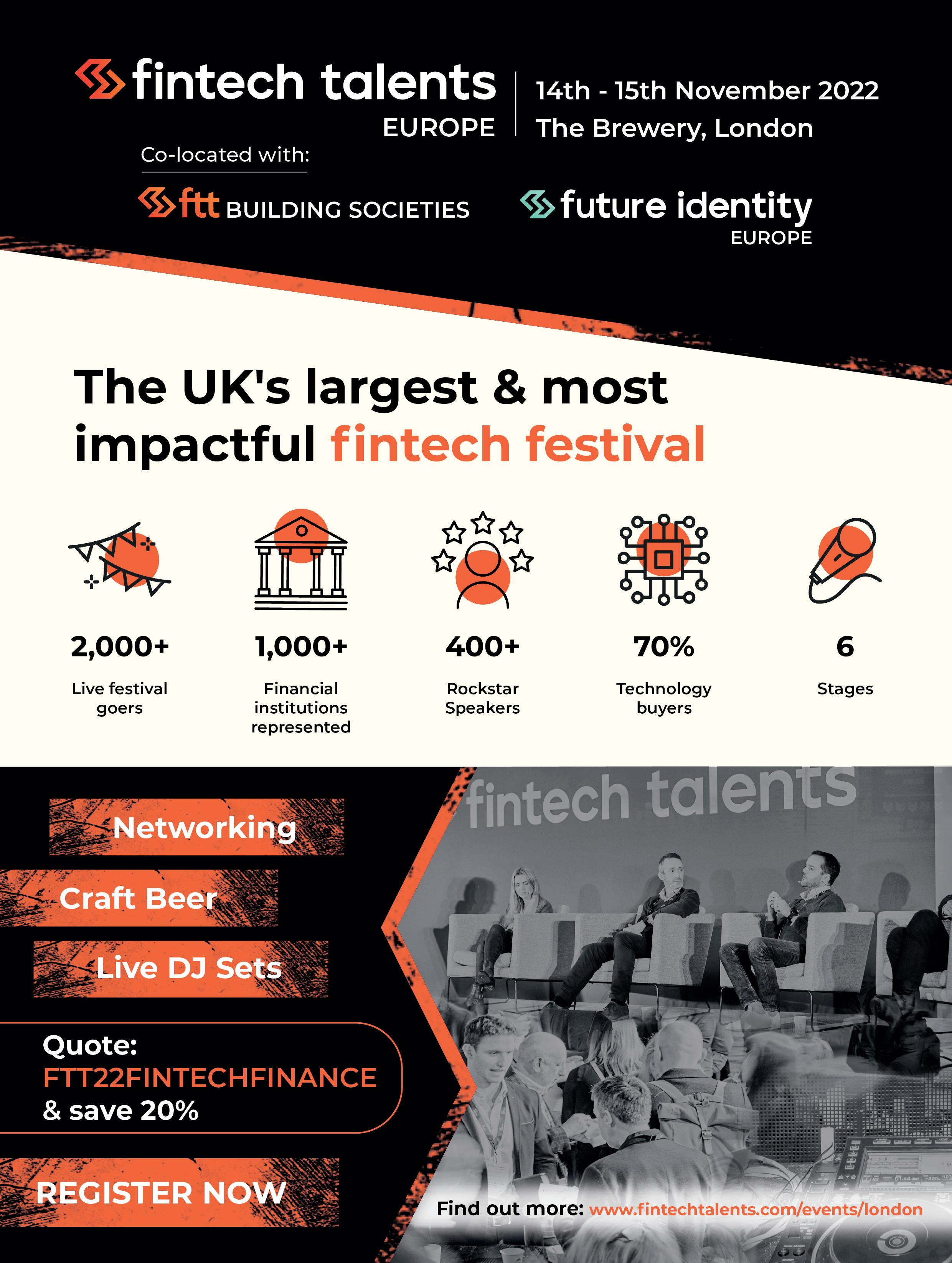

You’ve seen the meme… there’s no need to accept your fate, says Trygve Aasheim, Lead Architect for Corporate Banking at Norway’s largest financial services group, DNB

‘Planning is guessing’ was a phrase I read in a book 15 years ago. Of course it is, but Re:Work (the book) placed it into a new context for me. Today, plans are still guesses but, for tech, the stakes have become higher: J-curve style.
As technology strategists, we stand in front of a pile of future decisions where this is very clear. We’re guessing a lot. And more frequently. Technology must scale. Not in the amount of sessions or features (although that, too), but on a strategic level.
OK, that’s still old news. But, right now, the correct technology choice on paper does not scale in the real world. We must modernise. We must transition. We must mature beyond digital. We must become data-driven. And not just as investor theatre. But for real.
On paper, there is a limited set of technology patterns that stand out. They’re like North Stars. But North Stars are visible for everyone.
Sounds awesome? Wrong. It’s terrible. Because that means the talent that can juggle those stars commands twice the price in the job market as any other. Not
only that, they’ve been snapped up. If you are lucky enough to source a team, they are spending 25 per cent of their week fending off headhunters. And you need to give them freedom but you also need to control them – which they don’t like. However, that’s the problem you must solve, because the technology that has been with you for 40 years must be replaced, and by a team that understands that the technology they introduce won’t live for 40 years. And it shouldn’t. They are not guessing, though, they are implementing. They are in love – with both the technology and who they are (important… for everyone). It’s human. Yet you need to have technology hedging as part of your implementation: exit plans; abstraction; flexibility.
Flexible architecture isn’t just a phrase you add to your Powerpoint for those board meetings anymore. Now it’s dead serious. It’s your fire extinguisher. And if you don’t know how to use it, you will get burned. Because stars are hot. Like, seriously hot.
Being aware that firefighting is inevitable shouldn’t make us think ‘I will just live in an inferno’
So, how do you make sure your plans won’t burn you when your new team brings you a burning star?

Because, you know, the old teams that you remind every day that their technology is being phased out? Now they are challenging you with details about system logic so deep that any
previous rabbit hole seems like a flat surface. Those are unique. The reality is that the ones you are hiring today won’t be with you for 40 years. That’s not bad, but not good either.
So, not only do you need to hedge your technology choice and make sure you can exit whatever you choose, but the operational risk your dream team introduces is enormous if they quit. And they will, forcing you to trawl the job market again to find more star-jugglers. They will leave when they don’t feel challenged anymore. You still have challenges. They don’t.
Today’s employees don’t work for you or your company; but maybe for your vision statement, if it makes sense. They work for themselves to grow, thrive and jump to the next challenge to grow more. So, you must hedge that as well. You must plan for their exit, even if your fire extinguisher is named Challenge Creator 3000.
So, planning is guessing… and guessing feels as easy as riding a bicycle. Except, right now, the bicycle is on fire, you are on fire, the road is on fire. But look: quoting memes is inevitable in this line of work, but continuing to ride the flaming bike isn’t – even with fire extinguishers.
Being aware that firefighting is inevitable shouldn’t make us think ‘I will just live in a flaming inferno’. It should make us think about fire-resistant materials, extinguishers and plenty of water. Because, if you’ve done most of your thinking when you knew the least about a piece of work, then, as you know more, re-think. You’d be amazed how far it takes you down the ‘not being on fire’ path.
For banks that nailed their colours to the virtual mast early on, their obsession with one very tactile, 40-year-old payment method seems curious.
Are they acknowledging the immutable human attraction to things we can touch and hold in our hands? Or is it just an excuse for some shameless marketing? We’ve seen fluorescent, glow-in-the-dark, vertical designs, 24-carat gold-plated… business banking provider Anna even offers one that miaows like a cat (or, at least, the app notification does when users pay by contactless).
The physical payment card is clearly still seen very much as a brand ambassador but, more than that, it remains core to a bank’s interaction with its customers, according to Rüdiger Vogt from payments and identity provider G+D.


“We still see the payment card as an important physical connection between the bank or fintech and its clients, and I think this will continue for the foreseeable future,” says Vogt, who is in charge of fintechs, neobanks, and payment processors in the company’s global e-payments division.
Clients looking for the je ne sais quoi that elevates their card above every other on the market will find art nouveau and neo tech blended in G+D’s ‘Card Bodies’ catalogue. There is something highly sensual about the form factors displayed as part of its Convego services design suite, right down to the aroma-emitting cards infused with ‘the scent of a brand’.
“Over recent years, fintechs have differentiated with cards representing their unique offerings, be they comprehensive

packages for exclusive travelling via metal cards, green investment plans or cards manufactured from ocean-recovered plastic,” says Vogt. “And this is where we’re talking about going off limits, beyond anything we could’ve imagined, in terms of card material, packaging, unboxing experience – you name it. There’s still lots of potential in the physical card and we support our customers in creating innovative and exciting designs, like glow-in-the-dark, OLED (organic LED) display, 3D effects and using new materials such as metals, wood and ceramics.
“And let’s not forget alternative form factors: we’ve also ramped up our business enabling passive and active wearables, with fully tokenised, end-to-end solutions where we provide wearables manufacturers with the hardware, software and service back-up to add payment functionality to their devices, the most famous example being SwatchPAY.”
The investments G+D is making in new research and development (R&D) and production facilities just goes to underline its confidence in the durability of cards as a payment choice.
“We’re investing in physical card innovation and production, we’ve expanded our issuing services further globally and we’ve installed a lab for prototyping these new designs and materials, which keeps growing every year,” says Vogt.
As part of that expansion, the company recently also announced the acquisition of card manufacturer Valid USA, to expand its presence in the North American market.
Established 170 years ago, principally to printed bank notes, G+D has evolved to
A card in the hand… is worth a lot to the financial brand
Cards are so much more than a payment utility – and they’re not going out of fashion any time soon, says Rüdiger Vogt at G+D
offer everything from physical card production via numerous card personalisation centres around the world, to digital payment and security solutions. It’s also heavily invested in virtual card payment and security mechanisms around digital wallets, where the card crosses into the touchless, automated environment.
G+D is seeing growing demand for virtual representations of cards, be they bank-branded or from the big tech XPays. As a crossover payment method, the card is a phygital blend of customer-centric services that ensure consumers feel loved and valued, says Vogt.
“So, we are not ignoring the trends towards, first, contactless payment, then digital payments and – the next stage – invisible or embedded payments. But I believe that a phygital approach to payments and banking will lead to more customer satisfaction and new growth in financial services,” he adds.
“This means focussing on immediacy, ensuring things happen at an exact moment in time; immersion, users becoming part of the experience, and interaction, to activate the physical and emotional part of the process, which is key in this phygital experience.
Be it Revolut supporting LGBTQ+ charities with its rainbow card, banking platform Curve’s entirely numberless card, or the transparent design from German neo N26, our ‘flexible friends’ have been transformed into fashion accessories, status symbols and, most recently, statements of social responsibility.

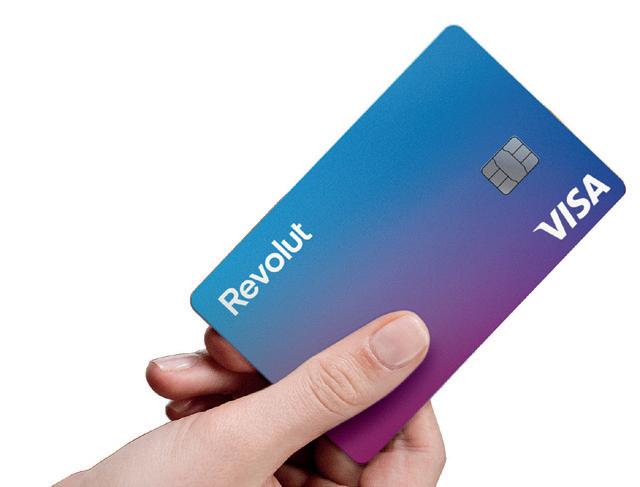
“The idea is to combine the best of both worlds, and to add value for our customers in banking and payments, looking at critical points in user journeys. Personalisation of services falls into this category. Card issuance is that first crucial moment after you’ve signed up with a new bank or fintech. It should be a really fun, easy experience and that’s what we’re enabling with our customers.”
G+D’s work with fintechs over recent years has had a formative influence on the company’s own business strategy.
Vogt adds: “Five years ago, we saw fintechs as an interesting development in the market, but didn’t really know what to make of them. We were used to large and mid-sized traditional banks and, all of a sudden, along came these guys that said ‘today my strategy is this’, and then, three months later, after a new investment round, had changed it.
“But you learn to understand the different dynamics and stakeholders, and
limited edition with charitable support for independent boxing gyms affected by the pandemic, donating £1 for every card ordered, and stumping up £50,000 itself for the campaign.
Rabobank and BBVA’s recycled payment cards symbolise their commitment to environmentally-friendly practices. Both use G+D’s Convego® Recycled Cards made from 100 per cent recycled PVC layers and produced using renewable energy. Rabobank also personalises its initial card mailings, using G+D’s Convego® Relate Print solution

fintechs’ stronger focus on growth rather than short-term profitability.
“We learned not to underestimate the potential and power of the agile fintech approach of try, fail, improve, try again. Fintechs are an enormous enrichment for the banking sector, and for us as a paytech.”
In fact, its work with paytechs has inspired G+D’s ‘Payment 4.0’ innovation initiative.
“We started Payment 4.0 with the goal of developing a dedicated business relationship with key partners in the fintech market, to identify companies for cooperation and investment and drive payments innovation together,” explains Vogt, “because we realised there is plenty of growth in this segment compared to some of the traditional customers we work with. Over the last two-and-a-half years, we’ve really started to see the success of this learning experience.
“Last year, we grew by more than 100 per cent in the segment, revenue-wise, and we’re targeting 200 per cent growth this year. It is the fastest-growing segment of the financial industry. It’s giving major impetus to ideation and innovation.
“In general, we benefit a lot from each other – combining G+D’s experience and R&D power with the ideas and agile business development of the fintechs.”
to include targeted brand and marketing messages related to each individual customer, using sustainably produced stationery and reducing unnecessary logistics like stock transportation through on-demand printing.
AUMAX TESTING THE METAL Metal cards – are de rigueur these days for fintechs wanting to make premium customers feel extra special. G+D teamed up with French fintech Aumax to enable its metal card as an exclusive option for its most select ‘Aumax pour moi’ customers. A subsidiary of France’s Crédit Mutuel Arkéa, this card is linked to the neo’s premium service package, including fee-free withdrawals worldwide, refund guarantees, higher cashbacks, advantageous insurance benefits and concierge services.



IF YOU’RE READY TO EVOLVE, WE’LL GET YOU TO THE FINISH LINE. FAST. Our cloud payments as a service allows you to accelerate innovation and serve your customers like never before. So, what’s holding you back? Visit volantetech.com.
IF YOU’RE READY TO EVOLVE, WE’LL GET YOU TO THE FINISH LINE. FAST. Our cloud payments as a service allows you to accelerate innovation and serve your customers like never before. So, what’s holding you back? Visit volantetech.com

 FREEDOM TO EVOLVE
FREEDOM TO EVOLVE
Building success: Mastercard's expansion is a lesson in disciplined investing

Mastercard’s investment strategy has reshaped the company in a remarkably short time. Babar Khan, responsible for Partnerships and M&A for Product & Engineering, shares what it learned along the way
The financial services industry has never shied away from investing inorganically on the much-desired path to business growth. There have been waves of financial consolidation over the decades, and, given their comfort zone with financial engineering, banks have always been at ease with riding those waves.
While the deployment of investment as a growth strategy continues to be a key ingredient, the recipe for it has evolved as financial services shapeshifted dramatically over the last two decades. It feels like an opportune time to reflect on the ‘invest-to-grow’ journey these strategies have trodden, the learnings from a tumultuous time, and the role they will continue to play in the future.
When I started 20 years ago, we were indoctrinated into the mantra of shareholder value maximisation – drive growth at all levels: top line, bottom line, share price. For years, the inorganic investment strategy for growth was buying similar businesses – cards,
branches, loan portfolios – rationalising back offices (hardly ever successful), and consolidating technology platforms (even less successful) to squeeze out earnings.
But incumbency and size led to complacency and, sometimes, customer neglect. The period leading up to the financial crisis of 2008 was not a banner period for innovation of financial services.
If you were a bank lucky enough to flaunt a fortress balance sheet post-2008, this was a busy time for your investment team. In a world of regulator-enforced balance-sheet shrinkage and strategic retrenchment, assets were cheap and plenty. The post-crisis investment strategy for growth during those first few years for strong incumbents was buying assets on the cheap, leveraging purchase accounting and pruning expenses.
Investing for innovation stayed on the back burner. This meant that the rethinking of financial services was driven by a rising generation of entrepreneurs in what we now call fintechs, rather than the incumbents themselves.
As the impact of the crisis started to recede, the more progressive incumbent
executives started to realise the danger posed by these challengers. These executives started to view their investment teams not as financial engineers, but as Sherpas steering the bank’s growth by streamlining the innovation agenda through buying, partnering or investing in the new kids on the block. Investing for capability was the new focus, as banks fought to stay relevant to the customer in this new world of smartphones and Cloud technology.
There were challenges in getting banks to make that pivot. The different risk/reward profile of these types of investments, the long-term ramp of revenue realisation, and the onerous capital impact of investing in technology, required paradigm shifts that too many executives were unwilling to make.

Over time, however, the importance of focussing your investment dollars on generating an external innovation pipeline became impossible to ignore. Nowhere in financial services was this more imperative than payments, the area that was witnessing the fastest rate of innovation.

When you have the strong position and the technical capability of an incumbent, there can be an institutional bias to building solutions internally. It requires vision to recognise that the world of innovation is too diffused, the pace of innovation too rapid, and the talent around technology too global for an incumbent to create a comprehensive set of best-in-class services.
This is even more true in companies that see themselves as platform businesses and aspire to compete across multiple use cases. That recognition was central to using the investment team to build Mastercard into a leading technology company beyond simply cards or payments.
Driven by a strategy that recognised a future where choice, flexibility and value for the customer was the North Star, there was a mandate to help diversify the DNA away from cards. These transformative strands included other payment flows (real-time, business-to-business, account-to-account, peer-to-peer), and services (cyber, loyalty, identity). In some cases, Mastercard was able to expand these solutions with in-house resources. In others, there was a willingness to identify existing gaps and then augment the product portfolio inorganically – always with the goal of providing value and choice to customers through best-in-class products and services.
There are now multiple billion-dollar, non-card businesses, including cyber, account-to-account and open banking, within Mastercard that did not exist a few years ago. Open banking is an excellent example of Mastercard recognising the synergy of our existing businesses with the emerging account-to-account, tech-first world. There were organic investments made to build and scale the capabilities that were closest to our DNA. Investment then focussed on startups complementing our open banking platform to create a compelling value proposition for this emerging ecosystem.
With the business case proven and ready to mature, major acquisitions like Finicity in the US and Aiia in Europe were undertaken to engineer the scale, connectivity and expertise for a nonpareil experience.

Investing is easy. Successful investing is hard. Most investments underperform
expectations, but there are principles that can move the odds in your favour:
n Clarity The most impactful investments for incumbents have been the ones underpinned by a crystal-clear business strategy. If the business cannot explain the why of an investment, the how and how much does not matter.
n Capital discipline The investment team is the custodian of the firm’s capital. There is an opportunity cost associated with each investment – it is a dollar that could have been used for building a product or marketing a service. The bias to make-do with something cannot overtake the need to do the right thing.
n Courage Some of the best investments are the ones you walk away from. Every investment is a drain on organisational bandwidth, and a bad (or overpriced) one can cause irreparable damage. Pricing discipline is an undervalued skill.
n Calculable In a world that is transforming so rapidly, you must live with some of your investments not panning out. But the best investment teams learn as much from these as their wins and take these learnings to inform future investments.
The industry has come a long way since I stepped into this space and banking is almost unrecognisable from back then. The transformation has been brought on by macro tsunamis of digital, mobile and Cloud, ridden by multiple generations of outstanding entrepreneurs and innovators.
This influx of startups has disrupted the traditional business models and reset customer expectations. While the progress has been clearly visible, it is also obvious that we are still in the infancy of the innovation potential in financial services. Digitally native generations reared on tech-led experiences will demand more of their financial services providers than legacy infrastructure and traditional business models can deliver.
Investments can be a critical ordnance for a business competing in that future and drive valuable contributions by adding capability and revenues. That this is now accepted as table stakes for successful organisations is obvious by looking at the ubiquity of venture arms and investment teams of all mature financial institutions. It's also catching on among smaller firms and even in early-stage companies.
The presence of strategic investors in venture funding rounds has been on a steady increase as both sides see the value in partnerships. While the cliché used to be whether the incumbent can find innovation before the disruptor finds scale, now both sides are getting comfortable with the mindset that the incumbent can find innovation and the disruptor can find scale together.
n Commitment There needs to be an organisational commitment at all levels to make investments, and to make investments work. Making an investment is just the start of the journey. Retaining talent, staying focussed on business goals, and realising value is the real work.
And that will not happen until there is commitment from all levels.
n Credibility The investment team needs to build a track record of making the right investments to influence the organisation’s leadership in the future.
And it needs to demonstrate to potential targets that they are a partner of choice. A well-regarded investment team is an invaluable ambassador for the firm.
In a more interconnected, API-driven world these trends will burgeon. The need for a strategy-driven investment team within organisations will be pivotal. They will continue to expand the horizons of the company, bringing fresh ideas from outside, and being the conduit of ideas between the business and the world around them.
As the father of modem investing Ben Graham said: “The best way to measure your investing success is not by whether you’re beating the market but by whether you’ve put in place a financial plan and a behavioural discipline that are likely to get you where you want to go.”
The plans and disciplines have fallen into place over the last decade. It's now time to deliver the future.
A strategy-driven investment team will be pivotal… to expand the horizons of the company, bringing fresh ideas from outside, and being the conduit of ideas between the business and the world around them

Ask any business leader about their top three challenges right now and talent is likely to feature among them.
Record low unemployment, the great resignation, remote workers, soaring salaries and a global skills shortage have created the most complex talent crisis in the modern era.
Business leaders are pleading with government and the education sector to solve the problem. But with technology and business changing so fast, any help they provide could take years to produce any tangible benefits.
Many business leaders I speak to feel helpless right now. But what if you could solve the talent crisis in your business today? The good news is there is a simple answer. The not-so-good news? Like innovation, the solution may be simple, but success depends on the execution.
I launched Tier One People in 2016. We help world-class fintech innovators like Revolut, TrueLayer and 10x Banking find executive talent.
Over the past six years, I have advised more than 300 fintechs on recruitment. And I have been responsible for hundreds of leadership hires, bringing in top talent from around the globe. Working daily with leading innovators has influenced my thinking and, a few years back, I began applying my learnings to fintech hiring.

Planet Earth is home to 7.9 billion people. We are arguably the most advanced civilisation in the history of humanity. Every company, potentially, has access to a highly skilled and educated workforce, available anywhere, anytime (according to Statista, 83.72 per cent of the world’s population has a smartphone and therefore access to the internet).
Indeed, it’s these conditions from which fintech evolved. A startup with little capital can leverage Cloud technology and smartphones to onboard and serve customers anywhere, 24/7. So, I asked myself what would happen if I applied the same innovative thinking to talent? Could we solve the talent crisis in fintech by using first-principles and design thinking?
First-principles thinking solves problems by reducing them to their essential elements and building from the ground up. But before solving the problem, I had to understand it. So, I spent two years researching, including hundreds of founder interviews and data on 100 fintech startups.
The research uncovered many problems, and I spotted recurring patterns, which helped me understand the real issue behind the talent crisis. Some of the problems I identified were:
■ Less than one per cent of fintech founders have professional expertise in talent and HR

■ Less than 10 per cent of fintech startups (<50 people) employ an HR professional
■ Startups that hired an HR professional as part of the founding team (first 10 employees) had, on average, half the staff turnover.
What became very apparent to me is that the ‘talent shortage’ problem in fintech was, in most instances, an internal issue as opposed to an external one.
Even with an HR/talent professional in place, hiring for fintech is complex. Fintech requires a unique set of skills and behaviours, making finding the right people difficult, especially if you embrace traditional recruitment methods.
How we work, communicate, shop, bank, listen to music and watch TV has changed massively over the last 15 years. But the way we recruit people has not. Have a look at the timeline (below right) of the most recent innovations in hiring. There’s an irony here that, like banking, the only innovation we have seen is digitising ancient systems and processes.
There will always be a talent shortage in fintech if we follow first-principles thinking, because this involves asking ‘how do we solve the talent shortage?’, and this is the wrong question.
Success creates its own problems. Dexter Cousins of Tier One People offers solutions to one of the most pressing
In the corporate world, ‘talent’ has become a ubiquitous term used to describe every employee. We must distinguish between skilled workers and talent. A skills shortage and a talent shortage are two different problems. Commonwealth Bank in Australia employs more than 4,000 software engineers – that’s more software engineers than all banking-as-a-service companies in Australia combined. Yet, it is still lamenting a talent shortage.
Whether a fintech or a tier-one bank, every company needs to innovate to survive. Therefore, if talent leads to innovation, the most talented people will always be in demand.
In fintech, the expectations placed on employees are closer to those required in elite sports than in a bank. In elite sports , players are hired not just for their skills but for their ability to deliver performances under intense pressure. And that talent is paid accordingly.
Similarly, in the fast-moving, high-stakes, high-pressure environment of fintech, there are high levels of scrutiny, where people must own mistakes, adapt quickly and perform. If they don’t, the business may fail. But if they succeed, the rewards can be significant.
who move from a large bank/financial institution to a fintech startup leave within the first six months. So why is there such high turnover?
People are given a clearly defined task in a bank, with support, training, tools, and resources. Compensated for completing tasks promptly, if an employee doesn’t deliver, the bank won’t fail. If an employee makes a mistake, they can hide it or blame someone else. This culture is pervasive in large institutions and has led to three CEO resignations from the Big Four banks in Australia.


This type of behaviour can prove very destructive to fintech startups. So, if hiring from banks and financial institutions is too risky, where do you find talent? It seems like a reasonable question, but it’s not the first you need to ask. Instead, it’s ‘how do I identify talent?’. I have created a simple algorithm for assessing talent in Fintech:
At Tier One People, we assess every candidate on these four criteria. Using this assessment, only two per cent of candidates make it onto a Tier One People shortlist. Out of 150 leadership hires, 42 per cent are females following these principles. To date, the algorithm results in a 97 per cent success rate, compared to a 90 per cent failure rate when hiring people based on their experience in a bank.
If no one has made ‘the thing’ you are making, people must learn on the job or ‘fly the plane as you’re building it’. Therefore, a person's propensity to learn a new programming language under pressure is more critical to innovation than their proficiency in Golang.
Contrast that environment to a bank. Based on my data, 90 per cent of people


Fintech 1.0 was all about picking the low-hanging fruit. Banks were doing such a lousy job of digital and had such contempt for their customers that any fintech offering decent CX (customer experience) could gain customers relatively quickly.
And this is precisely how I would describe the talent market. Fortunately, companies are doing such a terrible job of digital and treating candidates with such contempt that anyone who can offer better CX (candidate experience) will hire top talent.
Let’s face it, the candidate experience sucks. Job platforms, chatbots, online application processes and video resumés reduce the time for the recruiter at the candidate’s expense. An effective talent acquisition strategy mirrors an effective customer acquisition strategy.
Recruitment is all about sales and marketing. If you rely on job platforms as your primary distribution platform, you will always experience a talent shortage. If you want to engage the best talent, an omnichannel strategy is essential, not buzzword bingo.
We stopped advertising on job boards three years ago at Tier One People and used the budget to create a podcast. As a result, the number of inbound enquiries we receive from top fintech talent has tripled.
Combined with our partnerships (UK DIT, FinTech Australia, Blockchain Australia), sponsorships, media appearances and content, a small business has created a globally recognised brand that attracts quality talent and clients.
Often, the best innovations come from reframing the problem and looking at it through the eyes of the customer.
So, when you start thinking of talent as people, as your customers, you are well on the way to solving your talent crisis.

‘ Where do I find talent?’ is not the first question to ask. It’s ‘how do I identify talent?’
Ugly back-office systems can’t be masked by layering on colourful tech – new thinking is needed, says Leigh Pepper, Chief Product Officer for 10x Banking
The phrase ‘lipstick on a pig’ has become the favourite fintech idiom to describe banks’ approaches to transformation, capturing the attempt to jazz up the UI and transform the UX by changing a form from a single page into individual screens, to capture my name and feel more like Apple.
I’m beginning to feel that the pig has been unfairly treated – it’s a highly intelligent and adaptable animal. If the underlying systems of most banks were half as porcine as the wily swine, then the industry’s reputation for innovation would be in a much better position.
To be fair to the banks, most have done a decent job of improving digital experiences. Integration of fintech solutions for electronic identity and verification has transformed most onboarding experiences. The ability to view how much I’ve spent on coffee and takeaways is now table stakes.
Now that more processes can be completed through my mobile app, branches are largely redundant beyond marketing and providing a community brand connection. It feels like the battle for clever UI and UX is diminishing, with Monzo and Revolut having set the bar and the incumbents risen to the challenge.
But, when you lift the lid on many of these user experiences, it reveals not the pig but the sloth: slow underlying manual processes, poor customer experience at the slightest hint of being an exception and the ‘please visit a branch so Doris can smile at you and fill out a manual form to put you in
a work queue for somebody to pick up and try to resolve?’ approach – all relying on a creaking back-office system.
It’s these moments of truth that continue to drive high operational costs, customer frustration and attrition, and hold banks back from innovation. Why is this the case?
1 Investment is pouring into transformation to improve customer pain points

2Layers of additional technology are bolted on in response
3 The complexity of managing these programmes and the bit-part solves sap the organisation of capacity for innovation and true transformation
Many banks are moving to agile practices and value-stream approaches, and this is commendable – focussing on end-to-end customer journeys and incrementally tackling the most value-adding problems first will drive transformation. But this piecemeal approach can often lack the strategic vision needed for true innovation in product and offering, and fails to tackle the underlying ‘elephant in the room’.
These value streams can end up exacerbating the issue by being constrained in their approach. In most cases, they own some aspect of the user interface and common user journeys, they own some layers of the bank’s architecture – they rarely own product manufacturing and the associated transactional execution. So, what happens in these situations?
I often use the term spaghetti architecture to describe the years of application integration and the proliferation of systems that a bank has built up over time through acquisition, merger and channel growth. Where, I fear, we are moving to today, is ‘lasagne architecture’. Well-meaning architects helping to address value-stream challenges by layering on more and more technology solutions to solve
point-in-time problems are just abstracting further and further away from the underlying problem that ultimately constrains any real innovation. You could think of the core as horse meat from the UK’s frozen lasagne saga of 2013 – the bad taste hidden by the many layers on top.
In some cases, it is even worse, with IT departments maintaining the fallacy of in-house build, cobbling together solutions, with ongoing maintenance and support acting as a drag on the banks’ operational costs for years to come – because nobody considers what it will cost in five years’ time.


To be clear, I’m not against the value-stream approach. I think it is the right way forward if the P&L holder owns the value stream, it is not focussed on just cost saving but on value and product innovation, and it truly owns the end-to-end underlying architecture. But they rarely do because the layer that needs the most love ends up as a problem that’s too big to solve and acts as an anchor on every value stream and business unit in a bank – the dreaded core.
Take buy now, pay later as an example. Klarna, Afterpay, Zip, Affirm – these businesses have all been around for almost a decade. In the past few years they all started to get incredible traction with a fairly simple product. So, why did no bank’s lending business, or lending value steam, capture the zeitgeist?
Many would point to regulatory issues around banks’ approaches to affordability; others would suggest that banks wanted to protect their merchant fees for their acquiring business. All maybe valid, but one thing I suspect was an issue for all the banks was the cost and pace at which they would have needed to be able to manufacture that simple product on their core.
Speaking to CIOs at major banks, I hear a familiar story and some startling facts: an 18-month backlog of small changes on the core, the majority
being to do with regulatory change; code bases that date as far back as the 1960s and the number of engineers that can code on them being in single digits; complex product logic encoded in the solution. Such factors result in delivering any product innovation turning into a multi-million-pound, many-months-long programme.
So, there are two problems: no value stream or business owner can move at pace or truly innovate or keep up with the market, and monolithic architecture and resource scarcity mean they can never house the level of resource needed to do the engineering required.
Why can’t the core be an enabler rather than a problem to be abstracted around?
The truth is that, in the past few years, the industry has developed so fast around Cloud-native platforms that it can; the competition is so fierce that the unit economics are rapidly reaching that of a highly competitive market.
A value stream could truly own the ability to innovate on the core if it is a platform, not a monolithic mainframe. The need to invest large upfront sums, employ vast IT departments to code and maintain the core, and to worry about regulatory change, are figments of the imaginations of those who have not taken the time to engage in the latest technology trends.
A truly managed software-as-a-service

Lipstick on a pig? Some core banking technology isn’t half as intelligent!
(SaaS) core can now mean that your core is evergreen, keeping up with regulatory change, so you can actually spend budget on something more than the latest iteration of the rulebook. Highly flexible approaches to different channel integrations and fully digitised execution of both happy and unhappy paths, will fundamentally change the operating cost base, and all without 12 layers of abstracted systems.
These plug-and-play architectures are being held back by some peculiar forces: the internal politics and power bases trying to retain control, a misperception of the complexity of utilising this technology and inertia in decision-making within banks.
Ultimately, this comes down to leadership. There are few across the banking industry who genuinely have both banking domain expertise, and the understanding and experience of the latest technology. There are many who have experience
just of the bank’s technology – and it is this constrained thinking that holds us back.
This perhaps sounds highly critical and somewhat arrogant, but I have been in that position. It has only been through working outside of traditional banking that my eyes have been opened to the amazing possibilities and potential for innovation brought by working with technology unconstrained by the ‘not built here’, ‘that’ll cost you’ or ‘it’s too risky, the whole thing will fall over’ attitudes that still pervade the corridors of many banks today.
There is hope. Many who have worked in fintech are returning to banks with fresh ideas and approaches. Leaders exist who can cut through and make things happen. I work with clients every day who have done this in large banks and will be reaping the rewards as they experience the agility of a modern core platform. In short, the lack of banking innovation is no longer a technology problem, it is a leadership one.
To go back to the animal analogy, I wish banks would stop being so pig-headed.
The technology is ready. It is relatively low-cost and lowrisk. So, try something new!
Why can’t the core be an enabler rather than a problem to be abstracted around? The truth is, it can
What makes challenger brands fit for purpose today... and for tomorrow’s world? Eric Fulwiler, Co-founder and CEO of growth consultancy We Are Rival shares his thoughts


The financial services world of 2022 is a loud, noisy, crowded place.

Technology and regulation have lowered the barriers to entry and distribution to such a point that the market is flooded with new brands, products, services, and content (gah, so much content!). How do you find any white space at all? How do you stand out? How do you reach a modern consumer (B2C or B2B), one who has so much more choice than they used to? And, even if you answer those questions, how do you continuously answer them, day-in, day-out, year-in, year-out when the only constant around you is change?
Well, the solution to success in today and tomorrow’s world is a combination of a lot of things, but it certainly isn’t doing things the way you’ve done them before. So, let’s break that down.
Many businesses are struggling in this new landscape, but not all. Some are thriving. These are the challengers: the companies that are fully fit-for-purpose for the world as it is right now, not the way it was in the past.
Incumbent v challenger is an overused and over-generalised categorisation, but it does serve a purpose to identify the focus and focal point of a business. Incumbents
are designed for yesterday; challengers are designed for today. Incumbents tend to be big and old while challengers tend to be young and small. But those characteristics are correlative, not causal to their ability to be fit-for-purpose for the world around them and reap the growth benefits that capability offers.
A lot of what I’m going to talk about here is marketing. It’s what I know, and it’s what I believe is an integral part of long-term, sustainable growth for any business. However, I always add a giant caveat when I step up on my marketing soapbox: product has a huge role to play in the growth of challenger brands. After all, the best marketing is a great product.
But… growth beyond an early adopter audience, beyond a small group of advocates, growth that truly disrupts a market must, by definition, be driven by strong product and strong marketing. These are always the two factors in the growth equation: product innovation + marketing innovation = growth.
And, before all you non-marketers tune me out, marketing is not advertising. Advertising is a part of marketing, just like front-end design is part of a product, but a better, true definition of marketing is anything that connects the product to the customer. All those years when early challenger banks in the UK said they didn’t ‘do marketing’? False. They just didn’t do advertising. Hot coral debit cards? Marketing. Community meet-ups? Marketing. Golden ticket referrals? Marketing. And brilliant marketing at that.
The best marketing isn’t about stuffing ads in people’s eyeballs and ear holes, it’s about building a bridge between the product and the customer. Sometimes
that’s putting out an ad to drive new sign-ups or downloads; sometimes it’s about giving people an opportunity to show off to their friends that they’re different or that their voice is being heard.
Another way of putting it: marketing brings the customer into the company. Marketing’s job is to build long-term cash flow (versus the short-term cash flow of sales) by developing a deep, differentiated understanding of the customer and finding ways to connect the value of the product to their needs. And marketers (or, at least, the good ones) do this not just through content and communications, but through context.
Because after all, context is everything. What you put out into the world only exists through the perspective with which you see and experience it. If you don’t understand the context of the consumer’s world, you’re leaving growth on the table. And that’s what challengers do well – they don’t leave any growth on the table.
Challengers brands – brands that are fit-for-purpose for today’s and tomorrow’s world – do two things well. First, they are built for impact: they focus on adding value to the audience they’re trying to reach in a highly differentiated way. Their North Star is the customer, not the product, the tech, or even the (short-term) bottom line. And the path they take on their journey is a new, fresh one that hasn’t been trodden in the marketplace before. Said another way, they do things that make people actually care. The biggest risk in modern marketing and brand building isn’t doing something wrong, it’s doing something that nobody cares about. Second, these challengers are ready for change: they build teams,
culture, and ways of working that are intelligent and adaptive. They find arbitrage in the stockmarket of consumer attention through a blend of data and creativity. They test and learn as they go, they experiment, they take risks. They recognise that managing change, dealing with what you don’t know, is more important than how smart or strong you are at any one point in time. And, most importantly, they evolve. They play offence, not defence. They are always looking to get smarter, better, faster.

For those of us who have worked in challenger businesses, we know the magic feeling and energy this gives to a company when it’s coded into the cultural DNA. It’s the special sauce, the X factor that allows these businesses to take advantage of the constant change in the world around them, instead of falling victim to it.
The marketing playbook of 15 years ago (heck, even 15 months ago) is not fit-for-purpose for the world of today. Throw it out, don’t just cross out some lines and add some new pages. Throwing out and starting over (in principle, not always practice) is core to what makes a challenger. In order to be fit-for-purpose for today, you need to have a healthy ignorance (or forced forgetfulness) of what’s possible right now.
If you are always dragging last year’s ideas, models, research, budgets, etc into this year, it won’t be as bespoke as
it could be. This is the marketing department’s equivalent of tech debt. Rip and replace the old and rebuild with the new. Much like tech upgrades, you need to do it carefully and with a clear understanding of the first- and second-degree consequences – risk is
now, are the fuel for your competitors’ growth.
We spend a lot of time pontificating on what’s coming next, but actually, in my experience at least, most opportunity doesn’t come from predicting change, it comes from reacting faster and smarter than others when it happens. There are so many learnings to take from the last 15 years into the next 15, and there is value in using history to understand the future.
always proportional to reward. But challengers are always asking themselves how they would do things differently if they started them again from scratch today.
They may not always be able to start over, and, of course, you couldn’t build anything to scale if you did, but they know where the gaps are. And those gaps, between how you’d do things differently and how you’re doing them

But building a brand and business that’s fit-for-purpose for today and tomorrow’s world isn’t complicated, even if it is hard. We don’t need new people telling us new things, we just need to focus on the fundamentals of growth: add value in a differentiated way (i.e. build for impact), and execute intelligently while adapting quickly (i.e. be ready for change).
Simple in theory, hard in practice; that’s almost always where the opportunity (in business and life) lies. Don’t look for new answers, get to work on the ones you already have and know. The untapped potential is in the execution: thinking and acting like a true challenger.
The biggest risk in modern marketing and brand building isn’t doing something wrong, it’s doing something that nobody cares about

In today’s battle for customers, banks need to seriously up their reward game, says Anna Porra, European Strategy Director at Marqeta
For years, financial institutions have relied on the fact that, statistically, you’re more likely to get divorced than change your bank.
But, according to Marqeta’s 2022 State Of Consumer Money Movement Report, based on surveys in the US, Australia and the UK, customers (in the latter two countries, at least) now consider ditching their bank almost as readily as they would dump their partner.
Twenty-six per cent of those surveyed who use a traditional provider as their main bank, already had an account with a digital neo, and another 26 per cent of customers said they were thinking about changing banking providers. So, what would incentivise them to leave?
“Nearly six in 10 (59 per cent) of US consumers surveyed rated cashback number one, followed by airline miles and multi-purpose points. Two-thirds (66 per cent) of younger consumers listed offers from merchants where they shop as their top reward choice,” says Anna Porra, European Strategy Director for Marqeta.

Motivating customers to open new accounts or switch the ones they have is challenging banks to come up with inventive temptations.
In the UK, for example, savings and investment app Chip recently launched a zero-interest deposit account that gives customers the chance to win tens of thousands of pounds every month – the more deposits a customer makes, the greater the chance of winning. It’s banking lotto. Elsewhere, savers have been rewarded with digital scratch cards.
As an API-driven card issuing platform, Marqeta stands ready to work with legacy banks and challengers on developing the most compelling offers. Indeed, it was instrumental in helping the investment and banking app Stash come up with a first-of-its-kind reward
programme, based on the bank’s Mastercard. Launched using its new proprietary infrastructure platform, Stash Core, developed with Mambu, the Stock-Back® debit Mastercard allows customers to earn stock and invest when they shop. At the time of writing, the bank had given away 59 million stock rewards.

“Our survey revealed opportunities for personalising credit card incentives and rewards programmes,” says Porra. “Only 26 per cent of survey respondents said their rewards were very personalised to their spending habits. There’s an opportunity for card providers to lean in here, customise their incentives and reward programmes to keep their customers and gain new ones.”
There’s an opportunity for card providers to lean in here, customise their incentives and reward programmes to keep their customers and gain new ones
The report also discovered that 75 per cent of people globally have used a mobile wallet in the last 12 months; 67 per cent of respondents said they’d used a wallet more frequently since the onset of COVID 19. That’s significant, because it means
it’s harder and harder for traditional banks to remain top of mind with customers if they don’t have the reminder that a physical card represents.
In the battle for wallet supremacy, research suggests that anything outside the customer’s top two virtual cards typically results in 40 per cent of those customers moving to other banks or payment methods. Those in the top spots tend to get used four times as often. And, once the habit has been established, it’s hard to break: only 63 per cent of people said they automatically add a new card.
All of which points to innovation and imaginative incentives becoming increasingly important for customer stickability, says Porra.
“There is now a lot of choice in payments and banking for consumers. As more merchants welcome contactless payments, banks and fintechs must work harder to provide a smooth digital experience for their customers. We offer our customers the tools to customise their card programmes, which has led to popular propositions such as buy now, pay later financing and customer loyalty rewards beyond the traditional miles and points.”
In terms of what matters most to consumers, she adds: “To enhance cardholder satisfaction, card providers should focus on delivering what consumers feel are the benefits of credit cards: making their lives easier, getting incentives for purchases, and not having to worry about security.
“We’re in the middle of an explosion of choice in banking, and innovative companies have a lot to navigate to deliver personalised and flexible solutions that fit within their customers’ everyday lives.
We’re proud to partner with fintechs like Stash that are changing the way banking is done.”
on a mission to build a more open world.
… and it’s that, after a decade of ‘digital transformation’, banks fully commit to the change journey. Mambu and its partners stand ready to act as guides
‘Financial services available at point of need, at point of time, and it’s easy’. That’s what Ben Snowman hopes to wake up to find banks across the board providing in 2032.

As VP of partnerships and advisory at Mambu, he’d like to think it will have helped them achieve it, too, by working in tandem with an ever-expanding ecosystem of companies that muscle-up Mambu’s deliberately ‘skinny’, Cloud-hosted, single code-based core banking platform.
“As a software-as-a-service business, we are really clear on what we are and really clear on what we’re not,” he said recently in an interview with one of those partners, Publicis Sapient. “[It’s] why the ecosystem is so important to us – which is the essence of composable banking.
“Our identity is, frankly, a very skinny, pure public Cloud core banking platform, but the ecosystem of service companies means we can adapt to the clients’ needs. We have no intent to build anything that we would be better working within the ecosystem to offer clients.”
Werner Knoblich, chief revenue officer at Mambu, describes what it offers as ‘a reference architecture, composed of multiple components, with multiple companies, pre-architected together’.

“We live in a world where no one supplier can provide everything holistically, end to end, so you need more of a best-of-breed solution,” he says.
A 100 per cent API-driven product portfolio underpins the concept. “So it’s very easy for a customer or a partner to integrate with us. It’s that way by design,” adds Knoblich.
Among Mambu’s 300 or so partners is Backbase. Headquartered, like Mambu, in Amsterdam, it’s an engagement banking platform that helps banks orchestrate journeys across the customer life cycle,
from onboarding to servicing, loyalty and loan origination. Its front-end experience layer and Mambu’s core, both natively built in the Cloud, ‘provide 70-80 per cent of what all banks need to deliver those differentiated customer experiences’, claims Elliott Haralambous, global director for ecosystems at Backbase.
“We have this vision that, whether you’re based in Vietnam, the Nordics or Latin America, you can use the combination of Backbase and Mambu, born in the Cloud together, to power all sorts of banking experiences, and get live in months, not years. [It’s about] best-of-breed providers coming together to deliver exceptional customer experiences and help banks differentiate from their peers.”
Backbase, which joined Mambu as a partner in 2020, this year completed its
We live in a world where no one supplier can provide everything holistically, end to end Werner Knoblich, Mambu
first funding round after a decade of self-invested success. The €120million from Motive Partners, a New York-based investment firm focussed on fintechs, will help Backbase max out on current demand from legacy banks for its proposition: a single platform for any customer journey using middleware that harmonises the many separate databases that decades of digital transformation have created inside banks, and surfaces that to create multi-channel engagement. The growing desire among institutions to make the most of what they have, rather than build new, is a trend that Ben Snowman has witnessed since COVID.
“Banks returned to a more protective way

of running their businesses during COVID, having been exposed to fundamental innovation over the past decade,” he said.
“Banks are building on that cost control element – and moving things into the public Cloud certainly helps with that. But they are simultaneously becoming more comfortable with new technologies. How they measure this is both in the cost and how quickly they can get products to market. It’s a high-velocity model.”
He’s seen the ‘speedboat strategy’ –which gave rise to NatWest’s Mettle and JPMorgan Chase’s Chase in the UK, Deutsche Bank’s Fyrst and Santander’s Openbank in Germany, and Bank Dora in the US, among others – slow in the West over recent years. “It doesn’t mean banks have stopped innovating to refine products and attract new segments… But it’s not big-scale, big-picture innovation.” Matt Williamson, VP of global financial services at digital design consultancy Mobiquity, also a Mambu partner, agrees there’s a definite strategic shift ‘away from a legacy culture, which is very much in-house fiefdoms’. “Now it’s about best of breed in a specific segment and then how do you make the most of that,” he says.
“Mambu is obviously very good at the core banking element; we come in with the experience layer and become the glue, with other partners, to deliver an excellent customer outcome.
“As new things evolve, we can add services on top of the previous programme, without having to junk it – which is a very legacy way of doing things – and just adapt and overcome.”
So, for Snowman to realise his dream, what did he think needed to happen?
“For banks to move from experimentation to the desire and full intent to move to new technologies for the greater good of the organisation and its customers.”
Could digital wallets put banks back at the centre of their customers’ universe? We hear from three experts who believe institutions big and small are finally beginning to grasp the opportunity they represent
CB Insights’ 2022 report Future Of The Wallet: How AI Advisors, Digital IDs, And Wearables Are Turning Mobile Wallets Into The Next Super Apps, demonstrates how fast and how far the virtual wallet has come in recent years.

Fintech network Baku, which published what it claimed is the biggest report into the growth of mobile wallets last year in association with Juniper Research, forecasts that half the world’s population will use one by 2025.
That’s not an unreasonable assumption, given that every man jack of an organisation seems intent on launching its own, be it big tech, telco, online gaming company, retailer… or bank.
Not all wallets are made equal, of course, and the nomenclature around them –e-wallets, mobile wallets, virtual wallets, digital wallets and even super wallet – is contested and confused. But there are certain generics on which all can agree.
Closed wallets limit the user to transactions, and route all the valuable data attached to them, through a non-financial issuer (like Amazon Pay, the Starbucks’ or online gaming retailer E Sports’ wallets). Some have been so successful that they’ve transformed organisations into defacto payment companies. Semi-closed wallets can offer more on- and offline spending choices, including bill payments, and are often interoperable with other e-wallets, but they demand additional know-your-customer (KYC) processes. And then there are open wallets, owned or issued under a third-party arrangement by licensed financial institutions. They’re the full monty, providing a comprehensive range of transaction options.
The utility of wallets doesn’t stop at payments, though. Driven by customer
demand for convenience, automation and customisation on their phones, what began life as a virtual store of value is evolving into an all-round enabler of everything from accessing places and services, monitoring the state of our health and, more recently, proving who we are.
The big techs are well-placed to dominate the digital wallet space, leveraging their brand power, extensive customer bases and reputations for outstanding user experience – not to mention the vast data pools they hold.
Apple, whose wallet already stores users’ debit and credit cards (including its own, courtesy of Goldman Sachs), as well as digital car keys, tickets and boarding passes, recently announced plans to launch digital identification options, allowing a user in the States to add their US driver’s licence and/or state ID to their iPhone and Apple Watch.
Apple Card sets the bar high for virtual cards. Everyone else now needs to try to meet it Alex Bowen, HSBC Hong Kong
Google – the first major organisation to launch a wallet in 2011 – has similar plans for an ID wallet that can be loaded on to multiple brands of device.

Wearable-compatible wallets are a growing segment. Apple and Samsung have led the charge, pairing their wallets with smartwatches for seamless digital payments, helping to propel the worldwide wearables market alone to $1.3trillion by 2028.
Google is rumoured to be launching its own smartwatch, Pixel Watch, this year
after acquiring Fitbit in 2021. All three are already leaders in the IoT space, which could see wallets used as machine-to-machine payment vehicles.
While some wallets have been developed for a specific purpose and have no ambition to be anything more, others (notably the big techs’, which dominate the top of the download charts) clearly aspire to be all things to all people.
In Asia we’ve seen the smartest smart wallets gradually evolve into superapps, including Alipay and Grab. And, across the world, mobile wallet providers, including Revolut in the US, Lydia in France and M-Pesa in Kenya, aspire to follow in their footsteps.
The CB Insights report predicts that superapps ‘will be the dominant fintech strategy of the next decade, and pose a growing threat to legacy financial players as well as single-function fintech apps’. It's against this backdrop that banks must determine where their wallets fit in. Could the wallet put them back at the centre of the consumer’s universe?
PayMe is a good example of what banks can achieve. One of the first wallets issued by a major bank, it was launched by HSBC Hong Kong in 2017, in partnership with Episode Six and its Tritium platform, which helps banks quickly scale up products for large customer bases.
PayMe’s boyband marketing and talking cat mascot, PayMeow, puts the wallet on a very different plane to its highly corporate parent bank. But its credibility and popularity is such that it was recently selected as one of the conduits for distributing the Hong Kong government’s consumption vouchers, part of its post-COVID economic stimulus package, which can only be used via digital payment apps. It’s as clear an indication as there can be that wallets will become central to everyone’s life, everywhere.
Alex Bowen, who is the fintech’s chief operating officer, says HSBC Hong Kong’s journey to launching PayMe was shaped by a highly competitive market.
“There are a lot of wallets in Asia, and some huge names as well. In terms of superapps, each country has a leading couple,” he says.
“In such a saturated market, innovation around giving customers the experience they want is really the only way to differentiate. There was a strong use case in Hong Kong, around solving payments between people. There were bank transfers, but you have to log in and find your payees, and it’s not customer-centric,” he says.
“We were lucky that we had the relevant funding, so we didn’t need to consider whether a white-label product was cheaper or better, but we followed some very stringent principles around scaled agile, to make sure that we could design with the customer in mind and release often – to get the product out and then innovate.
“We’ve kept PayMe deliberately small, in terms of its footprint, to allow that continued design and innovation, and a sense of ownership by the team. It’s a great feeling, when you see something you’ve designed and deliberated on, go out and get used.”
He has every reason to be proud of the wallet’s success: with 2.7 million users, it represents more than 75 per cent of all P2P payments in Hong Kong.
Bowen acknowledges that big techs have made the running with wallets and related products. But that’s been to the banks’ advantage, he says. Citing Apple’s new completely fee-less credit card (which also exists in physical form, if you request it, but otherwise lives in your wallet), he adds: “Will I take up an Apple Card? Yes, I’m sure I will try it out. It gives the consumer choice. That’s a positive thing, and it will force everyone else to look at the journey, look at the end-to-end, look at how many clicks and scans it takes to make a payment.
“Apple Card sets the bar high for virtual cards. Everyone else now needs to try to meet it.”

PayMe is by no means the only successful wallet to be launched by an incumbent bank.
PayLah!, the wallet owned by DBS bank in Singapore, is

already bordering on a superapp model – it’s described on the bank’s homepage as ‘the ultimate everyday app for getting rides, booking tickets, ordering meals and more’. It also has more than two million users and enables them to earn and manage rewards.
Spanish banking giant BBVA is busy innovating along the same lines. Last October, it organised a virtual hackathon that challenged more than 700 participants from 164 global universities to develop a superapp that could meet customers’ needs for finance, entertainment, shopping and transport in one place. The problems they were
The wallet proposition is about taking care of the value-added space around them once you have that user interface.
For a bank, it’s very important to own that Kurt Schmidt, Netcetera

challenged to solve were put forward by BBVA’s business units in Mexico, Peru, Colombia and Spain, and their associates. A team of five Mexican students won the competition, organised by BBVA’s Open Innovation arm, using artificial intelligence and QR code payments to develop a full mobile application that ‘integrates financial and non-financial services to streamline users’ day-to-day transactions’.
This is an example, says Kurt Schmid, marketing and innovation director for secure digital payments at software solutions provider Netcetera, of how banks can make much more than a transactional tool out of wallets.
“The wallet proposition is about taking care of the value-added space around them once you have that user interface,” he says.
“For a bank, it’s very important to own that and then bring in this additional customer experience and journey, for commercial benefit.”
One function, he suggests, is as a store for receipts that are generated during the payment process and which can then be automatically uploaded to the wallet.
“When I’m identified with my payment credential, I want my digital receipt to automatically be pushed into my wallet. Then I have it and can search for it, for warranty purposes, expenses, or whatever.

“That has many appealing aspects –ecological, so you’re not wasting paper and trees, which, I think, is more and more important; convenience; and it also builds the relationship between the shop and the purchaser. It’s one of many other features that could be built around the wallet.”
It would also cut across providers and demand a partnership approach, according to Schmid. To build a smart wallet, you need to accept you can’t do it alone.
“Partnership is how to survive in the future,” says Schmid. “If you just look to the payment side of managing a credit card or whatever, yes, the bank can do this alone. But when you’re delivering a full customer experience journey, for all their needs, and all the other use cases around the payment – value-added services like financing, lending, insurance, instalments, digital receipts, personal finance management – you need the interoperability of open banking, open APIs and open finance, and to be interlinked with merchants.”
Of course, persuading people to lodge all the important information they use to manage their lives, day-to-day, in one digital ‘place’, requires large amounts of trust, particularly if it’s where your most valuable personal identity documents also reside.
CB Insights predicts that digital ID wallets will boom in the next decade, prompting greater collaboration between technology companies and government and inevitably increasing the amount of regulation and processes required to manage privacy and other associated risks.

Banks are already sitting on huge reservoirs of trust, points out Bowen. His own wallet, PayMe, makes play of the fact that it’s powered by HSBC’s security systems.
“Most banks today, in most countries, have an established position in the market. They’ve been there for a number of years – even centuries – so, from a consumer point of view, there is that feeling that they
are here to stay. Banks can leverage that position of trust by looking at how they deploy, how they partner and how they innovate. They don’t need to do anything to generate that trust, but have an inherent responsibility to protect it and ensure what they’re doing is the right thing to do.”
Alex Gatiragas, product and technology director for established global payments solutions provider Giesecke + Devrient (G+D), explains how it is providing the technology to help organisations of all kinds build trust, through secure tokenisation of sensitive data among other things, using its proprietary Token Cockpit platform, which gives consumers and merchants alike full
that’s been in the background as the silent achiever, protecting their payment credentials. But we’re now seeing a lot of interest from banks and fintechs in providing additional tokenisation services to their end customers in the form of visibility – seeing where their tokenised details are, which wallets and merchants they have pushed their payment card details to, also giving them the ability to suspend or delete them. It gives customers trust in the payment ecosystem by putting them in control.”
If, as Gatiragas says, the ‘magic word’ when it comes to the future adoption of wallets is trust, banks are in a good position to leverage the confidence users already have in them to combining identity credentials with payments – something others have not yet fully managed in the same wallet. So, for instance, you wouldn’t have to use a digital payment and a separate digital age verification to authorise an age-restricted purchase – the bank could vouch for you and facilitate the transaction in one.
visibility of all aspects of their transactions, including the cards they have on file with different users and organisations.
“Most of our activity, when it comes to digital wallets and payments, is around tokenisation. We help a lot of the banks and fintechs have their own issuer wallets. From an end-customer’s perspective, tokenisation is something
Certainly, the agenda around digital identity and wallets seems to be gathering pace. An EU digital identification wallet is being introduced this autumn, in which the Commission has signalled that banks will be involved further down the line. The New South Wales government in Australia has begun work on a what it calls a ‘credential vault’ (aka a digital wallet) that will prove an individual’s identity by sharing decentralised credentials.


HSBC’s Bowen for one believes banks have a sizeable advantage in terms of experience and resources to keep up with regulatory requirements, which puts them in line for lucrative partnerships.
“Banks are very well-capitalised and they’ve got the infrastructure, which is a significant advantage because, as companies get larger, handling more customers and more billions of dollars, they are rightly subject to more regulation,” he says. “Banks have been used to this for eons. Newer finance companies, less so. We’ll therefore see more partnerships, more ‘powered by’ statements, where the front-end is in sync with the vehicle driving it, but powered by bank technology because it’s already there and meets relevant standards.
“Find a way to join them together, and you’ve got something which is both customer-centric and meets whatever standards are in place.”
We’re seeing a lot of interest from banks and fintechs in providing additional tokenisation services to their end customers in the form of visibility... which wallets and merchants they have pushed their payment card to
Alex Gatiragas, G+D



















Laurent Nizri is MD of Altéir Consulting, chairman of ACSEL, one of the main bodies representing the French digital economy, and is founder and CEO of Altéir Event, which launched Paris Fintech Forum. We asked him what has happened to the event since COVID.

Within just a few years – before the COVID era – Paris Fintech Forum established itself as one of the main global fintech and digital finance events. The 2020 edition, which took place just before the pandemic struck, consolidated that reputation.
Held over two days, on January 28 and 29, 2020, in the centre of Paris, the Forum gathered nearly 3,000 attendees, mostly from outside of France, with75 countries represented.
The 300-plus speakers were almost all CEOs, chairmen and founders from global financial institutions, regulators, and, of course, fintechs from all over the world.
The event was sold-out long before the doors opened.
FINTECH FINANCE: How would you describe Paris Fintech Forum to someone who never attended? Why was it such a unique event?
LAURENT NIZRI: Paris Fintech Forum was the most exclusive European event for digital finance/fintech. At the time, there were no other events gathering as many international CEOs from the whole industry, both on stage and as attendees. I think it still has an unbeaten record for in-person events in that sector. We limited our capacity to 3,000 attendees, to allow for real networking. We built it as a kind of ‘Davos of digital finance’.
Over the five years that we ran the event, we never had keynotes. Instead, all speakers were asked to participate in value-added panels to debate and

exchange opinions on the future of the industry. And, believe me, refusing to host keynote talks for CEOs and other senior leaders was not an easy task! We received numerous ministers, governors of central banks and other regulators, who were all subject to the same rules. Our 1,500-plus speakers over five years included Christine Lagarde, MD of the International Monetary Fund, Bruno Le Maire, French Minister of the Economy and Finances, as well as his colleagues from Belgium, Lithuania and Luxembourg, Carlos Torres Vila, chair of the BBVA group, François Villeroy de Galhau, governor of the Banque de France, Ann Cairns, vice chair of Mastercard, Jean-Laurent Bonnafé, CEO of BNP Paribas, Frédéric Oudéa, CEO of Société Générale, Thomas Buberl, CEO of Axa, Hikmet Ersek, CEO of Western Union, Steven Maijoor, chair of ESMA, and, of course, numerous CEOs and founders of the main global fintechs, including Revolut, N26, Nubank, Atom bank, Wise, Kabbage, Starling, Zopa, Lemonade, Consensys, Ripple, R3, Airwallex, Younited, Ledger and eToro among countless others.
Another differentiator for Paris Fintech
Forum was to gather together all fintech sectors. You could find credit, payment or neobanks as well as insurtech, regtech, blockchain and cryptocurrency tracks at our conferences. Each year, we had between 150 and 200 fintech CEOs on stage from all those verticals. We always paid a lot attention to any kind of diversity (geographic, maturity stage, gender, etc). And we continually refreshed our line-up from one edition to another.
We never claimed that we selected the biggest or ‘best’ fintechs. We chose the ones who, at the time of each yearly Forum, best represented their industry, were driving a unique innovation and/or were simply experiencing strong commercial traction.
Over the years, our selection was a mix of international unicorns, and a plethora of startups of various sizes, sometimes lesser known, who applied to be on stage via our online platform. Since PFF’s inception in January 2016 we received almost 5,000 applications from more than 70 countries. It was an important task and a labour of love to choose from among the deserving startups who applied.
Yet another unique facet of the Forum was to foster business meetings between the different key players. In 2020, with more than 150 exhibitors, eight thematic lounges dedicated to business, and many side events for networking, our attendees had multiple opportunities to initiate new partnerships or imagine future collaborations. But the most impressive figure was the number of one-on-one meetings organised through the app: 6,500 meetings for fewer than 3,000 participants!
FF: It is not a secret that your fifth edition in January 2020 was your last big in-person event. What happened? COVID, of course, had a big impact on events all over the world, but how did that impact you specifically and what has happened since for the Paris Fintech Forum?

LN: I have to say that we were very lucky with the dates. I believe that edition was the one and only global international in-person fintech event held that year. Coincidentally, I announced on the main
stage that we did not want to come back in January 2021 and that we’d take time to reshuffle the cards and reinvent ourselves. Let’s say that the pandemic pushed us to do that much more quickly than expected. To organise an event on such a global scale and with so many leaders and partners, you basically need an entire year. With the pandemic ongoing, we knew quite early in the summer of 2020 that we would not propose a large-scale event in 2021.
So much was uncertain at that time. But we knew one thing: in this recently closed world, our community was more than ever in need of thought leadership and interactions, but, of course, compatible with the COVID time world order.
We then launched the first version of the Paris Fintech Forum Communities at the beginning of 2021. The idea was to take a classic PFF programme and to deliver it in shorter segments, in digital or
hybrid formats, and spread these smaller events over a full year. We created a series of thematic digital content streams with some in-person networking events when it was possible, all the while maintaining our core PFF spirit: programming top level speakers, international participation, and lots of interactions, online or in person.
At that time, delivering virtual events was new for just about everybody. On our side, it was an incredible year. We built our own platform (based on a common framework) because nothing on the market truly met our needs. After much trial and error, we ended up for that first year with a hybrid model, delivered live 13 times from March to December, with speakers coming on stage in person and online, mixed digitally with a state-of-the-art video live production to give a smooth and highly professional result. We also developed and tried many new formats and concepts: speakers direct discussion, experts’ roundtables, classical panel, live sessions, recorded interviews series, and podcasts.
The idea was to take a classic Paris Fintech Forum programme and to deliver it in shorter segments, in digital or hybrid formats
We tested and learned with our community what would meet their needs… or not. We also offered many networking options, allowing our members to interact in a variety of ways, and we even organised between the (numerous) lockdowns, some key in-person events, such as the Paris Fintech Night and the Women In Finance Lunch.
FF: That’s what you did. And in term of results?
LN: The results were above our expectations. More than 1,500 people bought a ticket to become a member of those Paris Fintech Forum Communities. We hosted more than 300 CEOs and chairs from all over the word in various sessions, our members had countless networking meetings across the year on our platform, and more than 50 partners supported us.
work at all, and believe me ours were good – we even implemented live video interaction on each booth, to mention just one innovation. But attendees and exhibitors, have not yet developed the skills and capabilities to make the most of these new tools.
community in a video call. It’s all random. We had tremendous feedback on that functionality last year.
I do believe that we have entered a new era. How could we want to do the same thing as 'before' in a world that is facing so many changes all at once?
It is important to mention that we managed to host our annual Paris Fintech Forum Awards online with more than 600 applications received globally, 40 fintech pitches and a Q&A in front of an international jury. The awards ceremony was broadcast live from Paris in October 2021 with the participation of the French Digital Economy Minister.
We learned a lot. We tried many formats; some did not meet expectations.
FF: Could you elaborate on that?
LN: To be honest, while the events community may be ready for digital content, they are not totally ready for online networking. Online stands don’t
Another failure was our ‘speakers in your lounge’ proposal. This concept came about from what I witnessed at the in-person editions of the PFF. Participants were always keen – not to say very pushy – to speak to other speakers in the lounge. So, we had the idea for all our speakers to be in Zoom breakout rooms after their live panels, where any participant could join in a video call on the platform for private exchanges. Most of our speakers did try. But it wasn’t a great success in terms of participation. We tried to understand why, and it appears that, for many attendees, they are used to in-person interactions, but still very shy and even intimidated by doing the same online.
FF: But you mentioned earlier that you did have a lot of networking on the platform, so what was the winning formula?
LN: We did implement and test many networking functions: attendees list and direct video calls, AI matchmaking, etc. But the one that really made things happen was the speed meeting. In a nutshell, you log in at a specific time that’s been heavily promoted, and every three minutes you meet someone new from our
FF: So, that was 2021 for PFF. But still, that does not tell us why we did not see you in 2022 in Paris for the big comeback that so many of us were expecting.
LN: Luckily for us, we did not plan such an event for January 2022. You will remember that, at that period in France, we had another kind of lockdown with no events happening at all until March. We’d taken a decision much earlier to continue with the Communities format. That was partly based on what we saw happening with COVID, and also on our members’ feedback.
Of course, in 2022 we adapted the programme to reflect the experience we had in 2021. Namely, our events were no longer hybrid; they were either digital or in-person. Second, we reduced the number of online formats, and we introduced several exclusive, in-person networking events to cope with post-COVID aspirations. Third, we dropped the digital capabilities that were not working and amped up those that were like speed meetings.
By the end of this year, we will have organised four exclusive in-person events (two debate dinners, the Paris Fintech Night and the Women In Finance Lunch); three live online panels, followed by speed meeting sessions; broadcast 40 episodes of our fintech leaders video interview series, hosted by me and Elliott Gotkine; and aired a new podcast mini-series featuring six very special interviews with fintech founders.
FF: I heard that the new podcast season is very special. Can you tell us about it?
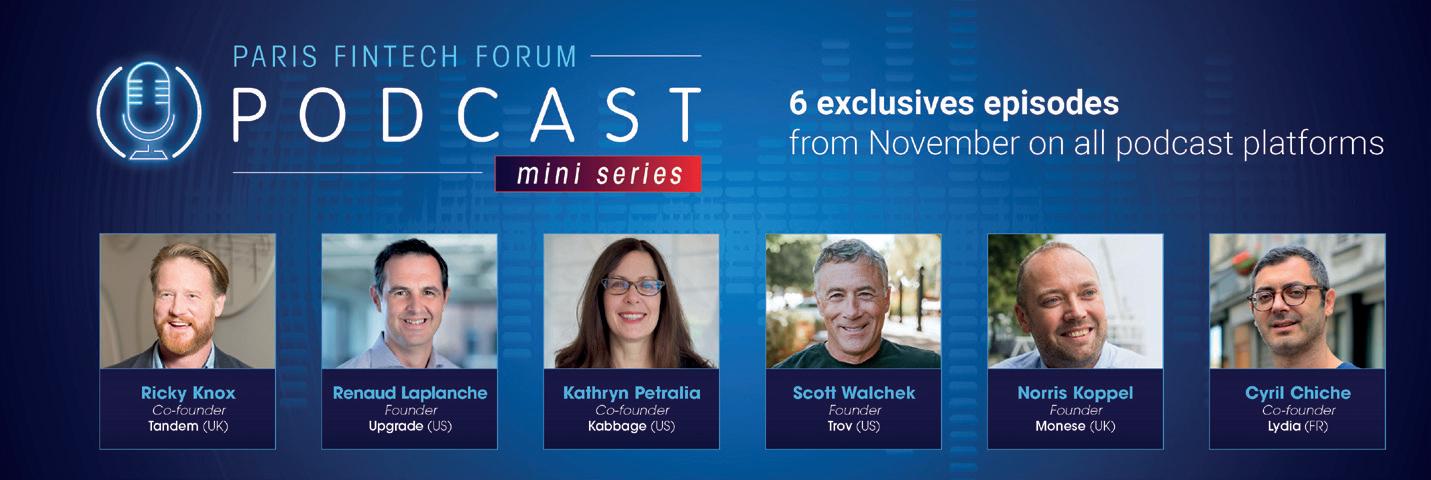
LN: It is more a kind of an un-podcast, to be honest. Take all the advice you learn from the best voices on podcasting, do the opposite and you’ll have an idea of what to expect.
There is no ‘long run and frequency’ as there are only six episodes broadcast over six weeks for the full season. They are not formatted, I adapt the discussion to each speaker. They are quite long, indeed episodes can run from one-and-a-half to three hours. And they are not suitable for commercials, as we are focussed on the life of entrepreneurs, not businesses. It is more an experience.
I am particularly grateful to our sponsors – Crédit Mutuel Arkea, BPC and Rise – who have supported my vision to conduct those in-person, very personal conversations, many in their homes, with high-level figures in our common fintech history. I had a lot of emotions doing that mini series.
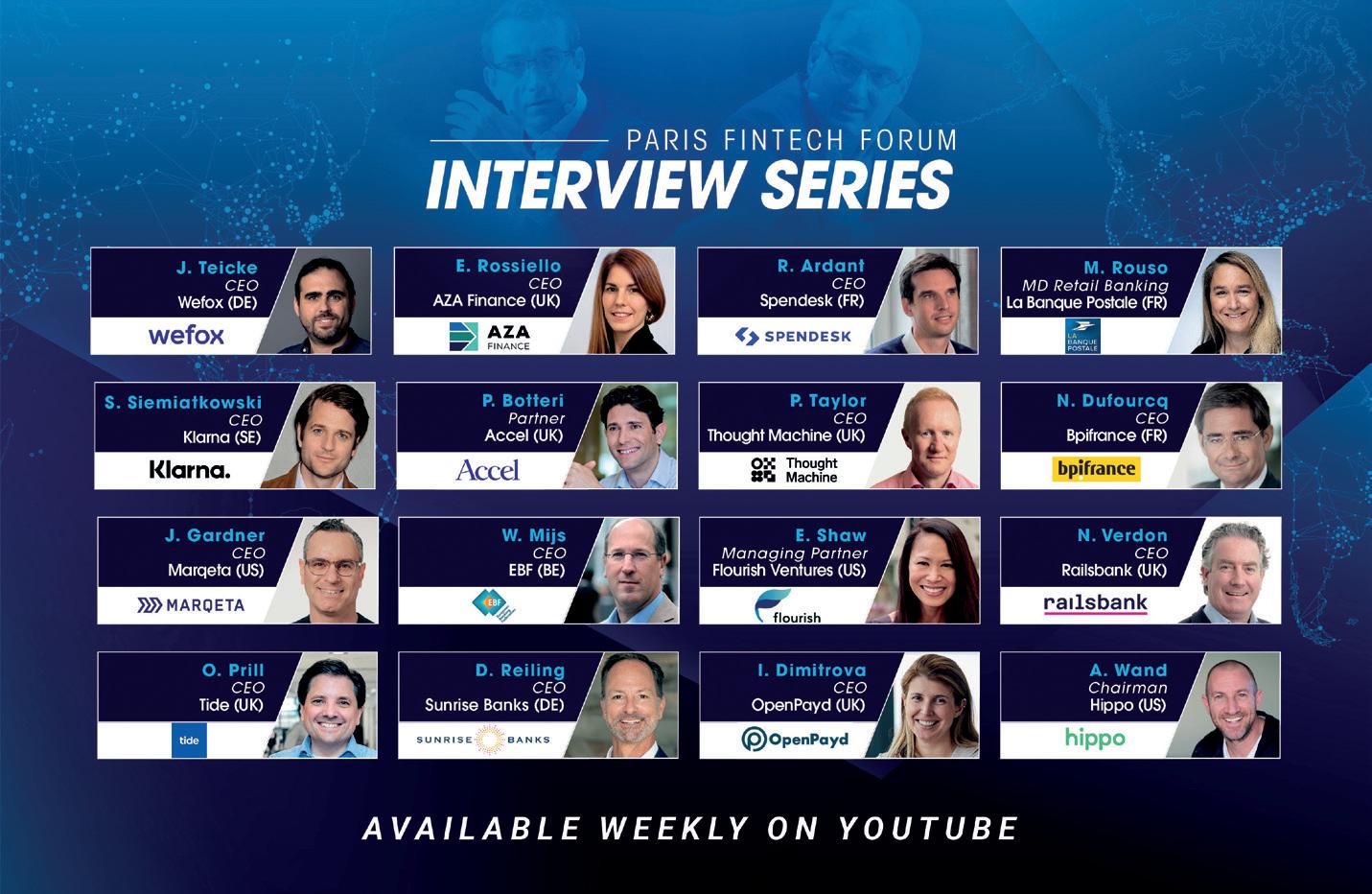
Huge thanks to our six tremendous featured guests, too: the founders of Lydia, Trov, Lending Club and Upgrade, Monese, Kabbage and Tandem.
The first episode will be available from November 9. I would love your feedback!
FF: Who were the other partners for that 2022 version of the PFF Communities?
LN: In addition to Crédit Mutuel Arkea, BPC and Rise, we had many banks, financial and other institutions that are very active in the fintech space, such as BNP Paribas, Société Générale, BPCE, Caisse des Depots, Banque de France, Mastercard, bpifrance, Orange Bank and Sunrise Banks. We also had the continuous support of tech and fintech players such as Rapyd, Banking Circle, IDNow, Thought Machine, Solaris Bank, Dreams Technology, Openpayd, Viva Wallet, and Sopra Banking Software, to name but a few.
Given all of the tragedy that COVID-19 has brought to the world, I am grateful to our partner base, which has stayed with us during our test-and-learn phase as we pivoted from an annual, in-person event to the Paris Fintech Forum Communities concept.
FF: So, this is the definitive version of Paris Fintech Forum – there will be no more annual events?
LN: Yes… and no! I do believe that we have entered a new era. How could we want to do the same thing as ‘before’ in a
world that is facing so many changes all at once. Let’s think about it for a minute: in 2020 the world shut down, like it never had before. And everyone can see that we are still in the aftermath of that, both in terms of business and our personal lives – even as a society. For months now we’ve had a war in Europe. We are also on the edge of what some expect to be the biggest recession in a century. No one really knows, but still, that’s the situation. And of course, the climate emergency and energy transition, even if not really new, is now a clear reality for all of us.
The world is still changing massively to adapt to this new reality, and it would take too long to outline how all these changes have impacted, or will impact, the international events industry if we do not transform ourselves. Also, our participants and partners were very appreciative of the innovation we applied to our own business and took advantage of less travel time and more opportunities for interaction.
So yes, this pivot – which was originally a reaction to the COVID crisis – has evolved into something unique and effective… something of which we are very proud!
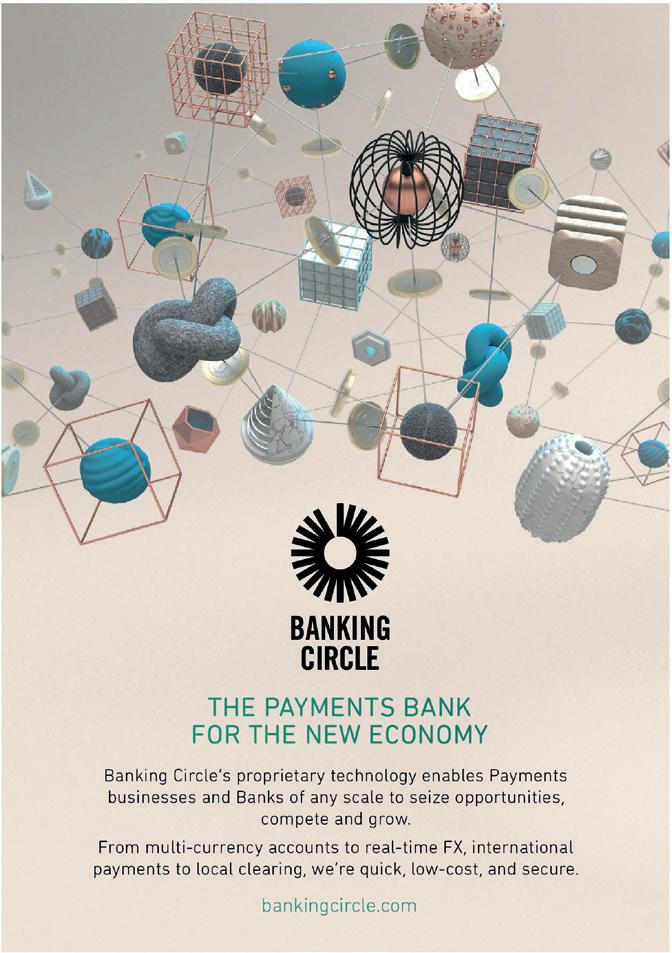
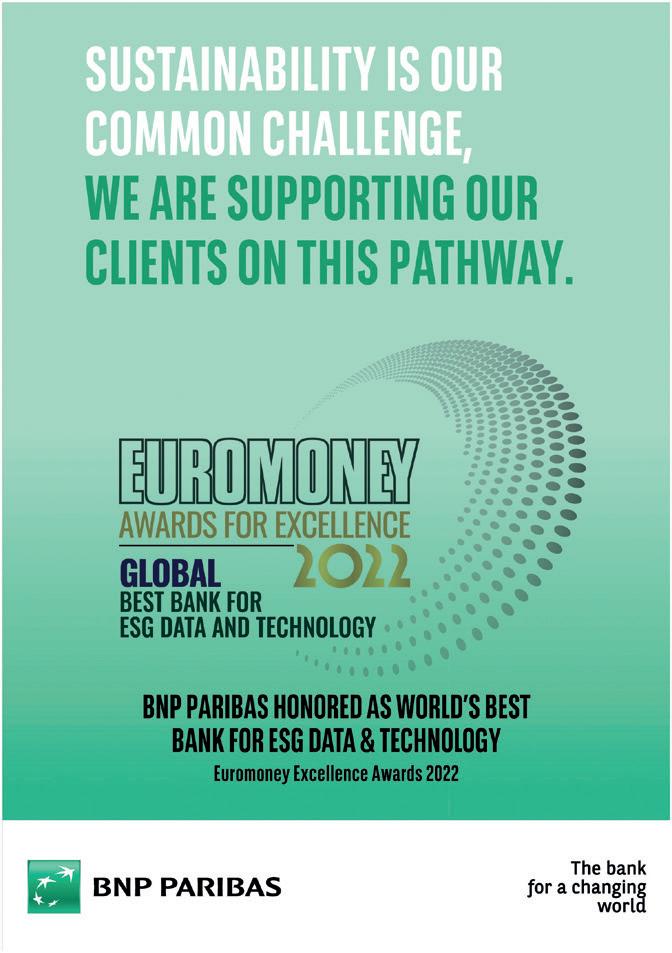
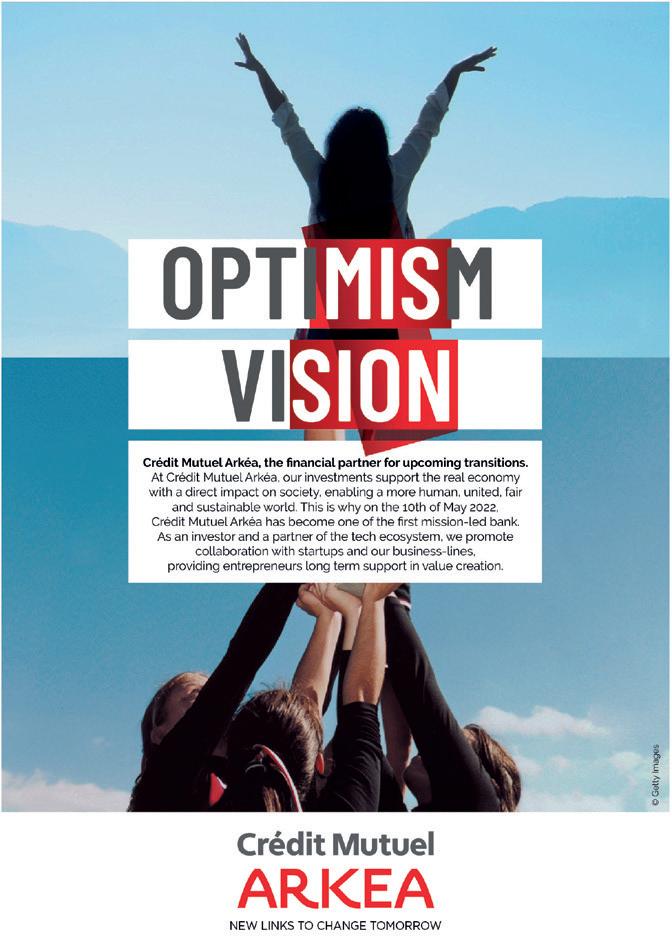
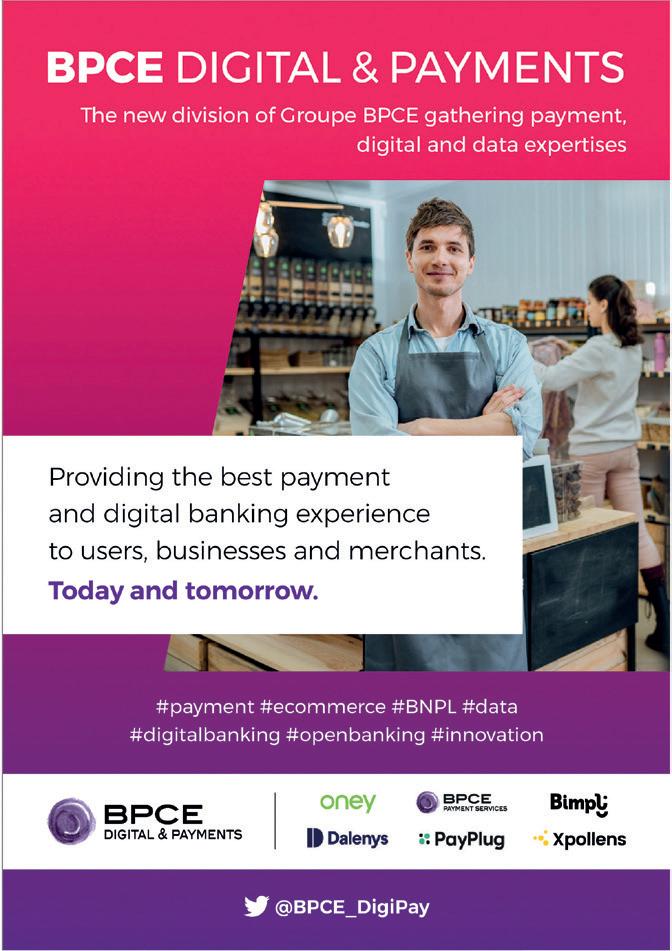
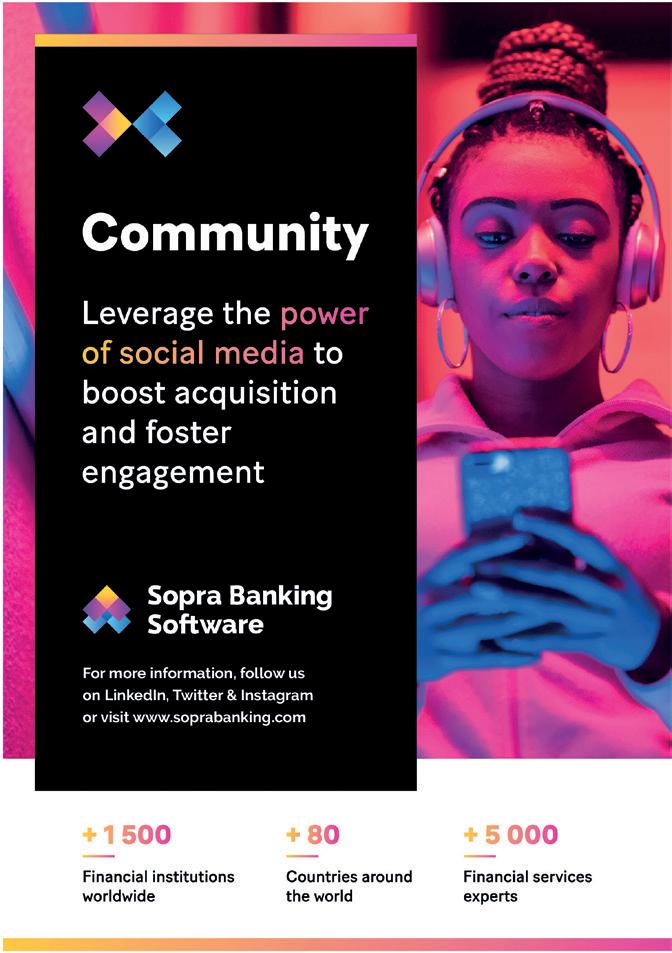


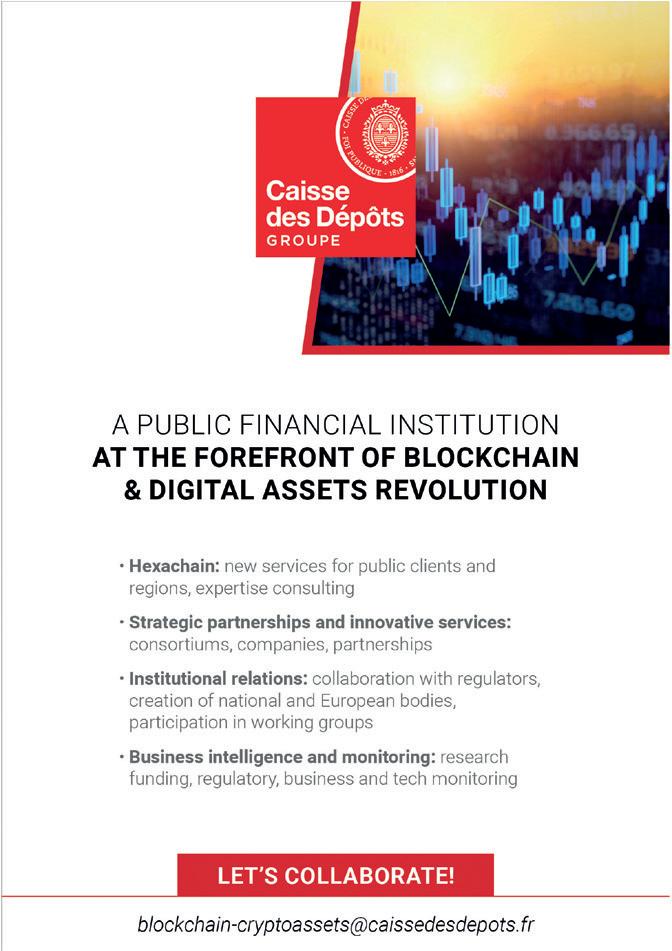
We worked a lot with our partners and community members to fine tune our future, and this future is the Paris Fintech Forum Communities – a collection of proprietary digital content and exclusive in-person networking events, held across the year.
That said, this new model is not static. One of the objectives is to be agile, to be able to adapt to the needs of our participants, speakers and partners, year after year, while being mindful of the global situation at the time we are making our decision.
I described previously what we are doing this year for the 2022 edition, which is not finished (we still have some major milestones coming up in the next few weeks).
Following the traction and success we had so far this year with that programme, we’ll be doing something similar globally next year, with one big addition.
We’ll host a two-day, international and very exclusive in-person event at the end of May 2023 in Paris. It’s called the #PFF Leaders Summit.
exchanges, with three stages of content and some networking lounges. No more exhibition halls or partner stages: it will be a very lean event.
This new model is not static. One of the objectives is to be agile, to be able to adapt to the needs of our participants, speakers and partners – year after year
FF: So, you have to tell us more about that. Will the #PFF Leaders Summit, part of your #PFF Communities 2023 agenda, be like the #PFF many of us remember? LN: Partly. It is a kind of reboot, a back-to-the-basics approach.
I do think that in this new normal, less is more. We no longer want to organise huge gatherings of thousands of people. So, this new event will, of course, share a lot of the successful fundamentals of the Paris Fintech Forum brought to the public: top level international speakers and attendees, a mix of all business verticals and company sizes (incumbents, fintech unicorns, start-ups, regulators), five-star venues and customer experience. It will be highly content-driven, with an extreme attention to details and, as before, it will have an international fintech selection pitches stage.
That’s for the common points. The rest will be quite different.
First, this event will be only and totally focussed on thought leadership and
Secondly, it will be very limited in attendance with around 100 speakers and 500 participants, plus a specific validation process to buy a ticket. To cut a long story short, aside from a few exceptions and the second half day of the event, which will be a bit more open, the idea is that most of the ticketholders could potentially be one of our speakers, or very close to. In other words, we’ll be very selective! Content sessions will, by the way, take that point into account to make them very interactive with the public. We’ll host a big networking party in the evening so our international participants can mingle with a bigger crowd. The third big difference is the date. For years we were the January fintech event. That was great for business (not so much competition at this period for us) but there was a bit less chance for attendees to enjoy Paris and make the most of it. We have a beautiful city where a lot of our attendees and partners are doing business nowadays. May is a much better month to organise side events, business meetings, company trips and to enjoy the city of light.
FF: Clearly that’s very different to what we were used to with your previous in-person events. Some more questions then on this #PFF Leaders Summit: will the PFF Communities’ annual ticketholders be able to access that event? Will the sessions be videocast and accessible on your platform? And where will that event be held?
LN: It will be a closed-door event with no video capture nor broadcast of the sessions. Maybe we’ll do it for the fintech pitches, we’ll see. However, even if we do not broadcast the sessions themselves, we’ll carry out dedicated studio interviews during the event that will be available exclusively on our platform.
Regarding the first question, as
mentioned previously, access to this event will have specific rules. So the #PFF Communities annual tickets will give you access to the #PFF Leaders party we’ll host during the event, but not to the #PFF Leaders’ Summit itself.
The #PFF Communities tickets also entitle our participants to a full year’s access to our exclusive content, our live and digital panels and speed meeting sessions, as well as the annual Paris Fintech Night. As to the venue where we’ll host that new event, let me keep some surprises for later.
FF: That sounds like a very ambitious and appealing programme for 2023. So could you wrap it up for our readers by reminding them of the key dates and information for next year?
LN: With pleasure. In 2023 we’ll organise five in-person events with different concepts and all of differing sizes: the #PFF Leaders’ Summit and the attached party in May, the Women In Finance Lunch and the Paris Fintech Night in October, and the Debate & Dinner in November. We’ll also host three live digital panels and speed meeting sessions in March, July and November to allow our members to access, in short sessions, the best fintech and digital finance speakers and also to allow them to network internationally from wherever they are.
Lastly, we’ll broadcast from March to December the third season of our famous weekly video interview series featuring top international leaders of the industry in straight-talking, exclusive interviews. And, depending on the success of our upcoming Fintech Founders podcast mini-series, I might also go back on the plane to record season two.
As you can see, our community will have a full programme of thought leadership, in-person and online networking, and all that spread over the year.
FF: To conclude, then, could you tell our readers how they can find out more about, and join, the #PFF Communities?
LN: Thank you Ali, always a pleasure. To enjoy the rest of the 2022 programme and be part of our 2023 plans as a member, a speaker or a partner, stay tuned for information and announcement on our website www.parisfintechforum.com and on Twitter @parisfinforum



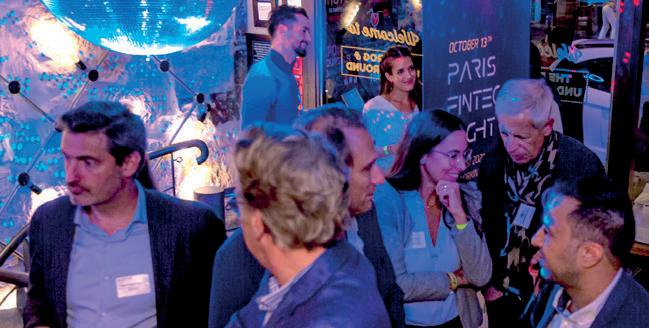




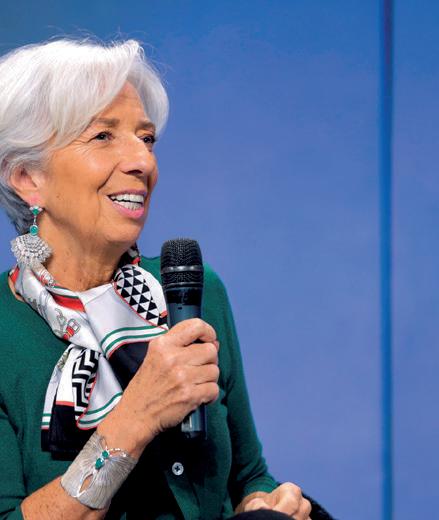

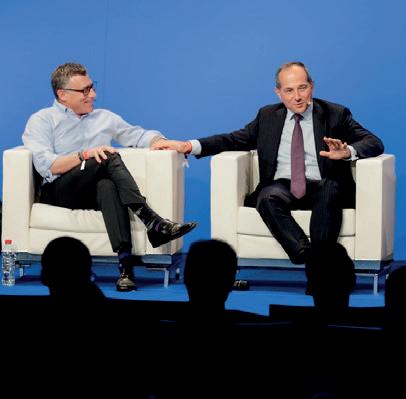


As Saudi Arabia starts its open banking journey, Grant Niven and Milon Veasey from Banque Saudi Fransi (BSF) reflect on what’s shaped the Kingdom’s approach and reveal the bank’s own pioneering BaaS strategy
Open banking is ramping up across the world’s markets, with different countries adopting different approaches that are typically either regulator-driven, as in the UK, or market-driven, like in the US.
Saudi Arabia, officially the Kingdom of Saudi Arabia (KSA), is one market to keep a close eye on. The Saudi Arabian Monetary Authority (SAMA) has announced the launch of its open banking framework, which is expected to go live in Q4 2022 with the release of account information services.
The initiative underlines the country’s commitment to diversifying its financial services sector, which is a primary objective of Saudi Vision 2030, a transformative economic and social reform blueprint that’s opening Saudi
Arabia up to the wider world. It’s seen as a significant step towards making the country a regional and global fintech hub. Open banking will cover all banking customers in Saudi Arabia, including individuals, SMEs and corporates. SAMA is now mandating all banks operating in the Kingdom to implement and support the initiative in compliance with the new KSA Open Banking standards.
Banque Saudi Fransi (BSF), which has its head office in Riyadh and regional offices in Jeddah, Riyadh and Al-Khobar, was more ready than most to take advantage of the new regime. It had already positioned itself as the go-to digital bank in Saudi Arabia, offering a comprehensive service to both domestic and international customers.
“I think even without the central bank mandating it, open banking would still have happened over time as influences from some of the other markets within the Gulf Cooperation Council (GCC) countries would have made their way into the KSA,” says Milon Veasey, head of open banking at BSF.


“But what SAMA, and the government in general, are doing very well is

accelerating the development of the fintech ecosystem and evolving the banking infrastructure to support it – this is super-positive and means open banking is another facet that becomes a catalyst for the market in general.

“In a regulatory-driven environment, you reduce barriers to entry for fintechs because you’ve standardised your application programming interfaces (APIs). So you develop once and it’s 95 per cent the same across all the different banks, and all the fintechs, the aggregators and all the players within the ecosystem can develop to that – that’s a massive advantage. The other big advantage is that when it’s mandated, all the banks have to participate. It ensures you have account information available from all the different banks.”
As well as taking on board learnings from others in the region, such as Bahrain, the first country in the Middle East and North Africa (MENA) region to adopt an open banking framework, SAMA has drawn inspiration from Europe.
“They’ve been looking at the UK in particular, as a bastion for being around the longest,” says Grant Niven, Head of Group Digital for BSF. “From a technical perspective, the UK Open Banking standards are probably the most robust and provide the greatest amount of flexibility in terms of developing new propositions. SAMA has taken that as
a baseline and is building on it for the KSA. They’re getting an early API specification-driven enablement and framework in place that should lead to a more robust environment going forward.”
Saudi Arabia is also taking notes on what others perhaps didn’t do so well – such as failing to engage in effective and comprehensive stakeholder communication programmes.
“In the UK, the regulator didn’t initially take a proactive approach in terms of an awareness campaign and just left the banks to start promoting it – not an ideal scenario and a big learning,” says Niven.


There are currently six million consumers and small businesses regularly using open banking in the UK, according to the Open Banking Implementation Entity – that’s a long way off the potential 40 million account holders who could, ultimately, benefit. But some surveys show only 14 per cent are confident they completely understand what open banking means – and what it can deliver for them.
infrastructure that can be leveraged by fintechs and other third-party providers (TPPs) that are keen to play in the financial services arena. Earlier this year, the bank designed its market strategy to ensure it will be a local leader when it comes to open banking and BaaS propositions, implementing its API Gateway via Cloud-native host Kong to create a scalable platform for its services.
In September, BSF launched APIZone within its Open Banking Technical Sandbox. In a move that aligns the bank nicely with SAMA’s timeline, APIZone facilitates fintech partnerships that will create new API-enabled products and services that can both be rolled out by the bank directly or as a BaaS proposition for brands wanting to offer financial services.
“We are encapsulating our API strategy within APIZone,” says Veasey. “And that clearly focusses on open banking and BaaS – eventually, APIZone will become a comprehensive catalogue of APIs that support different services we can provide through the bank. It’s really about exploring the different ways to launch secure, speedy new propositions into the market, either for direct customer acquisition or acquisition through partners, by leveraging our core infrastructure.
focussed on working with them for the implementation of our compliance platform,” explains Niven. “That’s, basically, all of the key modules required by a bank to support open banking in the marketplace, and we’re backing that with our own API Gateway that we’re developing all of the core services on.
“What we like about Tarabut is that it’s brought together a really talented team from various geographies to focus their skills on the MENA region. It’s good for us as a Middle East bank to be investing in a partnership with a Middle East fintech that’s really bought into the vision – its head hub is in the UAE, but the team has entered Saudi Arabia, done its research, got set up with the regulator and made it very easy for us to engage with them. It’s a nice story to see play out.”
BSF is starting small with embedded finance propositions to ensure it is ‘laser-focussed’ on excellent delivery. The end game is the creation of a white-label, plug-and-play banking solution, powered by BSF, similar to the Nexus BaaS solution that Standard Chartered has rolled out in Asia.
“In Saudi Arabia, we’re looking at doing a broad awareness campaign about what open banking is, and what the benefits are; a centrally-led campaign across the market, backed by each bank’s own campaign to its own customers directly,” says Niven. “This full-market approach, supported by all the key players, is crucial to providing consumers, who may be worried about their information and data, with a higher level of comfort.
“The exciting thing for the KSA is that the banks all have their head and heart behind open banking. In terms of a technology and readiness perspective, the banks are all there or thereabouts. At BSF, we’re very proactive in open banking and the banking-as-a-service (BaaS) sectors – it’s part of our overall strategy to lead in the digital space as best we can.”
BSF has invested heavily in technology and
“We’re also enabling both local and global fintechs to provide their services in Saudi Arabia using our licence, infrastructure and technology. The KSA is one of the most attractive jurisdictions for fintechs, specifically for remittance services, due to underlying demographics and untapped market potential. Ultimately, our aim is to bring global best practice propositions and competitive prices to Saudi customers – there’s a lot of opportunity for fintechs to enter the country in partnership with regulated entities like BSF. Fintechs should see banks like us as a partner rather than a competitor.”
To refine its proposition, BSF is working closely with open banking platform Tarabut Gateway, which provides platform-agnostic solutions to financial institutions and fintechs, allowing them to build their own apps to provide financial services. Tarabut Gateway has a presence in the UK, Bahrain and the United Arab Emirates as well as in the KSA, and works with regulators to enable data flow between banks and fintechs.
“Tarabut Gateway has a number of strategic arms to it, but we’re specifically
“Initially, our BaaS adventure will see us working with a select number of fintechs, and we have a roadmap that runs through remittances, foreign exchange, credit card and buy now, pay later (BNPL) propositions that we’ve identified as being central to our strategy, but also in demand in the market right now,” says Niven.
“But as our infrastructure and operating models build out across open banking and BaaS, our longer-term vision is providing a full-stack white-label portfolio to e-commerce and retail providers, encompassing current accounts, savings accounts, mortgages and so on. That’s the big bang for us, but first we test, learn and get our API structure spot on.”

The exciting thing for the Kingdom of Saudi Arabia is that the banks all have their head and heart behind open banking Grant Niven
In the Kingdom, open banking is a genuine catalyst for the fintech community, and enabler for banks to quickly and securely launch new propositions directly or via partnerships Milon Veasey
Open banking, APIs, platform economies… the consumer doesn’t need to know about any of them, but they’ll vote with their feet if established financial providers fail to whole-heartedly commit to what they deliver, says PensionBee’s Jasper Martens

PensionBee has been working industriously since 2017 to leverage open banking and digital technology to transform the way people think about and manage their retirement savings. But, five years on, it still rubs up against others’ legacy systems, as Leda Glyptis discovered when she talked to Jasper Martens, its chief marketing officer.
LEDA GLYPTIS: PensionBee is now a household name. Fifteen years ago, it would have been hard to imagine seeing adverts for a pension provider such as yourself on your daily commute. What has changed?
JASPER MARTENS: Two things. Because of auto enrolment, almost everyone with a job will now have a pension and, because people move jobs more than ever, it’s likely an individual will have many pensions from previous jobs. So, pensions are now much more front of mind. Combine this with the fact that technology, including open banking, makes pensions more accessible and visible – it eliminates paperwork and makes it easier to trace previous pension pots – and you have a perfect cocktail for engaging with savers who
want to take control of their pension and look forward to a happy retirement.
It’s fair to say that PensionBee has helped to transform the way other UK pension providers engage with their customers and we now see some incumbents innovating and new brands entering the market.
LG: Saving for retirement is daunting for many folks. How does technology enable you to serve your communities better?

JM: Especially in a time when inflation is rising and the cost of living is squeezing our daily budgets, it can be really difficult to think about tomorrow’s money when dealing with today’s money issues. But remember, almost everyone who works for a company has been saving into a pension every month for a while (thank you, auto enrolment!).
Locating your old pots is simply making visible what you’ve already got. That’s a different mindset and triggers most of us to take control, rather than confront the daunting task to ‘start saving’.
We estimate that around their 40th birthday, most people will start making an inventory of what they have saved. Back in the day, this was really hard and often done by a financial advisor. Technology has enabled you to do this yourself almost instantly, helping you
make informed decisions about what to do with these pensions. It provides easy tools to project a comfortable retirement and how well you are on track (or not) to achieving it. Technology also allows you to add more money into those pots easily.
Financial advice will still have its place when you need an expert view, but it increasingly won’t do the inventory and easy planning part. I compare it with travel agents: you wouldn’t plan a city break to Amsterdam through a travel agent, but you might well use one for a four-week trip through South America.
LG: If you had to explain a ‘digital’ pension to someone outside the industry, how would you bring it to life?
JM: A pension used to be this obscure piece of paper you got through the post once a year (if you were lucky). A digital pension is there when you want to see it, in the palm of your hand. It has a live pension balance, you can put money in, take money out (from the age of 55) – instantly. It’s a long-term savings account that sits alongside your current account, deposit accounts and other financial products.
Modern pensions allow you to see your tomorrow’s money today.
LG: Let’s talk about talent. Tech may be seen as a sexy industry but the ‘fin’ part generally isn’t! It means trying to attract and retain good people is a constant battle. How does solving the pensions problem play in this space?
JM: You’re right. Turning a cold purchase like a pension into a warm and exciting experience is hard! In order to attract talent you’ve got to offer a purpose (and an attractive pay packet to match).
At PensionBee we’re solving a problem for millions of UK pension savers. It’s a purpose that will get others on board. Mission is also important. An example is our Fossil Fuel-Free pension plan, a product that excludes investment in oil, gas and other environmentally damaging companies. Our customers asked for the product, it did not exist, so we built it (it took more than a year!). It’s not more profitable for PensionBee, but that doesn't matter: it's better for both our customers and the planet.
So, if you’re recruiting, you need to articulate both a purpose and a mission.
Another helpful way to attract talent is to offer everyone a stake in the business. At PensionBee, we don’t simply hire you, you become a co-owner. It’s not just another job, you’re part of the journey. It sounds cheesy, but it’s proven to be effective in retaining great talent.
LG: PensionBee is a very successful vertical play and yet the platform economy is important to you. How do you fit into that?
JM: Although a pension is an important part of your finances, it’s not the centrepiece. A bank account that receives salary and other regular income is the place where most of us manage our money. We feed into that, providing a holistic view of your finances. Your today’s money, such as your bank account and your credit card, is combined with your tomorrow’s money, your savings and investments.
We are not the platform, but we are essential to feed into others. We’ve been doing this since 2017 and an interesting by-product is that we’ve been able to welcome customers through marketplace arrangements. Not a lot of pension providers offer account visibility in platforms, so consumers are happy to transfer their pension somewhere that provides that level of connectivity.
LG: Looking ahead 15 years, what are the biggest challenges and opportunities for the sector?


JM: Let’s forget the buzzwords such as open banking and focus on solutions for consumers. Account visibility to provide a holistic view of your finances and easy
I believe that, in a few years, it will become less common to go to a comparison site… instead, providers will offer a product that’s tailored to you because of the insight you gave them into your financials
payments into your pension both run on open banking technology, but we don’t advertise it as an ‘open banking feature’. We’re not all financial technology experts so don’t treat consumers as if they are. Rather, providers should be offering them solutions.
I believe there are three other significant trends and challenges worth highlighting.
We still see quite a few established financial brands just doing the bare minimum to enable account connectivity or incorporate new solutions to make managing your finances easier. For example, we use open banking to make payments into your pension. However, some legacy banks simply won’t process them on a Sunday, so your payment fails. On paper, those banks
are part of the ‘open banking revolution’ but because of their ‘no-payment Sunday’ rule, we exclude them from our provider list.
Some APIs from banks are flimsy and you’ll end up fixing bugs that really should have been fixed by the bank in question. These things are not always down to ancient technology of incumbents, it’s mainly driven by the unwillingness to innovate. Banks need more than a token ‘head of innovation’ or ‘task force team’. That ship has sailed.
Although consumers are really sticky when it comes to staying with their bank or financial provider, I believe that, eventually, consumers will switch if their current provider does not change with the times. Once they leave, they are unlikely to return.
It’s still early days, but we are beginning to see some banks and money managers provide personalised recommendations to buy money and insurance products. I believe that, in a few years, it will become less common to go to a comparison site and compare your annual home or car insurance renewals. Instead, providers will offer a product that’s tailored to you because of the insight you gave them into your financials.
I recently switched from my mobile phone provider after 12 years because the money app I’m using analysed my monthly spend and subscription and benchmarked it against other providers. In 10 years, we will also be able to do this with pensions – I would hope!
With a little help from my friends was one of the few Beatles’ tunes on which drummer Ringo Starr took the vocal lead. Written specifically for him by bandmates John Lennon and Paul McCartney, they also helped Ringo hit that famously high final note in an all-night recording session. It went on to become one of the most successful pop songs of all time, included on a rock album that changed the music industry.
What does that have to do with fintech? Well, financial services providers, large and small, are also learning that chart-topping products are best achieved through collaboration. And that’s also altering the course of their industry.
Belgian-based expenses management app Tricount is a case in point. Designed as an app to make splitting expenses easier, it works like a shared Excel spreadsheet – crunching the numbers to balance costs and ensure that no-one over or underpays.
Its intelligent calculator can generate messages over chat or email, enabling friends and colleagues to enter expenses and then let them know who needs to pay what, or who they can expect payment from. It’s smart but not necessarily as smart as it could be because until recently, the only way of settling the balance was through sharing your IBAN or by using PayPal.
Now, through open banking, Tricount users in Belgium and Luxembourg can reimburse their friends by making a bank transfer within the app, thanks to some help from its partners – in this case,
banking-as-a-service provider Aion Bank, which runs on Cloud-native, fully API-based banking platform Vodeno, and payments giant Mastercard.
“It’s a good example of a partnership, where every one of us had his or her particular role,” explains Kim Van Esbroeck, country head for Belgium at Aion.
“There was Tricount, being the frontend application, having the community of several million users and being the face and the voice towards those users. Then, moving back in the chain, Aion and Vodeno provide the gateway to link the users in the Tricount application with the Mastercard open banking platform.
open banking and banking-as-a-service (BaaS) can help companies innovate.

Aion is hosted on the Cloud-based Vodeno platform, which provides core technology to banks and to electronic money institutions. It enables the bank to also offer BaaS options for other banks and non-banking entities, such as Tricount, alongside more traditional financial services.
The promise of BaaS is that it enables brands of all kinds to integrate financial services in their journey to make the life of consumers easier, says Van Esbroeck.
Kim Van Esbroeck, Aion Bank

“Mastercard serves as the backbone of everything and ensures that reach, so consumers can do payments among all Belgian banks, and, in the second phase, Luxembourg banks.
“We work together, in order to offer everything in a one-click user experience. So, at our end we have integrated three different parties, but for the consumer it’s a seamless, one-click experience to transfer money to their friends.”
Van Esbroeck hails the latest Tricount upgrade as a perfect example of how
“That’s what we do with Aion, in combining Vodeno, a fully Cloud-native, 100 per cent mobile, API-based technology provider, with the European banking licence of Aion. This combination of technology and banking licence makes it literally a bank in a box, offered to regulated players, but also to non-regulated players, that don’t have the expertise or the knowledge themselves but are, in that way, able to offer banking to customers.”
In Tricount’s case, open banking enabled the company to offer payments and focus on what it does best, without having to wrestle with the technology and regulation, says Jonathan Fallon, Tricount’s co-founder.
“We can focus on our core offering, which is good-looking, usable, simple, consumer-facing products, while not having to take responsibility for the more technical, regulatory work,” he explains. “We can have partners for that. It’s really important, as a start-up, to stay focussed on what you do well, and that’s precisely what we aim to do with this partnership.”
A partnership between Europe’s Aion Bank, its core banking provider Vodeno, Mastercard and expenses app Tricount is a textbook example of how playing to your strengths can deliver benefits for all
At our end, we have integrated three different parties, but for the consumer it’s a one-click experience to transfer money to their friends
It was a natural extension to offer a settlement feature from within the app.
“At Tricount, we have always been neutral, meaning we want to offer our service to a larger amount of people, so it was important to have something that was bank-agnostic,” Fallon says.
“Open banking and the revised Payment Services Directive (PSD2), in this context, seemed a promising fit. So it was with great enthusiasm we partnered with Aion, Vodeno and Mastercard to make it happen. And the success is there, we can see people are using it and it makes their finances easier to manage.”
This rapid evolution in co-operative financial services is also attracting the likes of more established industry players.
“Our philosophy is to look beyond just cards to what’s popping up and whether we can play an interesting role,” says Henri Dewaerheijd, country manager for Belgium and Luxembourg for Mastercard, which has been building an ecosystem of alternatives to its traditional card payments business for some time, much of it through partnerships.
Its recently expanded Mastercard Engage Partner Network aims to give businesses easy access to technology partners that can quickly build and deploy open banking solutions for payments and lending decisions at scale.

Meanwhile, its Fintech Express programme provides startup and emerging brands with a suite of tools and resources to enable them to innovate in payments and scale their business by leveraging the ‘power of partnerships’. Indeed, it was this very initiative that facilitated the latest Tricount launch.
“We see that technology is evolving very fast,” says Dewaerheijd. “There is regulation, there are new possibilities, whether that is with open banking, or whether that is with instant payments, where the card rails are not the only rails around anymore; there are other solutions that are interesting for consumers and are interesting for companies. And giving different solutions to the partners that we work with is our objective here.
It’s really important, as a startup, to stay focussed on what you do well, and that’s precisely what we aim to do with this partnership
Jonathan Fallon, Tricount

“We don’t want to rely on just one rail, we want to become a multi-rail company; open banking is one of those rails.”
Solutions enabled by open banking aren’t limited to payments, of course. Aion, for example, has used open banking to enable some of its clients to determine a consumer’s creditworthiness.
If a customer wants a loan, Aion can use open banking to fetch six months of payment history from an account, and then analyse and assess that data to help decide whether to grant the funds or not.
Helping hands: Working together promotes innovation and hence the delivery of new products
More exciting, and quite possibly revolutionary, is Aion’s project with German-based UnitPlus – a partnership that also involves their mutual friends at Mastercard.

UnitPlus’s unique selling point is that it lets customers put money in an exchange-traded funds (ETF) investment portfolio that is linked to a Mastercard debit card. This means UnitPlus customers can make payments directly from their investment account, breaking all the traditional rules of separation in banking.
“For the first time, we are linking a classic payment instrument – a Mastercard debit card – with an investment portfolio, where you have higher margins and higher yield, instead of the card being linked to money in a current account where it’s earning no interest at all,” explains Aion’s Van Esbroeck. “But you use the card just like you would an ordinary debit card.”
It includes an innovative ETF-back reward feature, too, which gives users 0.1 per cent of their purchase value back in ETFs to reinvest in their portfolio, the app keeping track of tax settlements and providing users with a view of deposits and withdrawals.
There are a growing number of use cases for leveraging open banking in sectors such as retail, where embedded payments and a smooth customer experience have been shown to increase revenue and boost spending per customer by two to five times. Payments are a key interaction point for many companies, and an obvious moment to reinforce brand messaging.
“People make payments every day and if you associate your brand with that transaction, you are a lot more top of mind, you are a lot more present, and that’s really important,” says Mastercard’s Dewaerheijd.
The key to opening up these various opportunities is BaaS.
“It is essentially the missing link to drive innovation in finance and payments. With BaaS, you don’t have to be a bank to be in payments. This is the big revolution,” says Dewaerheijd. “With BaaS – which essentially socialises the investment in infrastructure and the licensing part – the hurdle to launch your own solution is a lot lower.

“A lot of companies can now get into the market with a Mastercard and an IBAN account, in a matter of months. That’s really innovation at warp speed.”
What remains to be seen is whether banks embrace this model where the
backend and frontend are often essentially run by different partners. But doing so could help them innovate their own services for both their own and their customers’ benefit, says Dewaerheijd.
“Banks are very dependent on their legacy. Their IT roadmap today is dominated by compliance, by regulatory products and they essentially don’t bring a lot of value to their clients. So, instead of having banks in Europe working on the next iteration of PSD3, this could be socialised, leveraging BaaS, and banks could free up that time to work on innovation, on things that really matter for their clients, which is usability and frontend services.”
Banks – both the long-established incumbents and their digital challengers – could also benefit from a return on their investment into technology by making it available to others.

now being available, there is a notable upshift in quality, too.
“If you had to do a PSD2 payment 18 months ago, you’d have needed your card reader, you would have needed a lot of complexity that would actually make the use case barely usable. It was a challenge for the project we implemented,” says Fallon. “So, beyond the fact that there are more product offerings, the quality has really improved. That’s important for start-ups that are really focussed on the user-interface.”
BaaS also allows players – be it a startup who desires to become a fintech, or a large corporation wanting to offer banking products – to move faster and experiment more.
“For a startup in particular, it’s very important to find your product’s market fit fast, so this will really help foster innovation,” adds Fallon. It also reduces risk and development cost.
So, overall, Fallon’s advice to other companies moving into payments and financial services is not to reinvent the wheel, but take advantage of the expertise in delivering services that already exist.
“What we’re seeing in our market, is essentially a squeezing out of the smaller players, because they have difficulty following the arms race with regards to technology investment,” says Dewaerheijd. “So is there an intelligent play here, where you keep your core, you keep your positioning towards your client base, but you are able to leverage BaaS to socialise a lot of your investment.”
However to do that, banks need to be ‘reachable’ and outsource a complete financial services package, adds Aion’s Van Esbroeck. Clients must be able to reach the bank through APIs and issue cards, grant loans, etc, on demand. She warns a lot of work still needs to be done on that front.
“A lot of traditional banks are not even at that point of delivery of their own services. Banks who have the ambition to go into that area really have to focus on technology.”
Time is increasingly of the essence and this is where BaaS proves invaluable, Tricount’s Fallon points out. As well as more products
“You have banking players that are good at what they do. As a start-up, or another company, with another core business, you are good at what you do. Focus on your UX, your simplicity. Make sure you are not becoming another company that has to fit to complex banking regulation, technical banking flows,” he says.
Tricount’s in-app settlement feature is only available to customers in Belgium and Luxembourg at present, but the company is seeing strong interest for it
among users in Spain, too. No doubt, it will soon be looking to buddy up with a local partner there to create solutions that make consumers’ hearts sing.
BaaS essentially socialises the investment in infrastructure and licensing – the hurdle to launch your own solution is a lot lower Henri Dewaerheijd, Mastercard

Dharmesh Mistry, CEO of AskHomey, an app that stores and organises all a home's key information, and Maria Harris, Chair of the UK’s HBSG Technology Working Group, which is creating a data standard to be used in home buying, look at how open banking has paved the way for something much more exciting

The landscape for banking is constantly changing, yet it seems banks themselves are slow to change.
New competitors, both fintechs and neobanks, are innovating and capturing customers who have been forced to use digital channels – not only driven by COVID, but also by the acceleration of branch closures and worsening telephone banking response times.
In the 90s, banks targeted answering calls within three rings, these days I’d be happy to be only third in the queue!
At the same time as open banking regulation was introduced to drive more competition, privacy laws have become increasingly stringent to protect customer data and to ensure customers know how their data is being used.
As I see it, there are four key challenges for banks – which are probably underestimated by most people outside of the industry when they are comparing legacy providers’ measured pace with innovators’ haste – as well as a big opportunity as they move from open banking to open finance on the journey towards open data.


So, why is it that banks seem to lag in innovation? What is it that allows neobanks to compete with them, head on, and for fintechs to reinvent individual product lines and capture customers from banks? It’s not that ‘banks don’t know how to innovate’ or that ‘senior management are risk adverse’. There is no simple answer, the picture is complex and not the same across banks. The four key things presenting a challenge to banks in driving innovation are:
The larger a bank is, the more silos it will have. These silos can be a multitude of things:
■ Reach – banks that are located in many countries often have geographic silos, managed in country or part of a region, like Europe
■ Brand – sometimes brand is used to focus on specific segments like wealth, or product lines, like mortgages
■ Customer segments – for example, retail banking, business banking and wealth management, each offering quite different product lines
■ Product – often each product line is a separate organisation, like cards, mortgages, accounts
■ Channels – internet, branch and telephone banking are separate departments and sometimes even separate companies, e.g. First Direct for HSBC
■ Processes – like fraud, AML/KYC, origination, onboarding
So, it’s no wonder that the ‘single customer view’ (knowing all the products and interaction a customer has with the bank) is something that still escapes the ability of many of them to see.
The organisational separation of silos is one of the biggest challenges for banks. For them to think about owning end-to-end customer journeys, crossing internal silos will be a big hurdle and, as such, it may be time to restructure for the digital era. It is also something that fintech’s and neobanks will only
face once they scale and are compelled to extend to different product lines, channels and customer segments. Such ‘growing pains’ are almost inevitable.
Larger banks do invest in innovation in many ways, from funding start-ups, to running hackathons or partnering. Many have innovation teams looking at new technologies and trends. Innovation is generally measured by how successful it is and that generally means customer adoption. As tech strategist Geoffrey Moore wrote in his seminal book Inside The Tornado, technology adoption takes time, starting with innovators and moving to early adopters, then early majority, late majority and finally the laggards.
Even mobile banking has taken 15 years to reach mass market (when more than 50 per cent of the customers use the technology). So, whilst innovation can be quick, it can also be many years before it is widely used. This can present a challenge when a business case to fund investment into the innovation is based on the standard five-year plan.
For example, what would it take for the mass market to adopt the metaverse? I would argue that the experience needs to be close to life, something very hard to distinguish from the real world and not the gaming graphics we have today. This could be 15 years away; hence, it might be well over a decade before any bank makes a return on any investment in it. Hence, financing innovation can be a challenge.
The third big challenge I see is regulation, not only the many different and evolving rules being introduced, but also how some can seem to contradict others.
On the one hand, we have open banking freeing up (with customer permission) customer data; on the other, we have the General Data Protection Regulation (GDPR), trying to protect customer data.
We’ll soon have open finance, which frees up access to a broader range of data for non-bank-account-based financial products. However, in open banking we saw great innovation of customer experience and especially in onboarding new customers, whereas most of these types of product require advice and have strict rules about how they are sold and to whom.
The last and most obvious challenge: the technology landscape is vast in breadth and at the same time maturing rapidly in depth for a single technology. Take something like AI, often a single line item but which now has many subtopics focussed on increasingly specialised aspects of it. Multiply this by the silos in a bank and the challenge quickly exacerbates.
So, in defence of banks innovation is complex and difficult. The scope and breadth for innovation is huge but that itself creates a challenge to prioritise and fund projects. That said, a focussed approach is possible, as Claire Calmejane has shown both at Lloyds and Société Genéralé ,where she has overseen innovation. Her approach was to align innovation to each of the bank’s core goals. Another way to do this is to start from the future and work backwards, focussing on banks’ key asset… data.
Given the challenges, it’s natural that innovation in most banks simply drives improvements in existing products and processes. However, innovation that changes a business model will have the biggest impact. I believe the next biggest change is already occurring and that the impact of that change will fundamentally reshape banking.

providing banking-as-a-service (BaaS).
Larger banks will be able to do both, while smaller banks may have to choose between one or the other, based on their resources.
We’ve already seen a huge consolidation of banks and, going forward we will see even more as providing banking products and services becomes a race to scales, to achieve the lowest cost and best product flexibility. This will require BaaS providers to develop or adopt modern banking cores that are Cloud-native and open. The granularity of services offered will allow these banks to attract a broader set of partners/customers for BaaS than fintechs alone.
Another key factor for successful BaaS will be the ability for new products to be created easily, quickly and without limitations on features. One solution to this challenge is to support programmable products to allow partners to extend core system capability without constraint from the core system itself. We are already seeing this possibility enabled through technologies like smart contracts.
On the distribution side, we have seen expansion as neobanks and fintechs pick off products and customers segments. Today, there are banks that focus on the needs of immigrant communities, musicians, truck drivers, the LBGTQI+ community and many more. To date, there has been little innovation in banking products/services specific to those segments, their differentiation largely coming from content and marketing focus. However, we are starting to see the green shoots of the next generation in this space that will leverage a broader trend… open data.
It will always be the case that only banks can create and operate banking products because that’s what regulators dictate. However, the change that open banking has brought is that anyone with customer permission can use banking data to improve a customer experience.
They may go further with embedded banking and partner with a bank to provide banking services. Hence, increasingly, we have seen the bifurcation of banking – a splitting of roles between distributors that are innovating the customers’ experience, and banks that focus on
Outside of financial services, there are open data projects in many other sectors such as real estate, healthcare, and utilities. Some of these projects have benefitted from seeing open banking in action, so not only has open banking had global influence in finance but also in cross-vertical initiatives.
Often these projects will refer to the way that open banking operates to justify/prove their own solutions. And the players interested in these individual open data initiatives largely come from within their own industries. They are operating in silos similar to the banks’.
However, in UK real estate, something interesting is happening.
Not only has open banking had global influence in banking but also in cross-vertical open data initiatives Dharmesh Mistry, AskHomey
This is an industry that demonstrates how open data projects can enable customer journeys to seamlessly span verticals and enable multiple parties to exchange data to facilitate that in a safe and secure way.


Today, the process of buying a house in the UK is largely manual and paper-based. Once a buyer’s offer is accepted the buyer’s solicitor gathers information about the property to inform the buyer. This can take several weeks. If the buyer pulls out, the entire process is restarted for a new buyer. This highly inefficient process can take months, especially if there is a chain of buyers and sellers, trying to complete their purchase on the same day.
The process involves many parties: estate agent, solicitors, mortgage broker, surveyor and lender. Each party will have to validate the identity and perform know your customer (KYC) checks.
As information is gathered, it often needs to be shared with another party and this is done through post or email or by rekeying on to multiple systems. On average, the process now takes 126 days. It’s no wonder almost a third of sales fall through. Every failed sale costs the buyer on average £2,700 which means up to £1billion is lost every year.
The UK government and industry collaboration group, Home Buying and Selling Group (HBSG), was set up to improve this inefficient process. It aims to do this through digitisation, which presents an opportunity to re-think how properties are bought/sold. The first output from the group is a new data standard, including the BASPI (Buying and Selling Property Information), which provides a single source of truth for property transactions.
In redesigning the process, the group has put responsibility for producing a digital property pack onto the seller, so a pack of upfront information is produced once and shared with any buyer. This not only reduces the time to complete but also saves duplication of effort if a buyer falls through, for whatever reason.
Whilst conceptually similar to the Home Information Packs that were introduced in 2003 and subsequently scrapped, the key difference now is that property information is digitised. By digitising the data, it can not only be exchanged more easily, it can also be understood by software that can automate the process.
To enable this to happen safely, the group is introducing a property trust framework, based on the four data principles that make up FAIR (Findable, Accessible, Interoperable, Reusable):
■ Findable: Data is digitally formatted, using an open industry standard and stored on modern systems with meta data to describe it in a richer context. This enables property data to be searchable by a machine.
■ Accessible: The trust framework is open, freely available, and agnostic to any specific or proprietary technologies. It can be operated peer-to-peer (data can be exchanged directly between two parties) or via a network
It’s very clear that this development will bring about the same kind of innovation and improvements that open banking has provided for financial services. What is compelling about this work is that it shows how players from different verticals can come together to create not only an open data standard but also a framework for exchanging that data safely. Such a trust framework is necessary because, unlike with open banking, which exists in an industry vertical where the data is trusted because it comes from a bank, many different parties from different industries are involved in conveyancing.
We believe that the full implementation of the work of the HBSG will revolutionise property transactions, dragging an industry that lags others in digitisation and the exploitation of technology generally into a new era of automation and intelligence. And just as open banking has influenced other open data projects, the trust framework will also influence other cross-industry opportunities.
So, to conclude, open banking has shown:
■ Customers want to get value from their data and are willing to share it with third parties
■ Data can be exchanged, with customer permission, in a safe and secure way
that simplifies the connectivity of multiple parties on one transaction.
■ Interoperable: An open API and data standard, based on common data dictionaries and published schemas, allows all parties to exchange data easily across APIs, regardless of the platform used.
■ Re-usable: The trust framework ensures that there is full data provenance: the source or provider of the data is recorded and auditable to engender transparency and trust of the data so that it can be reused rather than re-sourced by different parties.
The BASPI is on its third published iteration while work on the trust framework is continuing. Early pilots of the trust framework have already demonstrated both peer-to-peer and network exchanges of the data between different third parties. And those involved have already gone further than exchanging data by introducing automation, for example for the collation of property search data.
■ Making data available openly will drive innovation
■ Open technologies are available now and don’t require extensive funding or proprietary skills/tools to use them
Open finance moves this on by drawing on financial data from a broader product set. But open data will have a much larger impact as it brings huge opportunities to drive innovation across verticals – because most major customer journeys, and especially life stage events, will involve multiple verticals and parties.
Co-author: Maria HarrisMaria Harris is responsible for creating a data standard for property sales and implementing an open data trust framework that can be used by many actors from different vertical involved in the home buying process. Maria has strong track record in this space, having launched digital mortgages with Atom bank and has also being involved at the outset of open banking.

The work of the HBSG will revolutionise property transactions, dragging an industry that lags others in digitisation into a new era of automation and intelligence
Maria Harris, HBSG
Giesecke+Devrient’s


Inclusive capital – the notion that finance providers can unlock sustainable new revenue by improving access to finance to the most underserved, while enabling a fairer and inclusive contribution to society by all – may seem philosophical, even a little whimsical for some.
But history tells us that philosophical ideas can indeed change the world, although the world must also want to change for those ideas to become real and embedded.
Current times of restricted growth and a need for more impactful business support have evidenced that inclusive capital has never been more important. For too long, finance providers have held on to traditional methodologies of control, managing cost, risk management, and, dare I say, discriminatory decision making, based upon ‘higher risk applications that don’t meet our profile’.
This is not to say that, in most cases, lending and investment decisions have not been made with sound logic and reason. No matter how morally, socially, or ethically-minded they are, finance providers are in the business
of generating sustainable net margin returns, after all. So, it is fair that they must make the most practical and appropriate decisions for both the potential recipient of funds and the funder themselves.
But, in order to survive in a postpandemic economy, the deployment of capital must have a multiplier effect that not only transcends the bottom line, but also attracts new investment markets, based on a sincere appreciation and integration of those customers’ needs within the capital deployment process.
The latter is even more important, as historical financial risk models that aligned with best-performing customer profiles have been severely disrupted. The impact of the global pandemic has now made it more difficult for banks to predict what type of businesses are the best propositions to invest into, or divest from, for the future.
This increases widespread risk, impending losses and reduces the opportunity for underserved businesses to contribute to local, regional and global economic growth fairly and inclusively.
Even with the £80billion-plus of public finance being made available by the government during the pandemic in the UK, the impact of the current cost of living and energy crisis for business owners has increased the challenge of securing access to finance for underserved businesses – often classified as those that are owned or founded by women, or by anyone belonging to a black or ethnic minority group, or a disabled person; green or climate-focussed businesses; social enterprises and charities.
But they can also include high-growth

businesses that may not fall under the categories above, and yet, alas, find themselves unable to raise the growth finance they require – between £500,000 and £2million on average.
Within financial organisations, there is still a reluctance to move away from the use of manual processes and legacy technologies. In addition, there is still an addictive tendency among finance providers to rely on making decisions through historical lending performance and investment models, which perpetuates a culture of bias. But if finance providers genuinely wish to do more, then a more committed focus towards inclusive capital offers a new Nirvana of growth for all.
Inclusive capital offers a gateway to accelerate the redevelopment of our economy in a post-pandemic world, by adapting traditional access to finance models through better data intelligence on the health and performance of underserved businesses.
Such intelligence can also be used to help influence governance and policy, evidencing best practice and impact that can help both finance providers and underserved businesses together. What is needed is a framework to work from.
In our business, we have embraced an emerging and inclusive model of innovation that is set to impact the finance providers and the financial services sector. I have called it ‘The Triple D Effect.’
Traditional finance providers want to do more but know that their traditional and



As Founder of The GFA Exchange, Joel Blake, OBE, wants to light the fire of inclusive capital for underserved SMEs in the UK
historical model of assessing lending, investment and credit risk is not designed to embrace the perceived higher risk attached to more diverse and underserved business.
The Triple D Effect is made up of three distinct, but interconnected elements: diverse data, diverse intelligence, and diverse (by which I mean digital) technologies. In combination, they have a network effect that can truly boost financial inclusion, through the deployment of inclusive capital.
The data used in financial services to drive decision-making is not diverse in its creation. In many cases, organisations use the same or similar data sources or models, from credit reference agencies to data providers, etc, which drives an unconscious level of industry group think and cultural bias. This often results in the creation of client portfolios that are derived from a narrower set of criteria that is relevant to their own business needs.
A portfolio made up of diverse businesses, run by people from diverse backgrounds, can help to generate a more inclusive portfolio, which is more representative of society. But the ability to access real-life insight on the health and performance of these types of business is often out of reach for finance providers.

By combining all the business health and performance information gained from those individual businesses in your portfolio, it becomes easier to understand better the ecosystem they are all a part of, and how they are positioned to survive within it.
No organisation wishes to lend or invest in a business that is not healthy and growing. Therefore, the more diverse your data sources are, within the context of business health and performance, the better opportunity you have to unlock insights and unique trends that were previously hidden.
In turn, the more diverse and inclusive intelligence you can unlock, the
greater insight you can generate on the operational capability of the businesses, and a more realistic, predictive model of their future ability to grow.
This gives you better confidence to take more risks and can help you make more informed decisions on how you choose to deploy capital, to diversify your client base, and increase revenue opportunities, whilst improving financial inclusion for a much wider market.
The impact of the pandemic has led to finance providers having to revisit their previous visions of their purpose and role within markets and in society.
It is also fair to say that government intervention to provide lending support for businesses during the pandemic was welcomed and re-ignited the importance of collaborative partnership working when unprecedented unsustainability affects us all.
capital models, because you are no longer restricted by historical traditional mindsets.
It is through the development of diverse technologies, born out of diverse partnerships, where the needs of underserved businesses can be factored into the build of said technologies, which cater to a new and inclusive world of business and job creation.
In summary, with greater diversity of data, you can generate richer and more diverse levels of intelligence. When applied with innovative digital technologies, this will unlock new models of capital deployment and open fair market opportunities for all business, regardless of the differences they may have, thus, providing long-term sustainable business models for all.
The Triple D Effect is not a theory of tomorrow – the pandemic has already highlighted that the data, intelligence and technology revolution is here. The unwritten social contract between capitalists and society at large is at risk ] of continued disruption if the needs of all business founders and leaders in society are not considered. The fair deployment of capital to these is vital to this process.
But the opportunity to leverage effective and sustainable partnerships is where diverse technologies can add significant value to drive inclusive capital objectives.
Digital technologies offer the opportunity to reduce both financial and operational risk, improve cost efficiencies and unlock innovation within processes, systems and in the delivery of customer value. Once you combine diverse intelligence with innovative diverse technologies, you begin to develop the new frontier of inclusion – inclusive partnerships can truly give birth to inclusive
But it would be remiss if I did not state that there is some level of responsibility and accountability that underserved businesses must bear, too. Capital is attracted to healthy, growing businesses and so there is a need to ensure that the business in question is being run to reach the best of its potential as best as one can – in doing so, it makes it easier to evidence the case for good and sustainable receipts of capital. Real success is founded in balance, not entitlement.
I do fear that while the notion of financial inclusion is one that is welcomed by many, it is not being fairly executed by all. But in a post-pandemic economy, every business should be entitled to the fair and just opportunity to access the resources that they need to grow. We are dedicated and committed to this at The GFA Exchange by reducing risk for finance providers who seek to be more inclusive.
If finance providers genuinely wish to do more… inclusive capital offers a gateway to accelerate the redevelopment of our economy in a post-pandemic world


SimplyPayMe is a case study in how the next generation of providers is able to respond to the needs of one of the world’s biggest, yet the least understood and most under-served business markets – SMEs
SMEs and sole traders often experience challenges in traditional banking. There is a lack of products tailored to their needs and they often have to use time-consuming manual platforms to upload their data.


Meanwhile,many financial providers struggle to serve this complex market and, with minimal ability to view a business’s financial position, they find it difficult to secure SME financing.
As SMEs continue to grow worldwide at an average rate of 7.1 per cent a year, the demand for digital-first solutions with automated tools to remedy this mismatch is rapidly increasing. This has been a growing opportunity for fintech companies, with payment technologies being introduced that allow an expansive ecosystem to develop, stimulating further growth of the market.
One of the best examples of operators to emerge in this new sector is the award-winning global payments company, SimplyPayMe. It provides SMEs with a personalised
invoicing solution, core banking services and digital tools that enable small to medium-sized businesses to take control of their finances.
SimplyPayMe’s disruptive payment technology and fully-fledged payment, invoicing and software solutions provide a complete payments infrastructure over a Cloud-based platform, allowing its customers’ clients to run their businesses and get paid from a single application – and all through a smartphone.

Like many startups, SimplyPayMe was originally a B2C company that pivoted to a B2C2B model, but its core objectives remained constant: to research and develop technology solutions that are fully integrated into the financial
As SMEs grow worldwide, demand for digital-first solutions with automated tools is rapidly increasing. SimplyPayMe is demonstrating how they can be helped to find their full potential
ecosystem. These allow enterprises to deliver merchant services such as invoicing, point-of-sale, PayLink, quotes, status reports, paperless receipts, and more via multiple integrated payment processors, which has been achieved by SimplyPayMe onboarding APIs in an unprecedented way.
Fully digital businesses, like SimplyPayMe are able to focus energy and resources on providing the best no-hardware solutions – in this case, saving SMEs money while improving access to the financial ecosystem, all the while delivering a great customer experience.
These new fintechs were born with a partnership mindset and scalable technology – SimplyPayMe is already building relationships with North American and European key partners with the aim to create an even larger SME ecosystem.
These collaborations will provide individual software solutions and an all-in-one, innovative platform, facilitating on-the-go payments, removing hardware, card readers and provider accounts, and offering complete financial inclusion for SMEs, through integrations with Paysafe (US) and DNA Payments (UK). Ultimately, the app will open payment features for SMEs where cash is often the only payment option.
In this digital-smart era for SMEs, SimplyPayMe is demonstrating how businesses in a largely overlooked and vastly underserved sector can be helped to find their full potential.
Boxed in: The sluggish nature of cross-border payments continues to hamper many SMEs

As head of Mastercard Cross-Border Services, Stephen Grainger is aware that banks struggle to meet the evermore specific needs of individual business customers. But a re-purposed payments network can…

For many SMEs, the fact that cross-border payments networks kept running during the worst of the pandemic was a lifeline.
Nearly three-quarters of the 3,000 surveyed for Mastercard’s 2022 Borderless Payments Report, said they’d been forced to look abroad as their traditional domestic markets and supply chains dried up – and their businesses often benefitted as a result.
But while Mastercard found 58 per cent of SMEs are making use of cross-border payment networks more than they were three years ago, that’s not to say it’s easy.
Thirty-nine per cent complained that the current state of cross-border payments slows down their supply
chain; 36 per cent wanted more transparency on how much money they were losing to FX and transfer costs; while a quarter said off-shore suppliers had refused to work with them because of uncertainty over when a payment would hit their bank.
Countless studies point to international trade being a stimulus for business growth. Most recently, InterTradeIreland’s Business Monitor survey (Q2 2022) revealed that SMEs that export are twice as likely to experience strong growth as those that do not.
But in August, the World Economic Forum said SMEs are ‘in urgent need of digital infrastructure, training and processes’ if they are to take advantage
of the global opportunity, and urged governments to simplify tax and customs procedures to help them.
It echoed concerns already expressed by the G20 group of nations. In 2020, the G20 signalled they would address payment issues specifically, including transparency, cost, speed and access to cross-border rails.
The group set targets for their payment providers to deliver improvements by the end of 2027, including clear, up-front information on transaction costs and the time taken to deliver funds.
Stephen Grainger, an executive vice president at Mastercard, welcomes the intervention by national and supra-national bodies, because SMEs’
cross-border trading problems aren’t in the gift of one industry to solve.
“While we’re striving for cheaper, better and faster, cross-border payments [compared to domestic payments] involve a lot more work,” he says.
“You’re effectively moving money from one domestic scheme into another, with all the regulation and rules wrapped around that. Accountablility for making those improvements happen exists at the exit point from a scheme and arises at the entry point.
“It also manifests on the person – the individual, the group, the fintech, the financial institution or whoever – who’s managing it in the middle.
“The removal of some of the frictions – be it around financial crime compliance, provisioning of tax services, FX, etc –requires real change.”
That said, Grainger believes, banks in particular can help ease the pain for SMES, and provide the most appropriate service for their specific cross-border payment use case – be that paying international suppliers, sending earnings to global workers or paying salaries to overseas recipients.
And, in his opinion, the most effective way for them to do that is by working with a third party.
"We’re working with organisations to help speed up the delivery of those payments [and] provide more certainty,” says Grainger, referring to Mastercard Cross-Border Services.
Described as ‘one connection to reach the world’, it leverages the extensive Mastercard network to enable payments directly to bank accounts, mobile wallets, cards and cash payout locations in 100-plus markets (more than 40 of them in real time) and in 60 currencies.
Importantly, it addresses many of the pain points identified by the G20, giving guaranteed and predictable settlement times, transparent and predictable foreign exchange rates and fees, and end-to-end visibility of the transaction’s status.
“Ultimately, in this space, you need to provide certainty and predictability,” says Grainger. “If I’m an SME that’s invoiced somebody and I’m running on tight margins/cash flow, I want to know the invoice is going to get paid in a timely manner and for funds to hit my account at a certain point.
“That’s not unrealistic, but quite often funds don’t move with the same speed and transparency as they do in domestic schemes. The other challenge is being clear about what is going to land in that account. If I’ve invoiced you for £12,000, I don’t want £11,980. It’s not difficult; it’s a very simple, baseline expectation.’
So why is it beyond many financial institutions ability to meet it?
“The very simple answer is that it needs more investment in technology and in people, who can help facilitate and foster the delivery of the solutions their customers require, alongside the traditional services such as loans,” says Grainger. “And that’s hard to achieve.”
Mastercard Cross-Border Services is an example of the company’s strategy to offer – often institutional – partners easy-to-access, multi-purpose products and channels that they night struggle to provide alone.
Mastercard has moved a long way from its traditional card business; its products now extend to account-to-account, identity, cyber security and more. That’s been inspired, says Grainger, by the emergence of ‘use case’ fintechs that are competing in discrete areas of banking.
“Now, you are starting to see the emergence of this use case environment.
“Before, the only people who ever enabled a payment were the same people who lent the money to a merchant to pay its supplier.
“That link is being broken, which is great if you’re a business, because you’ll start to see the frictionless consumer experiences that exist transition into the corporate and SME space.”
Mastercard Cross-Border Services is just one way to help banks retain business customers who might otherwise be persuaded to look elsewhere. But the strategy is not limited to payments.
“Our customers can reuse that integrated channel [with Mastercard] for other purposes,” says Grainger.
Mastercard is leveraging the power of the network to move the industry forward. In the Nordic markets it’s working with partners in the P27 Nordic Payment Flow initiative to deliver fast, multi-currency account-to-account payments, including real-time and batch payments.
And in March 2022 it announced a B2B payment solution for the UK market – Mastercard Track Card-to-Account Transfer – which allows businesses to use their commercial card programme to make payments to any supplier, regardless of whether that supplier accepts card payments or not.
The aim of the initiative – which was first adopted by HSBC – is to help businesses manage cash flow, eliminate manual work and expand payment options as suppliers receive card payments from buyers directly into their bank account.
For the first time, SMEs have a choice of providers that may provide a more optimal solution for their requirements at a specific point of need. Fi nancial Institutions are often not equipped to compete with this, he says, because, in the first instance they’re often focussed on risk and lending rather than payments.
He explains: “They underwrite risk, they lend money, and payments are often a thing that gets tacked on to the end of it.
‘So, the experience is not – and has never been – the foundation of what drives the provisioning of a payment service to a small or a large business.

Mastercard issuers will be able to offer the solution to their corporate and business customers, many of whom, during the pandemic, saw the average time large companies took to pay suppliers increase to more than 37 days, while the share of invoices paid later than 60 days hit a four-year high.
All these initiatives share the same intent, says Grainger: a laser focus on the use case.
“How do you service a very specific need? Are there different technologies to solve the problem you want to address? That’s the direction the payments industry is heading in – focusing on specific use cases and needs, and maximising new technologies to be able to do so.”
It needs more investment in technology and in people, who can help facilitate and foster the delivery of the solutions that their customers require

If you run a business, you’ll know that the flow of money in and out is quite complex and nuanced.

Companies have all types of transactions – both online and offline. They may be subscriptions, corporate travel, bills, invoicing, payroll, with each going through a very different journey. This leaves the business with a bloated and convoluted stack of transactions, combined with a lack of interoperability. Cape is looking to collapse all these down into one simple platform, which, over time, will manage all those different types of transactions across a business.

That’s the North Star. But let’s start with receipts. Receipts are a particular pain point for many businesses – employees have to remember to get them and keep them, while finance teams have to chase and process them. Which is why we’re on a mission to build ‘complete expense nirvana’ through saving time on financial admin tasks and stopping wasteful purchases from ever taking place. It’s all about smarter spending to help companies reach the next stage of growth.
Cape offers clients an expense management platform, smart business cards and an app that captures all that information. The platform gives finance teams total control over the company’s coffers and the ability to responsibly distribute funds to team members who need to be empowered to do their job, while removing the granularity of having to monitor each individual transaction. It does this by decentralising authorising of which purchases comply – or not– to the company’s expense policy.
What happens is a member of the finance team joins Cape, creates budgets and then invites employees to access those budgets, through the app and by using virtual cards. The finance team gets sent real-time alerts about spending, while employees get real-time alerts to upload their receipts. The finance department can create sub-ledgers for different teams, with recurrent and one-off budgets, or merchant-category-specific budgets. They
can even block certain merchants, for example hospitality, to stop employees using the cards in the pub!


Cape has recently launched an integration with Codat into Xero, with other Cloud accounting providers, such as NetSuite, to be supported at a later date. Ultimately, we want to help business owners rest better at night, knowing their funds are taking them as far as possible, whilst facilitating a movement towards stronger workplaces, where employees are empowered to go do their best work and don’t feel undermined.
Based in Sydney, we’re currently set up to serve modern and mid-sized businesses i n Australia, where open banking regulation came into force in July 2020. Why here?

Well, having led Europe’s largest digital marketplace in funding options adopt open banking in 2017/18, it struck me how similar the two regions’ regulatory environments were. But, at the time, there were no SME-specific digital banks, such as Tide, or innovative spend management platforms, like Pleo, in Australia. So, I moved here during the pandemic – when every business became remote overnight – with the idea of starting one. Cape’s tools were suddenly a must-have for business owners, who urgently needed to distribute funds to teams.
We believe so passionately in helping customers build stronger businesses that we even coined an acronym to reflect our company values. SAVE stands for ‘Simpler is smarter, Actions need ownership, Visible for all, and Empathy over ego’, and that’s baked into our platform. So, we’re not just about helping businesses from an efficiency and operations point of view, but also about helping them build a better culture.
Working with partners such as know-your-customer and fraud prevention platform FrankieOne and Consumer Data Right (CDR)-accredited open banking service Basiq, our finance automation platform is focussed particularly on scaling companies. Similar to Payhawk in Europe or Ramp in North America, we make revenue via interchange income by taking a tiny amount per transaction (Cape is a principal member of Mastercard, so we can offer customers free FX at no cost to us). In addition to our platform, we offer customers an American Express-equivalent corporate charge card and there will be a subscription fee when Cape is publicly launched in 2023. Until then, we’ll be releasing different features in beta to get us where we want to be with the help of our ‘Cape Shapers’ – early adopters who provide valuable feedback.
From a geographic perspective, our goal is to become the number one spend management platform for the APAC region. Will we partner with big banks in the future? Quite possibly. Our team has a lot of experience working in SME-focussed fintechs that have successfully collaborated with incumbent banks. Allowing others to leverage and distribute Cape’s software ultimately gets us a step closer to achieving ‘complete expense nirvana’ for all businesses.
It’s not just about helping businesses from an efficiency and operations point of view, but also about helping them build a better cultureStartups like Cape are what the past 15 years of transformation have been for. Founder & CEO Ryan Edwards-Pritchard isn’t just problem-solving – he’s reaching nirvana!
Real time payments are at the hear t of the new global payments landscape, which is evolving rapidly Real time transactions and grow th forecasts continue to rise globally, with emerging countries leading the way and outpacing developed nations
By allowing for the transfer of money bet ween businesses and consumers within seconds rather than days, real time payments improve overall market ef ficiencies in the economy Real time payments improve liquidit y in the financial system and therefore act as a catalyst for economic grow th. This is especially impor tant for our fast paced and digital led gig economies
Real time payments are of fering consumers and businesses cheaper, faster and more ef ficient ways to pay. Payments are increasingly becoming embedded into non financial digital apps and ser vices, with today’s customers looking for a hyper connected, frictionless customer experience.
Banks are reinventing their mission critical operating systems to compete in the new real time, post digital, cloud first and data centric business environment The financial ser vices industr y has moved beyond the tipping point of broad-based disruption and is now witnessing the realization of those changing paradigms.
